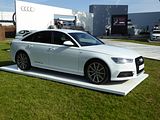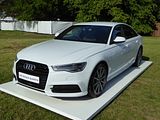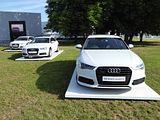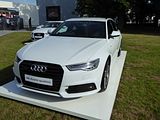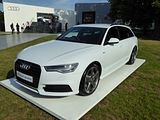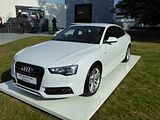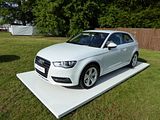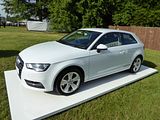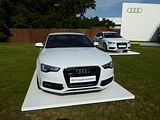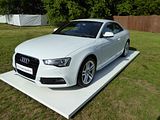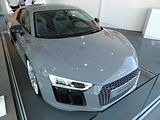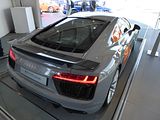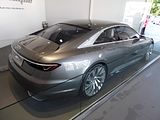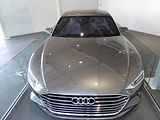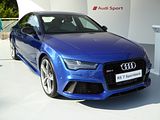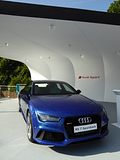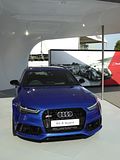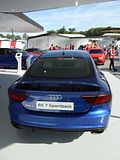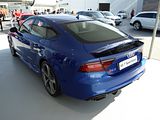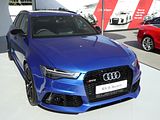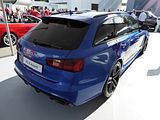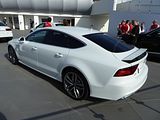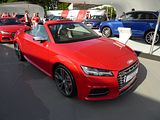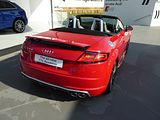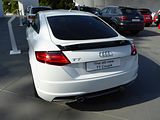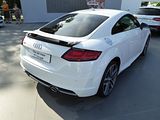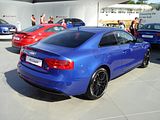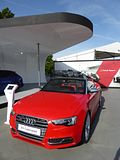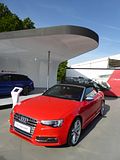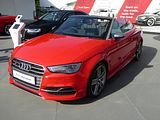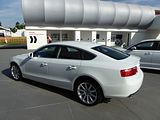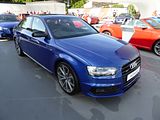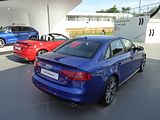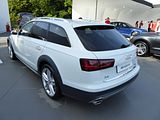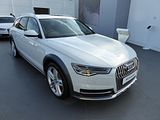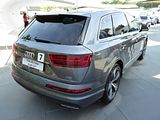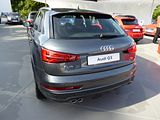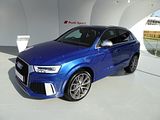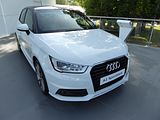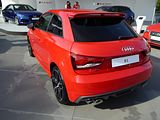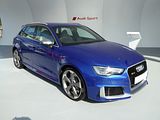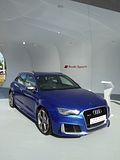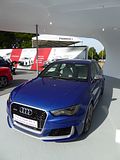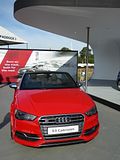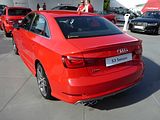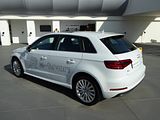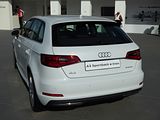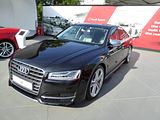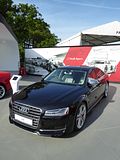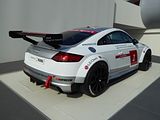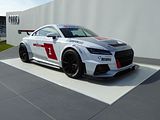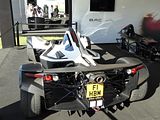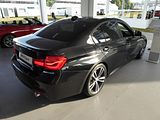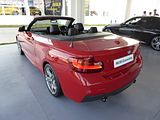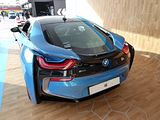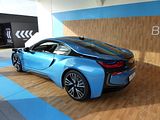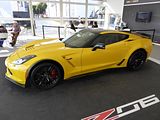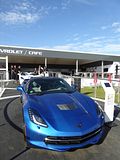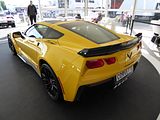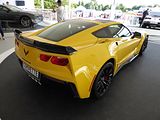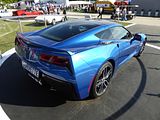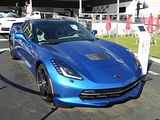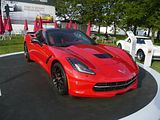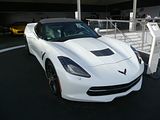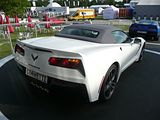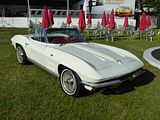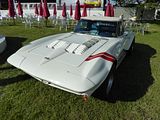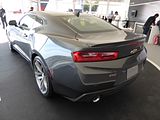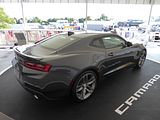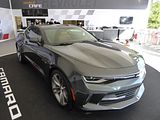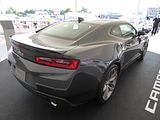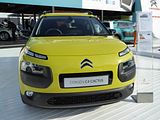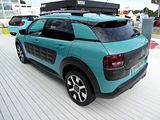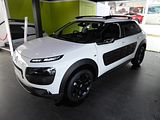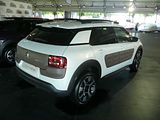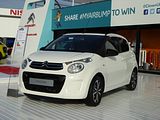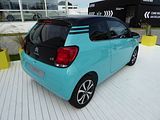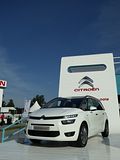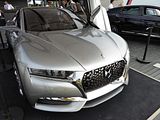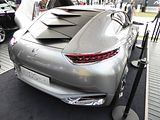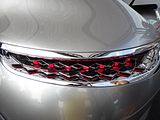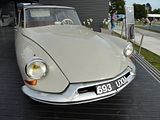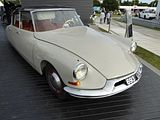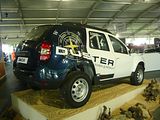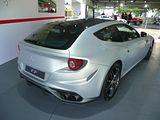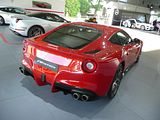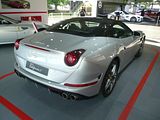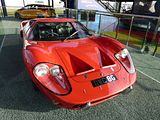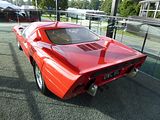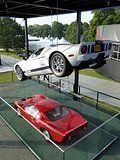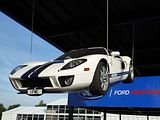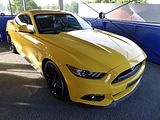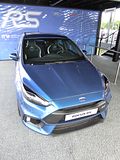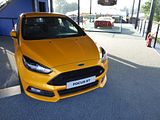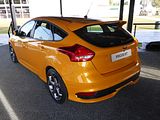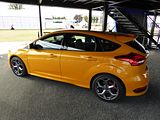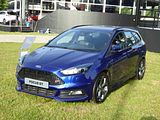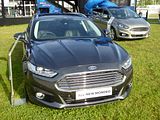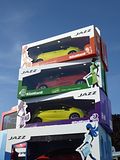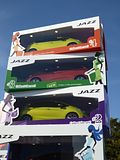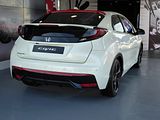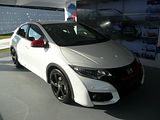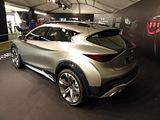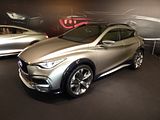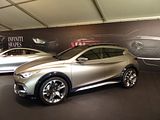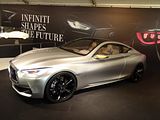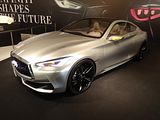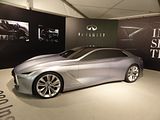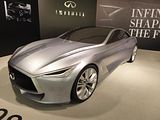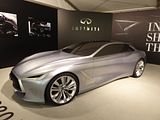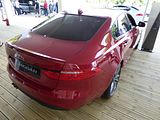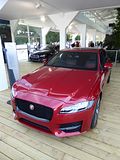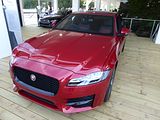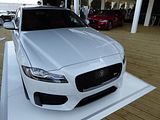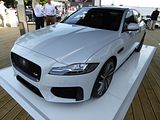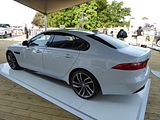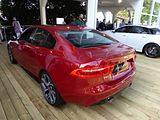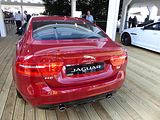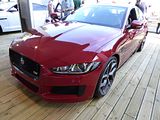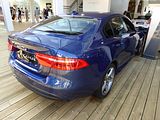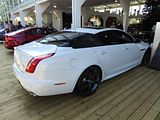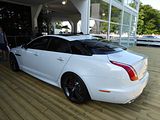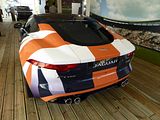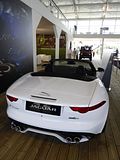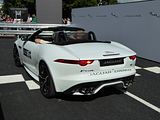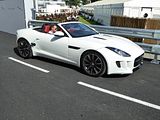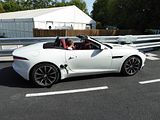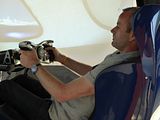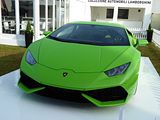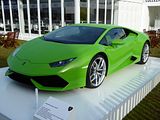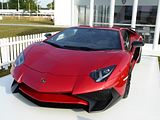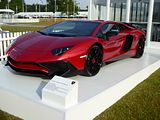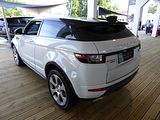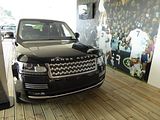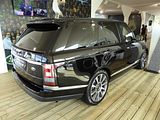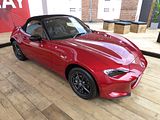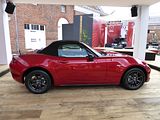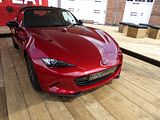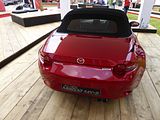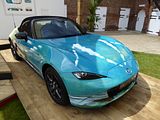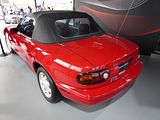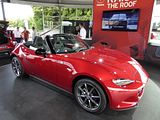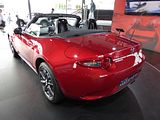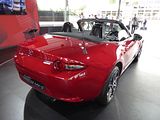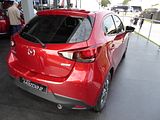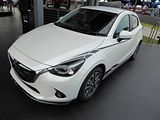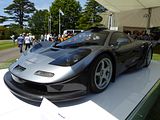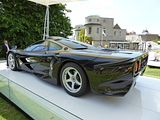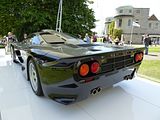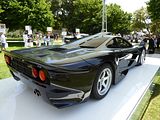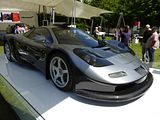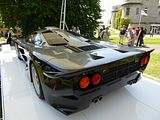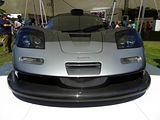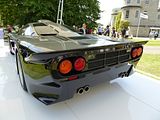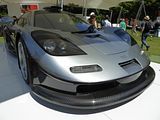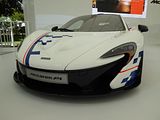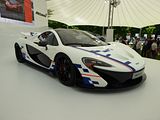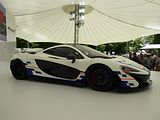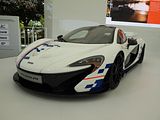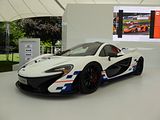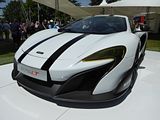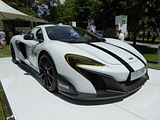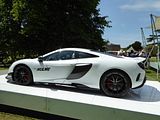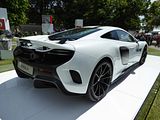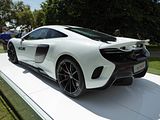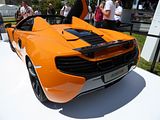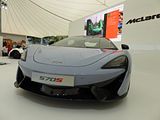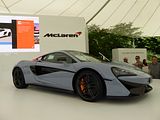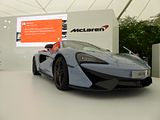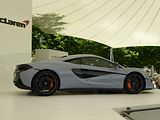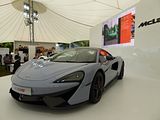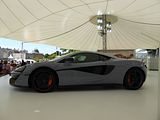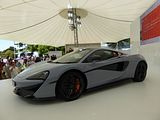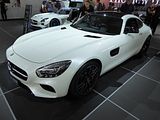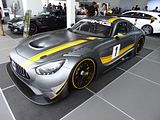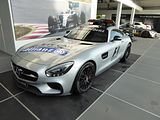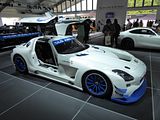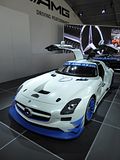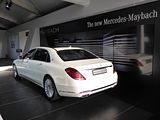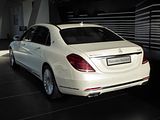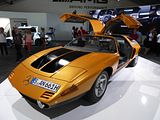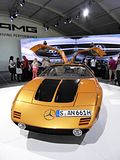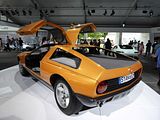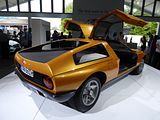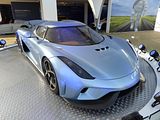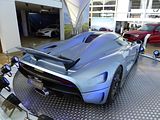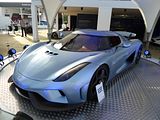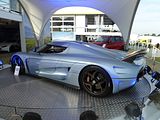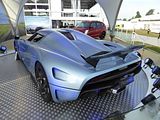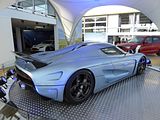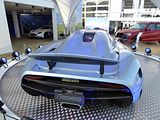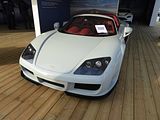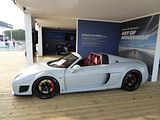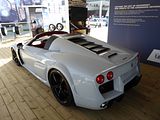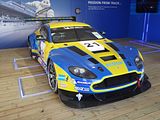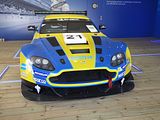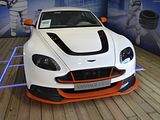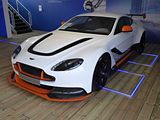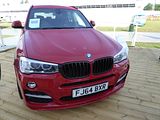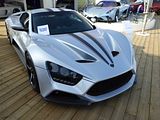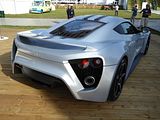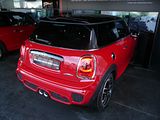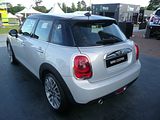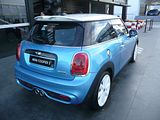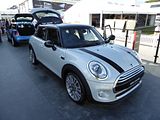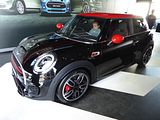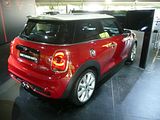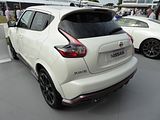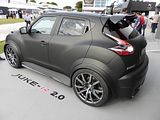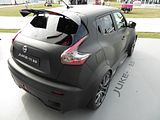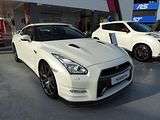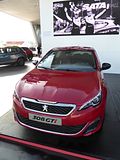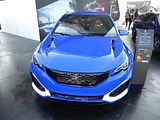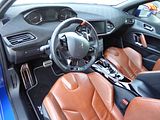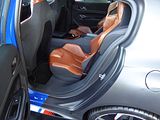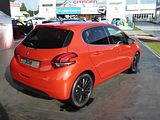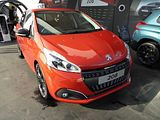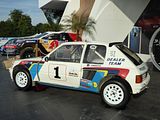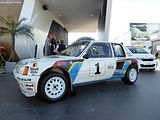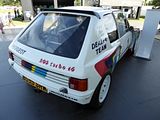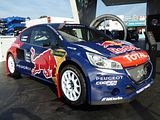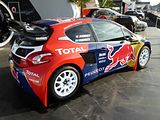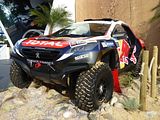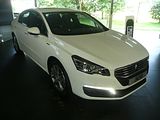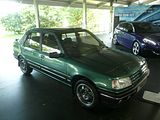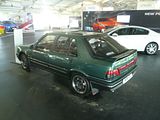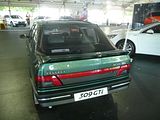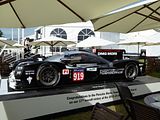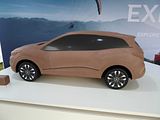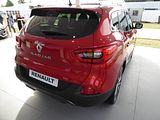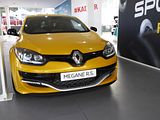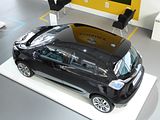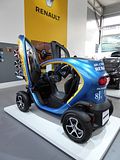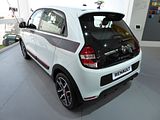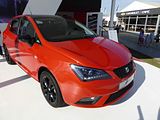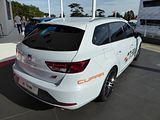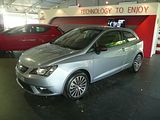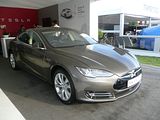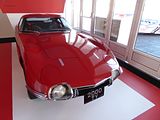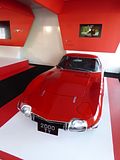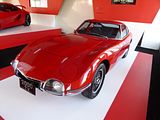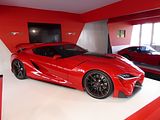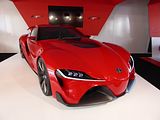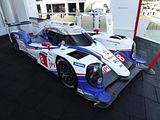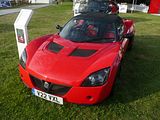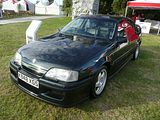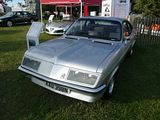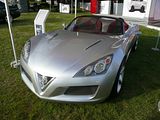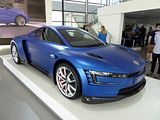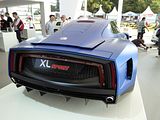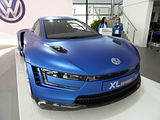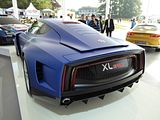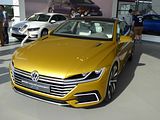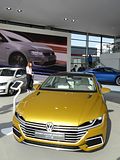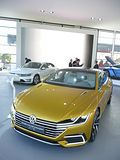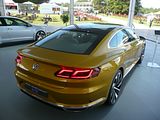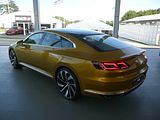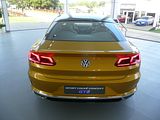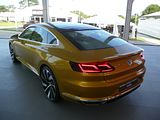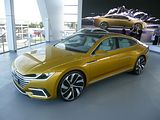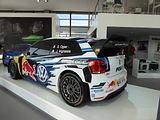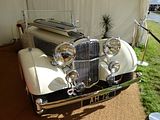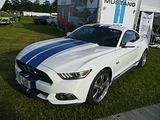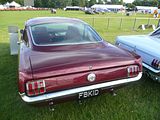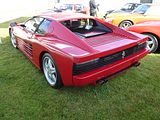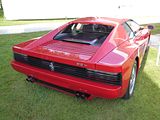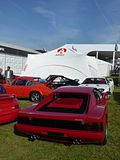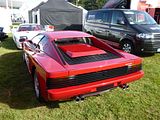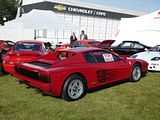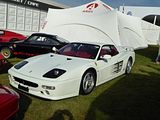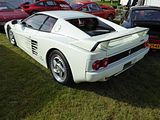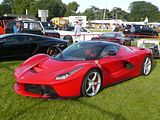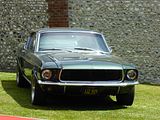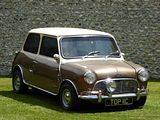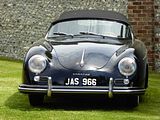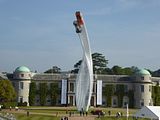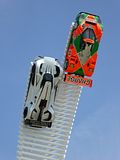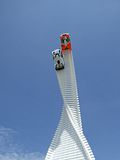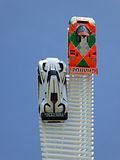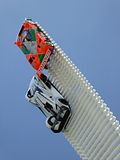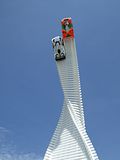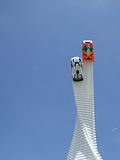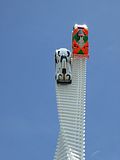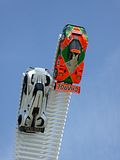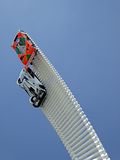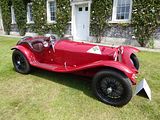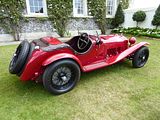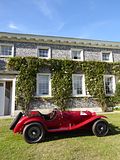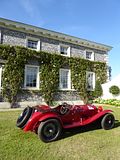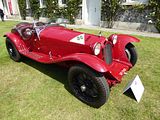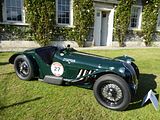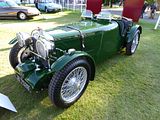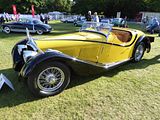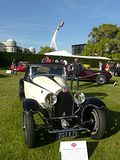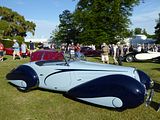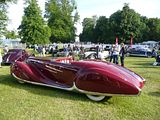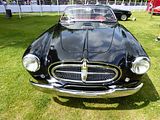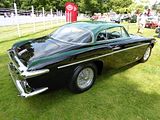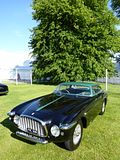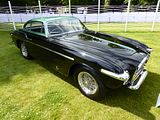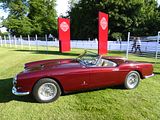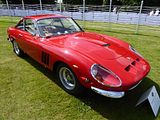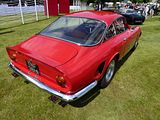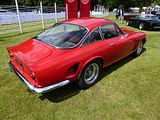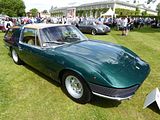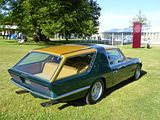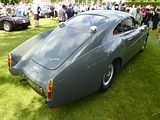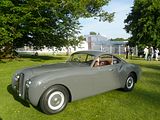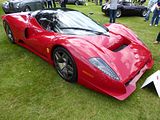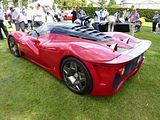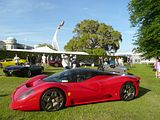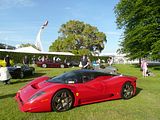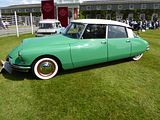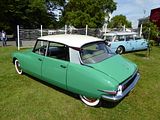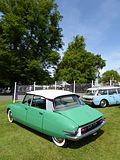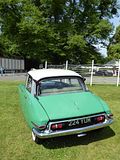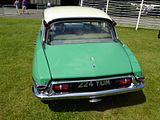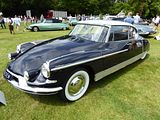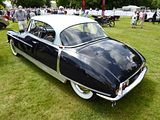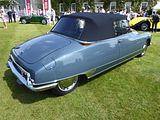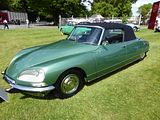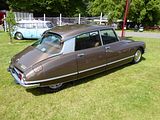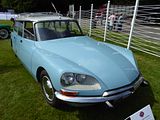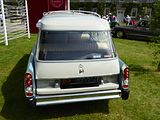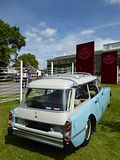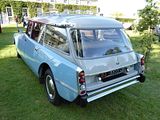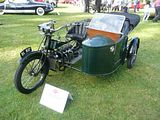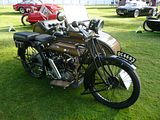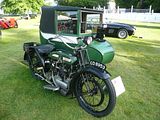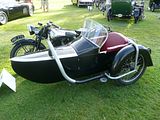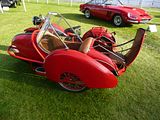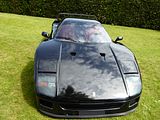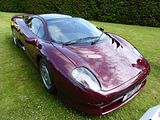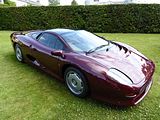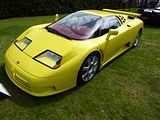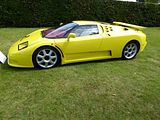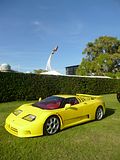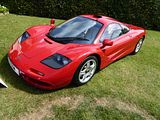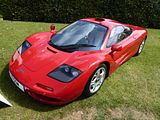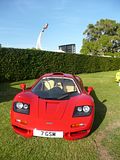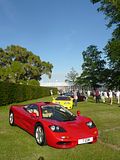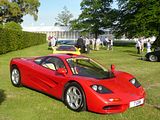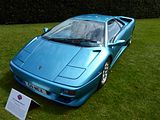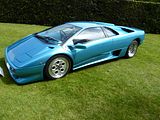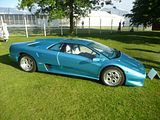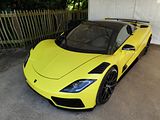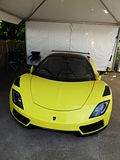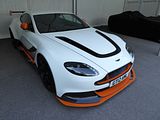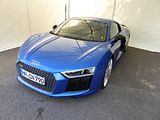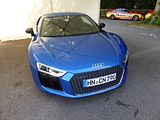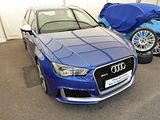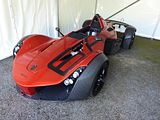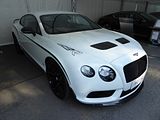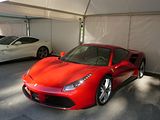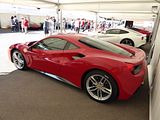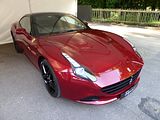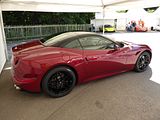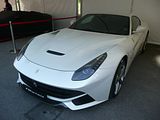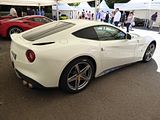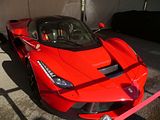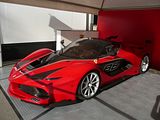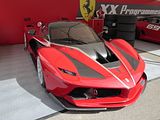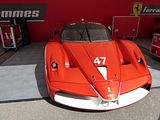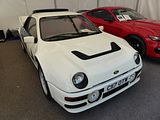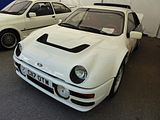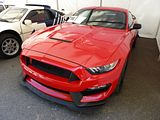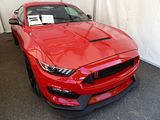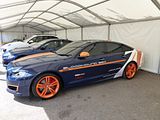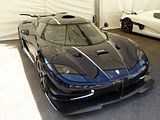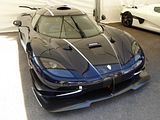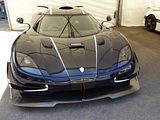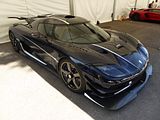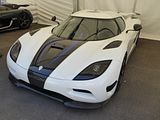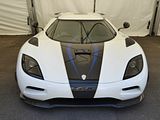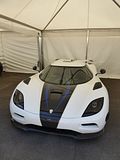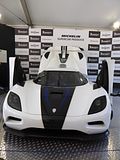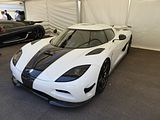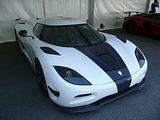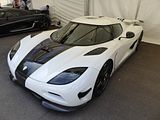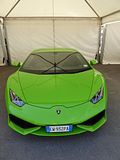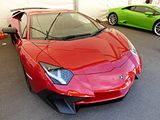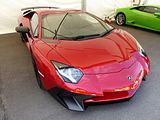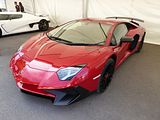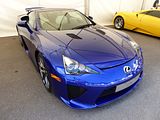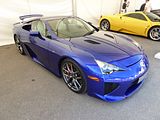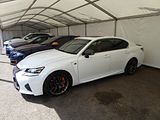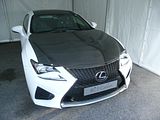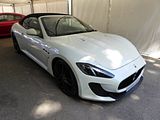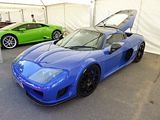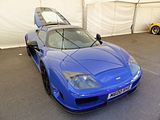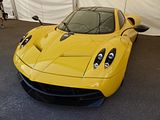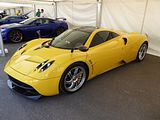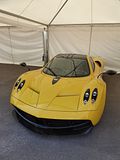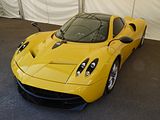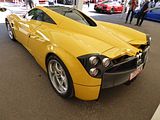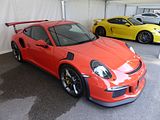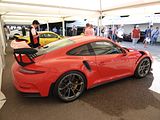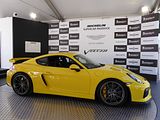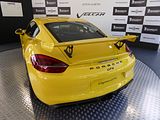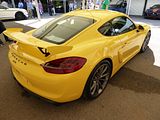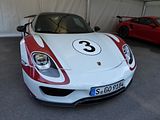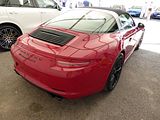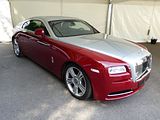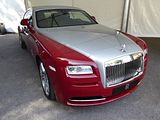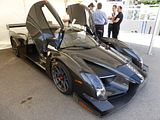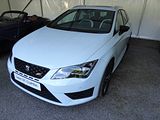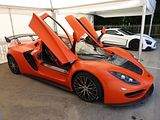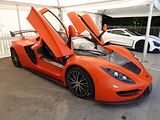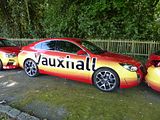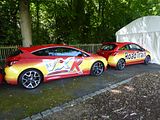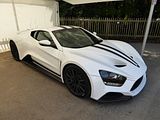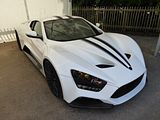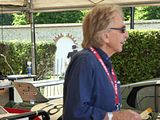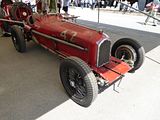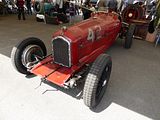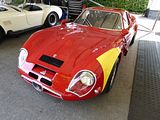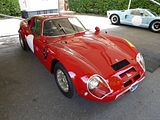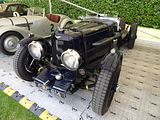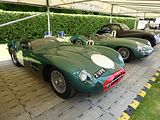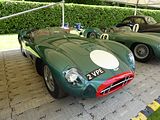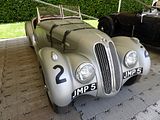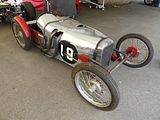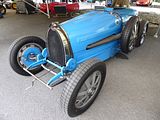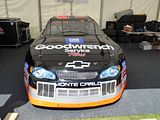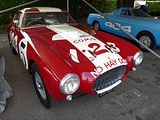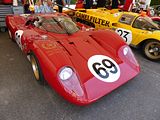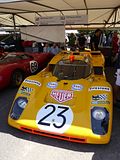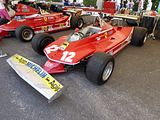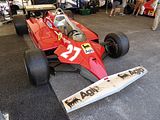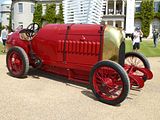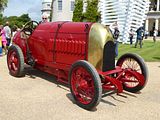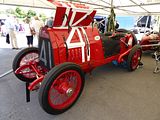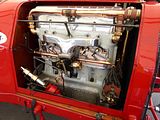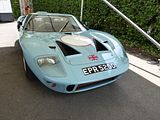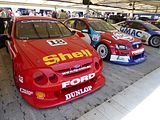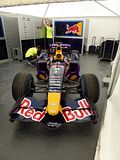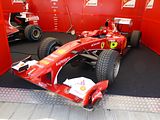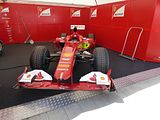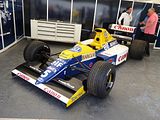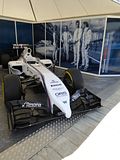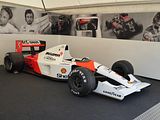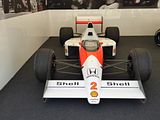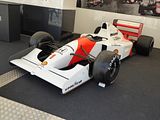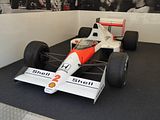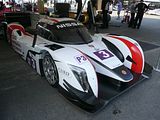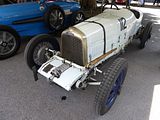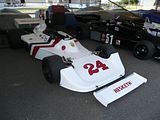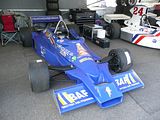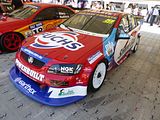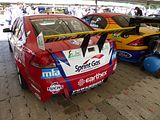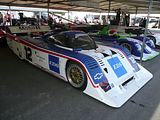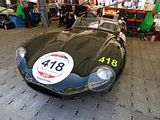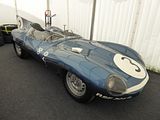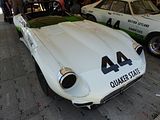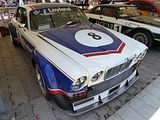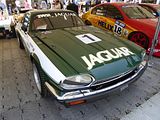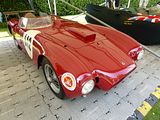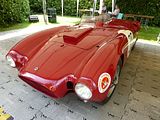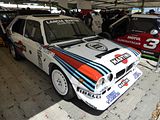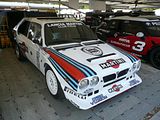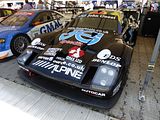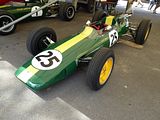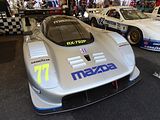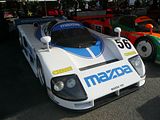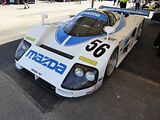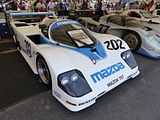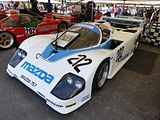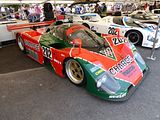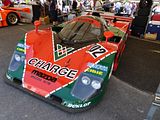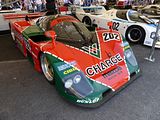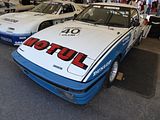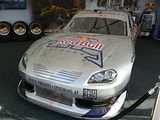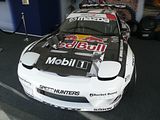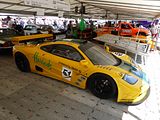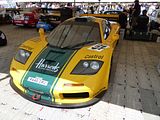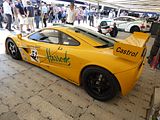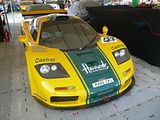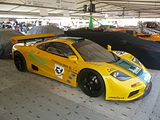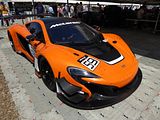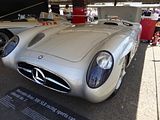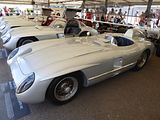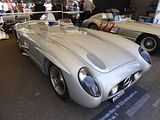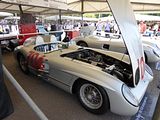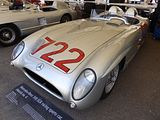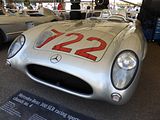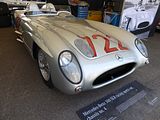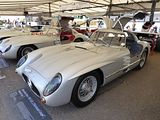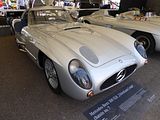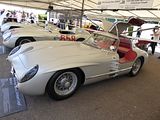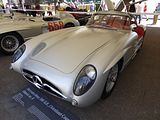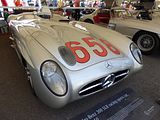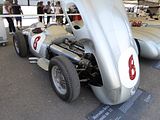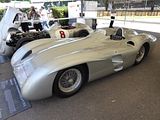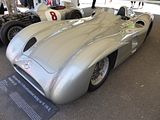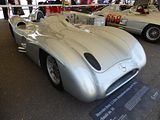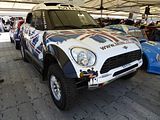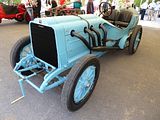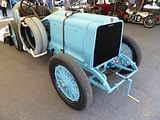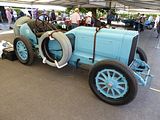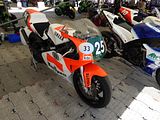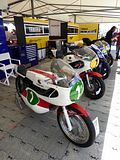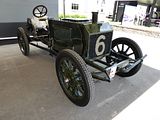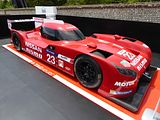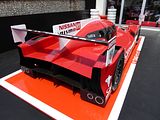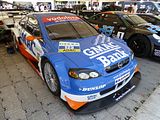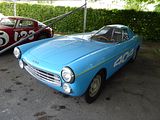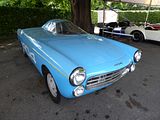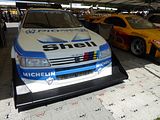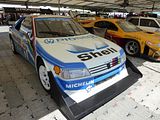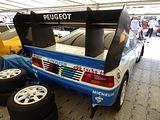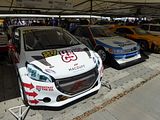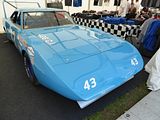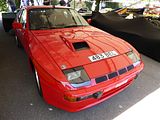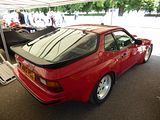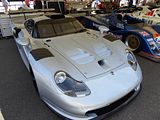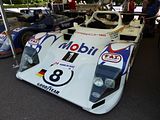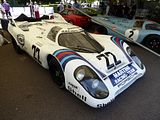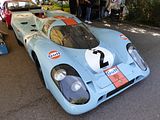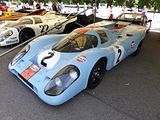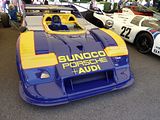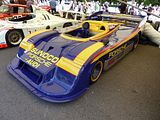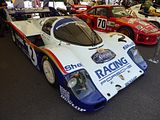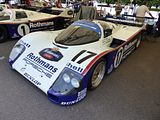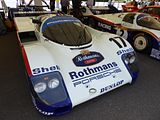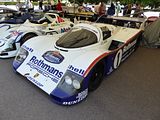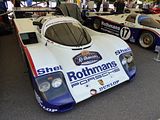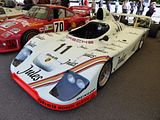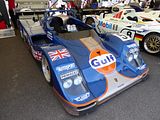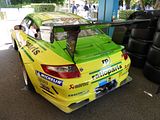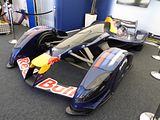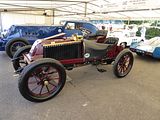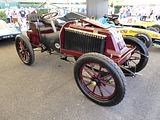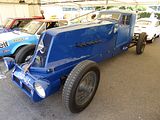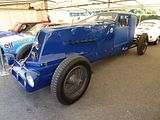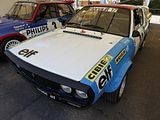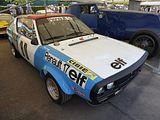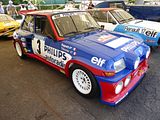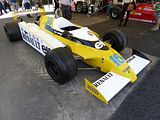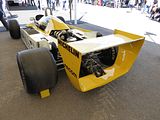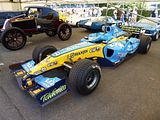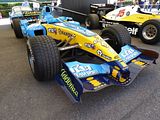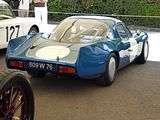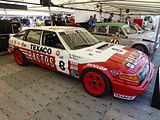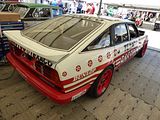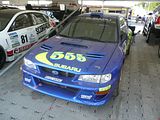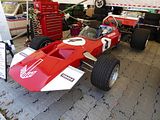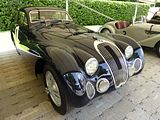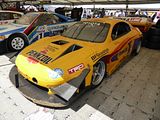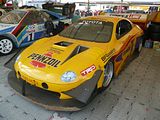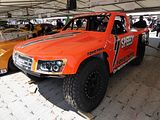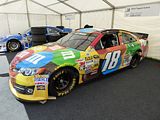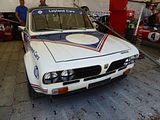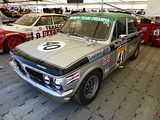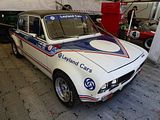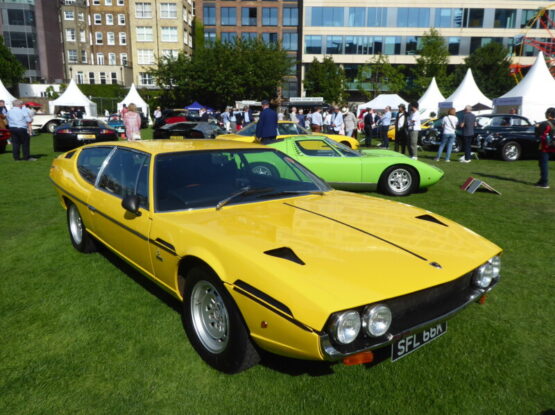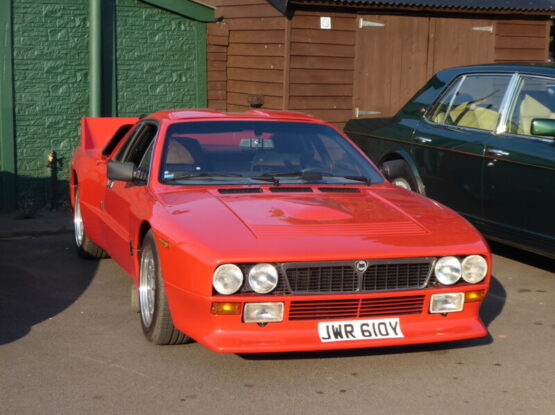Does the Goodwood Festival of Speed need any introduction? It’s been running since 1993, and from small and tentative beginnings, or so Lord March though would be the case when the gates were opened for the very first event, it has blossomed to become the biggest car event in the world, with over 200,000 visitors passing through the gates of the 4 day event. In a way, that is Great News, as it shows that enthusiasm for motor vehicles is as strong as ever, and indeed it has been estimated that this one event alone generates something like £25 million of revenue for the area within a 20 km radius, a further £35 million for the wider area and even a cool £8.5 million in VAT for HMRC’s coffers, but it also brings some challenges. Goodwood is located down a narrow country lane a couple of miles off the A27, a busy road even when this event is not taking place, so tales of traffic jams from people trying to get to the event and away from it are legendary, and with such huge numbers of people attending, once in this all-ticket event, it can be hard to see what you really want to get close to. Realising that three days is still not enough for everyone to get a good look, and spotting the opportunity created in 2009 when there was no national Motor Show any more, the organisers extended the event forwards a day, creating what was called the Moving Motor Show. Here the emphasis is on the new cars, with both static displays by many manufacturers and also the opportunity to take a short test drive up the hill in a number of models (if you are lucky enough to be able to book them). Most of the Festival of Speed content is in place, ready for the main three day weekend meeting as well, so there is also a chance to get see this, albeit as static exhibits rather than in action. The Moving Motor Show itself became very popular quite quickly, encouraged no doubt by the vast number of free tickets that were made available not just by the manufacturers and dealers present but also through other means. This latter was cut off in 2015, with no generally available free tickets that I, or anyone else could find, so whilst there were still discounted offers around, it did seem that this deterred some from attending, and my unscientific perception is that the event was not quite as busy as it had been in 2014 or 2013. It was certainly not the weather that put people off, as the day started sunny and remained that way all day long. One day is not really enough to get see everything, and if you are able to spend time behind the wheel of some of the demo cars, this will certainly eat into the opportunities of looking at everything else on show. I did not do any driving, and yet there are still areas of the event that I did not get to. There was lots I did see, of course, and my highlights from a great day out are presented in this report.
MANUFACTURER DISPLAYS and MOVING MOTOR SHOW
Thursday was the day of the Moving Motor Show, and with at least 18 of the major manufacturers present, as well as a number of other suppliers to the motor industry and specialist dealers, whilst was not as comprehensive as a full-on Motor Show, there was more than enough to occupy the full day, if you so chose. We did not, as there was plenty of other content we wanted to squeeze into the 12 hours or so on site, but this was what we started out with, believing that it would all be ready for the public as soon as the gates were open. That proved not to be the case. Mercedes-Benz, once again, were not letting anyone on their stand until 8:30, as they said that they had to clean it, which was odd as no-one had at that point been on it to get it grubby, and Honda took til mid-morning before they seemed to be ready to let anyone come and have a close up inspection of their cars. The manufacturer displays are split into two sections. The Moving Motor Show “proper” is housed in what is effectively like a very long and wide marquee that is almost the first thing you come to having entered through the main gate. Down its centre is a roadway, which is where those who have been lucky enough to get a slot to test a car out up the hill set off, and either side of this are a number of static displays of cars. In some cases these duplicate what is outside, but there are some brands whose only presence is in here. As in previous years, we figured that as this would be the first thing that many would get to on arriving, we would not start our day here, but would come back to it late in the day. The only hazard with this is that if you are very late – as we were – it has largely been closed down for the night and many of the cars are covered up, so we actually did not get to see that much of this part of the event. However, it is on the outdoor displays where the manufacturers clearly spend a lot of money. Most of them are arranged in a couple of long lines on the inside of the track, and many of the stands are large, elaborate, complex and multi-level. As well as the cars, several of them have all manner of additional features, which range from those dispensing free drinks (in some cases in an “owners only” area – remember to take as many key fobs as you can! – but with all manner of other things from competitions to a timed slide down a plastic shute (thanks, Ford!). It is clear that a lot of thought goes into how to engage the whole family, so whilst the petrol-head is the clear focus, there is lots for those who lose interest in just looking at cars. In the absence of a proper Motor Show in the UK, this is also a place that many manufacturers use to launch brand new models, and showcase concepts, which is why it is such a worthwhile part of the event.
AUDI
Audi had one of the biggest stands of them all. Right at one end of the long line of other manufacturers, I was hopeful that as well as having lots of cars to look at, and admire – which of course they did – there would also be an area serving drinks, as in previous years. And there was. Open only to owners, a quick flash of an Audi key was enough to enable me and the other TheMotor.net attendees to gain access and get our first respite of the day, with refreshing cold libations or cups of coffee. Audi had a completely new stand this year. As in the past, it was a massive construction, which would have taken a lot of people quite a long time to erect, with most of the cars on show on what looked like “upstairs”. There was a grandstand area at one end, which gave a good view of some of the test hill, and I have no doubt that for the rest of the weekend, this would have been packed. However, it was the cars that we came here to see, before that first morning drink. On the approach to the stairs which led up to the main display were six Audi models, all in white, three on each side of the main thoroughfare. All were quattro cars, marking 35 years since the creation of this iconic name, and all were familiar and established models from Audi’s vast range. Included among them were the A6 in Saloon and Avant guise, the A5 in Sportback and Coupe versions and an A3 hatchback.
Star of the stand for most people, me included, was the brand new R8 V10 Plus. First seen at the Geneva Show a few weeks earlier, the second generation of Audi’s supercar is a cautious evolution of the first. Only available with the V10 engine, in two power outputs, this is a Coupe for now, with an open-topped model due to follow in a few months time.
Also in a special covered display area was the Prologue Concept, one of a series of concept vehicles Audi has shown in the past year or so. The Audi Prologue concept car closely previews the look of the next-generation A8, A7 and A6 models, due in production form from 2017, and the concept is said to resemble the upcoming Audi A9, a plush new flagship coupé planned to be launched in 2016 as a rival to the likes of the Mercedes-Benz S-class coupé. Because the production cars were designed first and then their essence was distilled into this concept, the Prologue shows the exterior styling, advanced interior features, powertrain technology and various chassis developments set to be adopted by Audi’s next generation of high end production models. The Prologue gets a heavily reworked single-frame grille that is significantly wider than that used on existing Audi models. Also included are slimline matrix laser beam headlights housing five individual lenses that provide adaptive functions, including automatic high-beam dipping when oncoming traffic is detected. With an aluminium and high-strength steel body, the concept is 40mm shorter and 70mm lower than the current A8, with official figures of 5100mm and 1390mm respectively, and is the same width at 1950mm. It also sits on a wheelbase that is 50mm shorter than the A8’s, at 2940mm, and gets 22-inch wheels. Promising us greater visual differentiation in future Audi models, every element on this car will be seen in some of the future models. Whether any of them will get the twin-turbocharged 4.0-litre V8 engine developing the full 597bhp that features on this car is less clear, though. There’s 516lb ft of torque – or 553lb ft in overboost mode during short bursts of full-throttle action, so with drive channelled through an eight-speed automatic gearbox and Torsen four-wheel drive system, this provides the Prologue with a theoretical 0-62mph time of just 3.7sec, according to Audi’s own computer simulations. As well as using a cylinder-on-demand arrangement that shuts off four of the eight cylinders on light throttle loads for added fuel efficiency, the engine also uses a 48-volt electrical system that should be adopted on the next A8 as part of a new raft of fuel-saving initiatives. The Prologue is claimed to return 32.8mpg, giving it a CO2 emissions figure of 199g/km. The Prologue also provides clues to the advanced chassis ready to be adopted by the new A8 and its more sporting A9 sibling; it uses a new five-link suspension with adaptive air springs capable of varying the ride height. Inside, the dash incorporates a full-width instrument panel featuring an OLED display that enables digital interaction between the driver and front seat passenger.
If the budget would stretch to both the significant purchase price and the fuel and running costs, either of these models would suit me perfectly: the RS7 and RS6 Avant are very similar under the skin, both sporting the potent 552 bhp twin turbo 4 litre V8 engine under the bonnet and combined with quattro all-wheel drive. You do see the RS6 Avant model on our roads from time to time, but the RS7, an elegant five door hatch is a much rarer machine. It sits in a sort of market niche almost by itself, with no obvious rival from BMW or Mercedes-AMG, who have saloon and in AMG’s case, estate bodystyles to compete. Which you would prefer would largely come down to personal taste.
The “regular” A7 was here, too. This is very much a niche model, with monthly sales even in its native Germany a tiny fraction of those of the A6 on which it is based. I am surprised, as I rather thought that the concept of the executive 5 door hatch when delivered by something a lot more stylish than BMW’s awkward looking 5GT would find more favour, but there is quite a hefty price premium for an A7 over an equivalent A6 and this may be the deterrent. It is, to my eyes, an elegant car, and it comes with the beautifully finished interior that epitomises every Audi from the smallest and cheapest to the most costly.
Also shown was an A6 in efficiency-optimised TDi Ultra guise. Far from the tedious economy special that you might fear, this may be the cheapest model in the UK’s A6 range, but you still get a 187 bhp diesel engine coupled to a 7 speed DSG gearbox and the beautifully finished Audi interior. It might not the a thrilling drive, but it would waft you back and forth on the motorway with incredible parsimony for such a large car.
The third generation TT Roadster joined the Coupe model in the UK a few weeks ago, and we can now expect Audi gradually to add more powerful models as they populate the range. For now, the TT-S is top dog, but an RS version is under development for launch probably in 2016. Both bodystyles were represented here.
From its 2007 launch as the Coupe version of the A4, the 5 has developed into a range of three body styles: Coupe, Cabriolet and Sportback, and there were examples of each on show here. A new A4 is waiting in the wings, due for release imminently, and it is a dead cert that there will be next generations of all these models, a few months after that, but for now, the established and very elegant A5 and S5 range continues, and remains popular among buyers. Unlike the A7 which is a slow seller, the A5 Sportback proved very popular and caused BMW to respond with the ungainly 3GT and the more closely equivalent 4 Gran Coupe. The UK press will always default to the BMW as the car of choice in this sector, but the German press, and I, find these models more to their taste. To my eyes, they win on looks as well, with the S5 Cabrio looking far better resolved than the rather bulbous new 4 Series Convertible.
With the launch of the new B9 generation A4 just days away, and the car due on sale in the UK in the autumn, this is likely to be one of the last major UK show outings for the B8 generation model. It is hard to believe that it is nearly 8 years since it was launched, as the car still looks fresh, and thanks to a program of updates to the engines, is still very competitive both on the road and financially.
Audi have offered “soft roaders”, or Allroad in their speak, versions of the A6 for many years now and an A4 version was introduced a few years back. These models are popular, proving that it is the looks and a modest improvement in ground clearance and off-road ability that people really want as opposed to going the full SUV way. Both were on display here.
Audi do of course have a range of SUV/Crossover type vehicles, with three distinct models in the range for now, and more believed to be under development. Brand new here was the second generation Q7 which is just going on sale. Physically a little smaller, and noticeably lighter than its predecessor, this car certainly does look a lot less bulky and all the better for that, though whether the buyers agree remains to be seen, as this end of the SUV market does seem to favour an element of bold, brash and crass as well as sheer physical space.
Joining it on show were example of the smaller Q5 and the baby of the off-road range, the Q3 also seen in RS Q3 guise.
Real baby of Audi’s range, of course, is the small A1 hatchback. A success that has yet to be rivalled by either BMW or Mercedes, the model has just receive its mid-term facelift with some subtle visual tweaks going with the latest updates to increase the efficiency and reduce the emissions of the engines. As well as the regular A1 hatches, the potent S1 was also on show.
Above the A1 comes the A3, and there were lots of these, showing the diverse and huge range of models which constitute what is one of Audi’s most important model and biggest selling ranges. Top of the tree is the RS3 Sportback, a car whose launch has caused rival Mercedes to up the power of their rival A45 AMG just to regain bragging rights, and this ultra sporting model contrasts with the economy focused A3 Ultra and hybrid-powered e-Tron models which were also on show, as were the more recent body styles of Saloon and Cabriolet, both seen here in S3 guise.
Final Audi on the stand was the S8, top saloon car model in the range, which has a 513 bhp version of the 4 litre twin turbo V8 that is seen in other models, to give it a 0 – 60 time of just 4.2 seconds, belying the fact that this looks like quite an innocuous and rather elegant luxury saloon car. A more S8 Plus is new for 2015, should this not be quite fast enough!
Displayed on the other perimeter of the stand, and only visible once you’d left Audi’s massive construction was this racing TT from the Audi Sport TT Cup series.
BAC
BAC, or more formally, the Briggs Automotive Company, is a British sports car manufacturing company based in Speke, Liverpool, founded in 2009 by brothers Neill and Ian Briggs to produce specialist sports cars targeted at enthusiasts. The company’s first – and so far, only – vehicle is the Mono, a single seater road-legal sports car. Conceived with the objective of creating a pure driving experience with a central-seat format, it was launched in 2011, the result of a team effort with engineers from Cosworth, Hewland, Sachs, AP and Kumho Tyres all partnered with designers at BAC. The Mono uses carbon fibre composite construction over a steel chassis (with FIA compliant rollover structure) inspired by the construction principles employed in DTM race cars. The nose of the vehicle provides a storage compartment and doubles as impact protection. The Mono is powered by a 2.3-litre four-cylinder Cosworth engine producing 285 bhp and 206 lb·ft a heavily modified Ford Duratec The engine is mounted longitudinally to maintain the centralised balance of the car. The car runs a F3-specification six-speed sequential gearbox developed by Hewland. This gearbox operates a semi-automatic transmission tuned to complete gear shifts in 35 milliseconds. These specifications result in a 0–62 mph time of 2.8 seconds and a top speed of 170 mph. Weight-distribution in the Mono is focused on maintaining a low centre of gravity. The system includes a fully adjustable pushrod suspension system with damping elements made by SACHS Racing. AP Racing developed the retardation and stopping ability of the car. The Mono runs on specifically designed Kumho V70A road tyres. During production, each vehicle is custom-built around the purchaser’s body shape. The size of the seat, pedal reach and steering wheel position are modified in order to suit the individual’s ergonomic requirements. The Mono ran 1:14.3 at the Top Gear test track. This makes it the one of the fastest cars to go around the Top Gear track on road legal tyres. In late 2012, the BAC Mono was featured in Need for Speed: Most Wanted. The BAC Mono also appeared in GRID 2, Driveclub in 2014, and Project CARS and Forza Motorsport 6 in 2015. The car is not cheap, but it is beautifully built. Not surprisingly, it remains exclusive, with around 22 having been built and so far.
BMW
The BMW stand was in among all the other manufacturers, and although sizeable, it was not as large as the Audi one, which meant that even with the cars displayed closer together than those of the Ingolstadt rival, there was only space for a representative sample from the Munich firm’s vast, and ever growing range. Not surprisingly, the focus here was on cars that were either new or at the most sporting points in their respective range. Making its UK debut was the facelifted 3 Series range. Visually, you need to look long and hard to spot the differences, although in fact the list of things that have been altered even in this regard is longer than you might expect, with changes to the lights, bumpers, grilles and the like. Little looks any different. But when you spot an unfamiliar badge on the back, 340i, you know that there are likely to be alterations under the skin. And so there are. Don’t be fooled into thinking that a 340 might have a 4 litre engine under bonnet, as it does not. BMW long gave up using the actual engine capacity in many of their model names, and this car does indeed sport the 3 litre in-line 6 that was in the predecessor 335i model, but suitably updated. UK and European fiscal regimes are such that it is destined to be a rare sighting, with the vast majority of sales surely going to come from the bottom end of the range, but those who can look past the tax burden of such a car are unlikely to be disappointed by it.
If a 340i M-Sport is not potent enough, then you can always go for the full-on M experience, and the latest M3 and indeed closely related M4 Coupe models were on show here, and both were attracting lots of interest. The motoring press seem to have been slightly disappointed by these cars, even if objectively they are doubtless the best M3 model yet from the near 30 year history of the legendary moniker. I’ve not driven one (yet), but if it is anything like its predecessor, and apart from the sound track of V8 being substituted for a rorty 6, there is every reason to expect it would be, then it will surely be a fantastic car to own.
The 1 series underwent a facelift a few months back, too. It is debatable whether the changes to the front and back have actually improved matters much or simply made them different. There can be no denying that the M135i version, though, remains something of a bargain, with an amazing engine squeezed under the bonnet of BMW’s C-segment premium hatch, to give it the performance and driving characteristics to shame many a car with a much higher price tag.
Also with M badges on it, but not a full blown M car (that’s reportedly still coming) are the 2 Series models, as exemplified by this M235i Convertible.
Sitting on one corner of the stand was the new X6M. Recently launched in the UK along with the closely related X5M model, this is BMW’s second generation of the M car philosophy applied to the Crossover/SUV sector. Anathema to the purists, perhaps, but it has proved popular with the people who actually pay real money for their cars. And pay a lot of money for one of these you certainly will, as by the time you’ve ticked a couple of options, you are going to see a list price of £100,000. That makes this something of an indulgence, by anyone’s standards, but it seems that, just as there proved to be a surprisingly large market for the regular X6 – over a quarter of a million of the first generation model were bought – so there are those who want enormous levels of performance (that they probably won’t ever use) in a large (and to my eyes extremely vulgar!) vehicle whose space and other attributes they barely use either.
If I was going to spend that amount of money on a BMW, then I would be far more likely to want one of the remaining duo of cars seen on the stand. Though I certainly would not want an M6 in the bright orange colour of this one. Orange is a great colour for a Lamborghini, or a Seat Ibiza, but on a car of this size and shape, whilst certainly distinctive, it really does not – in my opinion – work at all. But the look beyond the bold paintwork, and as I found out by driving a regular 650i Gran Coupe, this is a fantastic car, and one that, assuming you could afford it, you would love in every respect.
A similar amount of money would also get you an i8, the futuristic looking supercar that has just a 1.5 litre 3 cylinder engine (and a lot of clever battery technology, of course) to power it. This has been a surprise hit for BMW, with the order book stretching out well into 2017, proving that it is not electric or hybrid per se which puts a number of customers off, but the car in which the technology is delivered. Whilst few enthusiasts would ever covet a Prius -and spy pictures of the next generation one suggest that even fewer of us are going to condone the car in future – if you produce something like this, you will have a longer line of buyers than you can cope with!
CHEVROLET
Although GM pulled the majority of the Chevrolet models that had been available in Europe, in favour of the locally designed and produced Vauxhall/Opel models, the “bow tie” brand has not completely disappeared, as if you still want one of the performance models, they are available to order through the one remaining dealer. You will get a left hand drive car, but that’s unlikely to be a particular deterrent for someone who wants something as specialised as a Corvette C7. Several examples of the latest C7 cars were on show here, including the more potent ZO6 cars.
Joining the new Corvettes were a couple of much older cars, a C2 Corvette Stingray Convertible and an earlier Mako Shark concept which previewed some of the look of the C2 car.
I was surprised – in a pleasant way – to see the all new Camaro here. Only just released in America, this eagerly awaited refresh of the car which battles hard against Ford’s Mustang is based on a new Alpha platform, which means it is slightly smaller and quite a bit lighter than the outgoing car. The overall styling appears to have changed little, though when you look at it in detail, you realise that it is more distinct from the old car than you first thought!
CITROEN and DS
Citroen is currently going through a process of separating out the DS models and creating a stand-alone brand for them, in the hope that DS can do for them what Lexus does for Toyota and Infiniti for Nissan, albeit at a slightly more affordable set of price points in the market. That separation is still “work in progress”, so there was a mix of both Citroen and DS models on the same stand here. It was a large stand, but unless you count the recent facelift to the top model in the DS range the DS5 as “new”, then everything on it was familiar, unlike last year where two of the models were making their UK debut. Those two are now well established, and one of them at least – the one that appeals to me, though I am told that it might not were I actually to drive one, sadly – is becoming quite a common sight on our roads. That car is the C4 Cactus, a bold and different looking mid-sized hatch that eschews the trend for ever longer lists of heavy and costly equipment that few people really want or use, despite what they might like to think, for a “back to basics” approach. With a range of bright colours (also something of a rarity in a world of 50 shades of grey!), the result is distinctive, characterful and a return to what so distinguished Citroen as a maker of something different, until the last 20 years when Euro-conformity has ruled.
The second one-year old is far more conventional: the C1 city car. I was not particularly impressed by it in 2014 and 12 months has not made me look at it any more favourably. This car, and its Peugeot and Toyota brothers and sisters strikes me as a rather poor attempt to recreate the levels of interest that the first generation of the trio achieved in 2005 when they largely had the market to themselves. I suspect that no-one really looked at the rivals – the VW Group trio, and the Hyundai/Kia pair, to see what they would have to beat, as despite the fact that the C1/108/Aygo 2 came some years after their rivals, they fail to better them in any significant regard. There were several of them on show here to prove the point in case I were in any doubt.
Rather more competitive in the market is the C4 Grand Picasso, the longer and hence more commodious of the duo of mid-sized people carrier models that Citroen offers. Restyled in 2013, these cars are not exciting, but they are practical, and they even look that bit interesting, with their unusual light arrangements at the front.
Said to give plenty of clues as to the future direction that the standalone DS brand will take with its new cars, the Divine Concept made its public debut at the 2014 Paris Show. Described as having “avant garde design” and “visible technologies, refinement and a balance between comfort and dynamics,” by DS boss Yves Bonnefont, the car is intended to signal the future brand and design direction of DS rather than preview any specific new model. Perhaps unexpectedly, its basic concept is the straightforward C-segment hatchback. “It’s the most important segment,” said exterior designer Frederick Subirou, adding that the Divine DS’s “muscular, sinewy and voluptuous surfaces, punctuated by sharp, sweeping lines” describe the sculptural direction the company is heading in. Important style elements on the concept include the lack of a rear window, a series of sharp-edged geometric shapes instead characterising the rear-end of the model. DS officials say they’re “serious” about a car with a windowless rear. In the Divine DS a rear-view camera substitutes, with its image projected onto a rear-view mirror-shaped screen found in the usual place. The rear window and interior mirror are examples of the benefits of designing the exterior and interior of this concept simultaneously, according to exterior design leader Bertrand Dantec, because the technology providing the panoramic digital rear-view mirror allows for the lack of rear window. Surprisingly, though, conventional door mirrors remain. Ignore the scissor and coach door arrangements – they are pure show car, with no production intent. That the grille seems a little conventional in its shape is driven by the need for internationally recognised canons of design, apparently. The nose that will adorn the cars of the new DS brand needs to be as acceptable in China, where the brand is growing fast, as it is in Europe. The French manufacturer partnered with jeweller Swarovski and embroidery company Lesage to create the luxurious cabin. Inside, DS is suggesting three styles of interior finish, called Male, Parisienne Chic and Fatale Punk. Parisienne Chic, with its embroidered door panels, pleated silk and rich leather intended to evoke the haute couture world. Male is about carbonfibre, while Fatale Punk features quilted, jewellery studded leather and a shimmering Swarovski Crystal fabric. The dashboard and centre console take the same highly sculpted theme used in the Citroën DS5 a dramatic stage further with its sweeping forms and asymmetric design. The Divine DS is front-wheel drive and is powered by a turbocharged direct-injection 1.6 THP petrol engine developing 267bhp at 6000rpm and maximum torque of 243lb ft between 1900 and 5500rpm. The engine emits 145g/km of CO2.
Examples of the DS models you can buy right now were also on the stand. These included the DS4 and recently facelifted DS5 which sports a new nose and revised suspension which it is claimed will improve the rather choppy ride of the first models.
Far more to everyone’s taste, I suspect, was this early example of the classic DS19 model.
DACIA
Romanian brand Dacia had a number of models on show inside, with the Duster and Logan MCW being the two which I captured on camera.
FERRARI
Ferrari did not have an outside stand, but they did have an area at one end of the Moving Motor Show display area, and there I found three cars from the current range: FF, F12 Berlinetta and the recently released California T
FORD
Ford was the first stand on which I spent significant time, as I knew it would likely get very busy later in the day, as there were several cars on here which would surely be real crowd pullers. And so they proved to be. Whilst there were a handful of what you might call the “volume selling” models on display, it was not really those that I, or likely anyone else really wanted to see, which is why, wisely, Ford had used the space on their multi-level stand to house the far more special models. And what can be more special than a display that contains three generations of the line that started in 1966 with the GT40? Excuse – not that any is really needed – for showing the older models, I guess, is to show the clear lineage between them and the very latest concept GT, the car that was a complete surprise back in January at the 2015 North American International Auto Show in Detroit and which has been wowing everyone everywhere it has been seen since. Sadly, here it was in an enclosed glass case, so whilst you could get a good view from all sides and indeed above it, it completely defied any possibility of photography of the whole car, which was something of a shame. There were no such problems in getting pictures of the earlier cars, though. An example of the GT model that was sold between 2004 and 2006 was suspended by four steel cables from the structure under the new concept model, and the classic GT40 was then to be found on the stand beneath that. The GT40 seen here was a Mark 3 version, a very rare car, that belongs to Ford UK, and which is loaned out to special events from time to time.
It feels like we’ve been waiting a very long time for the first ever right hand drive Mustangs, and indeed, if you recall that the car was first shown in December 2013, then we have been. And by all accounts we are going to be waiting quite a it longer. Whilst US sales are now well underway, and indeed, I’ve driven one of the latest V6 Convertible models on my last trip back in March, European spec cars will not be rolling off the production lines til around September/October, and the right hand drive cars are likely to come even later than that. To remind everyone what they are waiting for, one of the V8 engined 5.0 litre GT cars was on the stand, still as a left hooker. It will be fascinating to see what sustainable demand there is for this car. The purchase price is a bargain, for the performance, but the running costs even in the era of cheaper petrol which we may be enjoying for some time to come, are going to be rather ruinous, and that could well put people off once the initial demand is satisfied. We shall see.
A little cheaper to buy, and certainly smaller on the outside, but with more space for people and luggage is the new Focus RS, another eagerly awaited model. I first saw this at the Geneva Show back in March. and have to sat that the looks were a bit too, well, boy-racer, for me, but then, the last Focus RS model was hardly subtle to look at. either. It’s going to be next spring before you can get behind the wheel of your own example, which is also going to seem like an eternity to those who are attracted by the very attractive pricing, which undercuts the rather sober-looking Golf R by a couple of thousand £, and the German uber-hatches by around £10,000.
That brings us to the cars that you can buy now, starting with a still somewhat potent models. Ford facelifted the Focus at the start of the year and the revisions included the ST model which suddenly blossomed into more of a range within a range, as rather than there just being a single 5 door hatch and one engine, you can now have petrol or diesel power and the option of an estate version. Both body styles and engines were shown here.
We had a very long wait for the new Mondeo, which in transatlantic Fusion guise had also gone on sale a couple of years ago, but finally the new model reached our shores, also early this year, and one of these neatly styled, but now larger than ever models was on show. Long day are the days when this car is near the top of the sales charts, as the market has moved on to either smaller cars (and the Mondeo is now a very big car indeed) or those with premium badges, so this is not destined to be the common sight that its predecessors were, but by all accounts, it is still a supremely competent machine.
That is true for the second generation S-Max which is just arriving in showrooms about now. You may need to stare long and hard to convince yourself you are looking at a new one and not the facelifted version of the old one, as the cars look very similar, but under the skin, the new one, and the closely related Galaxy, take advantage of the latest platform, mechanicals from the Mondeo and boast upgraded trim and equipment.

A bit of fun was to be had from the top of the stand, as there were a pair of parallel twisting enclosed slides to shoot down, with the idea being that you tried to go as fast as possible. I seemed to come to a halt in the middle and getting going again was not that easy, so my time was not exactly going to set any records, but it was a couple of minutes worth of something different to do.
HONDA
Honda seemed particularly slow in opening up their stand. It was hard enough to understand why it was still closed off at 8:30am, but when at 10:30 the barriers were still up and the staff appeared still to be cleaning the floor of an area that had yet to be walked on by the public, one wondered if they really wanted anyone actually to see their cars. And when you consider their current range, that may of course be not such a Bad Thing. One car you could see, or rather sort of see, was the new third generation Jazz, as this was displayed in a series of “boxes” stacked up on top of each other. Later I was to discover that there was one at ground level, as well. It is almost two years since the new and rather boxy looking model was first shown in Japan, and American got its version in the autumn of 2014, so Europe really has had a long wait for a car which, whilst far from exciting, has always rated highly for practicality and ease of ownership. There won’t be a hybrid model in this generation, and nor will there be a choice of engines, just the 1.3 litre 4 cylinder petrol unit. It finally goes on sale in the UK in September.
Already available is the new HR-V, a small cross-over which joins a crowded marketplace. Although it is worthy enough, I struggle to think of a reason why I would prefer this to the also brand new Mazda CX3. It will be interesting to see how the market decides on which is preferable.
After what seems like an interminable wait, the production Civic Type R is finally hitting the streets. Brash and boy racer like in appearance, this car is everything that the Golf R is not, visually, and I can’t imagine the customer prospects for one giving the other a second thought. This potent front driver is an in-your-face return, so Honda hopes, of the time when Hondas were good to drive, as opposed to the inspid and tediously dull Toyota-esque appliances that have characterised the marque for the pat few years, and which have contributed to a spectacular collapse in sales volume across the whole of Europe. The regular Civic was here as well, having received a modest facelift a few months ago.
INFINITI
Premium Japanese brand Infiniti had a huge covered stand area, which housed 3 concept vehicles, all of which have been seen at a number of major Auto Shows in recent months. Two of these are close to models that will enter production in the coming months. The QX30 is a soft-roader version of the recently launched Q30 hatch, itself based on the same platform as Mercedes’ A Class and bringing the Infinti brand into a much larger market sector than where they have been represented to date.
The Q60 is a Coupe model, based on the Q50 saloon that has been around a couple of years. Just as BMW has sought to distance the Coupe version of the 3 Series from the regular Saloon (and charge an appropriate premium), so Infiniti will do the same with this model, a production version of which is likely to be shown at the 2016 North American International Auto Show in Detroit.
Final Infiniti on show was a bit more futuristic. the Q80 Inspiration which was first revealed in August 2014 making its initial public appearance at the 2014 Paris Show. The concept, which had been rumoured for some months before being revealed –is quite unlike Infiniti saloons that you can buy now, but is intended to showcase one that you will be able to purchase in the future, as it previews a production car targetted for 2017/18 which will sit at the very top of Infiniti’s range, enacting Infiniti’s long-held plans to take on luxury rivals like Porsche’s Panamera and the Mercedes-Benz S Class. It is big, being a full 5052mm long, with a wheelbase of 3103mm. It is 2027mm wide, 1350mm high and rides on 22in alloys. As a comparison, the production Porsche Panamera is 5015mm long, 1931mm wide, 1418mm high and has a wheelbase of 2920mm. As with many contemporary concepts, the Q80 Inspiration does away with wing mirrors to retain the sleek side profile. There’s also a teardrop-shaped passenger greenhouse, and the doors open in what Infiniti calls a ‘portal’ style – what some would call a ‘suicide’ door arrangement. Although Infiniti hasn’t revealed any images of the cabin, it describes it as having a ‘1+1+1+1’ seating arrangement – in other words, four individual seats – and the occupants are surrounded by premium materials including carbonfibre, aluminium and leather. The chassis is light and rigid, combining lightweight acoustic glass and additional sound deadening materials to provide a extremely hushed driving experience. Infiniti says the car would utilise advanced adaptive suspension for a cosseting ride. The production version that follows will form part of the brand’s plan to grow its range and thoroughly overhaul its existing line-up.
JAGUAR
Next to the massive Audi stand was an equally large area for Jaguar Land-Rover. There was lots I wanted to see here, especially on the Jaguar part of the stand. Top of my list – perhaps surprisingly, given the desirability of the F Type – was the new XF, though I was unsure whether there would be one on show, Proof that it is not just Audi whose cars have such a strong visual linkage that telling individual models apart is getting increasingly difficult, I found myself standing in front of a new XF and uttering out loud that I wondered if there would be one there, and even when a voice in my right ear said “you are looking at one”, I was not initially completely sure whether this was right or not. It was, but from head on, the XE and XF are very similar looking. Perhaps in a few years time we will have got used to them both and will be able to tell them apart, but for now, you need to look at them side on then they are easy to distinguish as the XF has a third side window. There were in fact a couple of different XF models here, in two of the six different trim levels which will be available when the car goes on sale in September. Both were nice inside, but the S trim level was especially impressive, with an ambience and overall feeling of quality and design that beats even Audi and Volvo, traditionally the masters in this regard. This struck me as a beautifully resolved car, and with a bit more space in the back, which was one of the few issues with the outgoing car, a very strong contender in its class and indeed a possibility as my next car when the Audi’s lease is up next year.
The new XE only went on sale a few weeks ago, after a wait of nearly a year since the public unveiling. Needless to say, there were lots of people who wanted a look at this significant new competitor in the “3 Series class”. I had quite a long chat with one of the Jaguar representatives. and he said that Jaguar have been caught a bit by surprise on the popularity of the 3.0 S petrol model. They expected that this would be a very small seller (like the rival high end petrol 3 Series BMWs), but in fact demand has been three time as great as they planned and there is currently a long waiting list as they adjust production schedules to reflect what people want to buy. He went on to say that he has seen a prototype XE “Estate”, though at present there are no plans to build it, as the belief is that sales volumes would not justify it. I was rather surprised by this, as the 3 Series Touring and A4 Avant are strong sellers, but he went on to say that the XF Sport Brake has been a disappointment, not selling as strongly as hoped for. Part of the problem, of course is America, who do not buy “wagons”, but who are starting to buy “Jag-whars”, now that they are available with all-wheel drive, which many demand in the Snow-belt States.
We actually started the conversation as the guy talked about the “all new XJ”. I had to protest and refute the phrase “all new”, and he conceded that this is what PR have told him to say (!), and that it is indeed a significant refresh, with more changes under the skin than outside. I still think this is a splendid looking car inside and out, and recall with huge pleasure the one I rented in Munich a while back, which I loved driving. Shame that relatively few people ever try one, defaulting to German brands without giving the Big Cat a second thought.
The stunning looking F Type was represented by the Bloodhound Support Car and a “regular” Convertible.
Jaguar had their own small “test track”, accessed from the back of the stand, and the F Type was being used for some demo rides which seemed to result in every participant coming back with a big smile on their faces. Just listening to the soundtrack of the car would be reason enough for that!
There was also an F1 simulator at the back of the stand. A certain Dan Grazier settled himself at the wheel, whilst we watched not just his efforts on screen, but the various contortions and movements as he was given almost too realistic an experience – but his time went straight to the top of the leader board and when we (well, he!) checked later in the day, it was still there!
LAMBORGHINI
The Lamborghini stand was on the opposite side of the main alleyway to the other manufacturers, backing onto the track. It was not open to the public, but there were cars on show that everyone could enjoy from the other side of the fencing. These were a Huracan LP610-4 and the brand new Aventador SV.
LAND ROVER
Land-Rover occupied the other part of the JLR stand, and with a range of 6 different models, there have plenty to show, much of it very recent product, the range have been largely refreshed in the past couple of years. Exception to that, of course, is the Defender, that much-loved British institution, production of which will cease at the end of 2015, the model no longer able to meet emerging crash regulations. Its demise has been public for ages, and to mark it, Land Rover have produced a series of limited edition models, many of which I can predict will be nought and stored away without seeing much use let alone mud.
2015 is the year for the mid-term refresh for the Evoque, though as is the case with many facelifts these days, the visual changes are hard to spot unless you are very familiar with the details of the first look.
The rest of the range were all here, too, with only the Range Rover featuring in my photos.
Land Rover had a different “Experience” from Jaguar, concentrating unsurprisingly, on a series of improbable looking obstacles designed to show just how capable the vehicles are at tackling steep gradients and uneven surfaces. I watched for a few minutes, and have to say that the cars impressed greatly in what they could tackle.
LEXUS
There was no outside presence for Lexus, but indoors they had examples of the newest cars in their range, the RC-F and NX. I still find the looks of these cars to be just too awkward. Lexus will not mind that, as they have stated that in an effort to find differentiation they are deliberately aiming for bold styling which they know will not appeal to everyone. Question is whether it actually appeals to anyone (who has the money to buy the product). The sales figures suggest that few in Europe are persuaded that the bold new look increases their appeal. Sadly, it seems the driving dynamics are far from best in class, so even the RC-F which on paper should be a good match fro a BMW M4 and AMG C63 is always going to be something of a left-field choice.
LOTUS
Making something of a comeback after the dark days of 2012/13 when production of cars slowed to a trickle and the future of this once proud marque looked bleak, Lotus had examples of their current range on show on a surprisingly large stand. There have not been any of the series of completely new models that former chief Danny Bahr planned, so the firm has been forced to continue to update and find new buyers for the familiar Elise, Exige and Evora models, and examples of all three were to be seen here.
MAZDA
Last year Mazda had a huge display celebrating the 25th anniversary of the MX5 and providing a first UK sighting of the new ND Series 4th generation car. We’ve had to wait a full 12 months before that car has gone on sale, with the first models reaching their customers about now. That was probably all the excuse that was needed for another special MX5 display at this year’s event. This time it was in the courtyard area which in 2014 had housed the Maserati centenary showing. Four examples of the new car were available for close up inspection.
Mazda also had a full stand in the area populated by the other manufacturers, and as well as further examples of the new MX5 as well as a nice original “NA Series” model, there was an opportunity to look at the rest of this impressive range. Although the sales numbers do not reflect what they should, Mazda has (to me, at least) the most appealing range of cars of any Japanese brand, by some margin, and an array of products all of which are among the leaders of their respective classes. New this year are the small crossover CX3 and the B-segment hatch Mazda 2, both of which look great and have a much higher quality interior finish than used to be the case with Mazda products.
Most of the rest of the range had a mild update at the end of 2014, with new interiors being the most obvious change, and there were CX5, Mazda 3 and Mazda 6 cars also on the stand, so everyone could see the results.
I came across further examples of the range in the indoor section of the Moving Motor Show.
McLAREN
As was the case in 2014, McLaren had their own large display area, away from the main line of manufacturer stands, and the vast area that they occupied allowed them to show several examples of their ever growing range.
At the 2015 Geneva Show, I was lucky enough to see one of the three Long Tail F1 cars that was made, as it starred on the stand. I did not expect to get to see it again, or certainly not so soon afterwards., but here it was again. The F1 GT Longtail was made so that McLaren could field similarly long tailed F1 GTRs on the race track. Of the three, one lives in Japan, one in Brunei and this one does reside in the UK. It is Ron Dennis’ personal car. It has to be one of the most valuable cars present. With a “regular” F1 likely to fetch between £8 – 10 million, then this must be a contender for the world’s most expensive car, were one of those three owners ever to sell up.
Any P1 is special, of course…… but this was one was particularly interesting, as it was the Prost Edition. styled in homage to Alain Prost, and incorporating the helmet colours of the legendary Formula 1 driver who won three world championships for McLaren between 1985 and 1989.
The 675LT generates, as the name implies, 675PS (666bhp) and is the lightest and most track-focused, yet road legal, model in the Super Series. Production of the coupé-only model is strictly limited to 500 examples worldwide, and they have all been sold. With a clear focus on light weight, optimised aerodynamics, increased power, track-focused dynamics and driver engagement, the coupé-only model re-establishes the ‘Longtail’ heritage. With a top speed of 330km/h (205mph), the 675LT accelerates to 100km/h (62mph) from standstill in 2.9 seconds, and hits 200km/h (124mph) in just 7.9 seconds. The car seen here was in a special livery inspired by the Can-Am legend Denny Hulme’s helmet design, in white with twin black stripes and yellow headlamp lenses
In orange, a colour identified with McLaren right from the start of the firm in 1964, the 650S is the core model in the Super Series, designed and developed to give the enthusiast driver the ultimate in luxury, engagement and excitement. Fitted with the award-winning 3.8-litre twin turbo V8 engine producing 650PS (641bhp) and 678Nm (500lb ft) of torque, it is a no compromise open-top high performance supercar with optimised levels of performance, handling and driver enjoyment. The secret of its success is its carbon fibre MonoCell chassis, which needs no extra strengthening to provide the necessary rigidity or safety when developing a convertible. This keeps any weight increase to a minimum, meaning the McLaren 650S Spider offers all the enjoyment and driver appeal of the fixed-roof sibling – but with the added appeal of roof-down driving. The 650S Spider is fitted with an electrically retractable hard top, which can be automatically raised or lowered on the move in less than 17 seconds.
This would be the first chance for many to get a look at the 570S. Revealed a couple of months ago at the 2015 New York Show, the 570S is the first and most powerful model in the newly announced Sports Series and was being seen on UK soil for only the second time. The mid-engine sportscar features the lightweight carbon fibre MonoCell II chassis, and a highly efficient 3.8-litre twin turbo V8 engine generating 562bhp and 443lb/ft of torque. Although the model has been conceived with a greater focus on day-to-day usability and refinement, but it is still very much a pure McLaren, boasting a class-leading power-to-weight ratio of 434PS per tonne, and electrifying performance. The 570S Coupé accelerates from 0 to 100km/h in just 3.2 seconds, reaches 200km/h (124mph) in 9.5 seconds, and on to a top speed of 204mph. Pricing for the 570S Coupé, which goes on sale later this year, starts at £143,250.
MERCEDES
The Mercedes stand is set apart from the others. If you come out of the end of the Moving Motor Show marquee and head across the bridge that takes you over the track and to where all the other attractions are, it is the first stand you get to, set back to the left. With the strategy of leaving the Moving Motor Show element til later in the day, that meant this was the first stand I reached, at around 7:30am. It was not open, as I was quickly, and rather rudely told by a couple of the stand staff, so my initial sightings of what was on display were confined to what could be seen from the one open edge of the large and otherwise enclosed display area. It was clear that there was plenty that was worth coming back for. And with Dan’s Mercedes key the entry ticket we needed for the Mercedes owners’ area, there was also a source of refreshments for later in the day, so return we certainly did.
The new AMG GT and GT-S are now available in the UK, replacing the more costly SLS AMG models, and there were both roadgoing and racing versions of the model here as well as the example used this season as an F1 Safety car.
Its predecessor, the SLS was not forgotten, though with an SLS AMG GT3 race car also on show.
No longer either a stand-alone brand, as was tried with this car’s predecessor, or a Mercedes-Benz, following the latest naming policy, this is a Mercedes-Maybach S500. It is clearly based on the latest W222 S Class Benz, of course, but there are differences that are pretty obvious from the outside. Actually, the use of the word “pretty” may be a little mis-applied, as whilst this car is nothing like as, well, vulgar, as its predecessor, it is a machine which is appreciated rather more from the inside than the out. Here the extra space created by the longer wheelbase, and all the luxury items of fittings and equipment are most evident, and you can see why some might just favour one of these over a Rolls-Royce or a Bentley.
Mercedes are also changing the AMG labelling to create a range of Mercedes-AMG cars, and there were three examples of recent additions to the range. The CLA45 AMG Shooting Brake is an estate version of the fast but otherwise massively disappointing CLA Saloon. Sadly, rear seat access is just as terrible as with the saloon, and there’s no more room once installed, and whilst the luggage area is a little bigger, it’s not that useful an estate as the swooping rear end trades form for function. I do prefer the looks compared to the saloon, but I can think of plenty of more satisfying cars on which to spend £43k plus options than this one.
The latest C63, seen here in extra hot C63S guise may have had to foresake the legendary 6.2 litre V8 engine for a more modestly sized but equally potent 4 litre unit, but be in no doubt that this is still a formidable car, which would put a smile on the face of its owners every time they fired the engine and drove it. I just hope that Hertz get some on fleet to I can try one like I was able to sample its predecessor.
Also sporting AMG badging is the GLE63S Coupe. The regular GLE Coupe – a clear response to the news that BMW have found a quarter of a million homes for their brash X6 – is a vulgar over-sized monster of a machine, and the AMG styling changes just accentuate the problem. I really do think that this in-your-face machine which almost shouts “look at me, get out of my way, I am important” to all around even before the inconsiderate owners reinforce the message, as, sadly, people behind the wheel of costly SUVs are so wont to do, is a symbol of the less-appealing facets of modern society. But if there are people who will pay the not inconsiderable sum of money that Merecdes-A<MG charge for it, then Mercedes would be foolish not to offer, as the buyers would only take their money elsewhere.
Far more appealing to me was the fabulous C111 concept car that was on show here. The C111 was a series of experimental automobiles produced by Mercedes-Benz in the late 1960s and 1970s. The company was experimenting with new engine technologies, including Wankel engines, diesel engines, and turbochargers, and used the basic C111 platform as a testbed. Other experimental features included multi-link rear suspension, gullwing doors and a luxurious interior with leather trim and air conditioning. The first version of the C111 was completed in 1969. The car used a fibreglass body shell and with a mid-mounted three-rotor direct fuel injected Wankel engine (code named M950F). The next C111 appeared in 1970. It used a four-rotor engine producing 370 hp. The car reportedly could reach a speed of 290 km/h (180 mph). The company decided not to adopt the Wankel engine and turned to diesel experiments for the second and third C111s. The C111-IID produced 190 horsepower and was based on the 240D 3.0 W115 model OM617 engine. The C111-III was powered by a 230 bhp straight-five OM617 turbodiesel which broke nine diesel and gas speed records. With more aerodynamic bodywork that gave it an air drag coefficient of .191, the C111 eventually reached 200 mph at Nardò in 1978, and averaged 14.7mpg at 195.4 mph over a 12-hour cruise. A later 500 hp 4.8 litre twin KKK-turbocharged V8 version set another record, with an average lap-speed of 403.78 km/h (250.958 mph). It was achieved by Hans Leibold in 1 minute, 56.67 seconds on May 5, 1979. Seen here is the early car that usually resides in the Mercedes Museum in Stuttgart.
MICHELIN
So if you are a tyre manufacturer, how do you entice people on to your stand to look at your products? Easy: assemble a mouth-watering array of supercars, preferably ones that are not on show anywhere else in the event, and the crowds will surely come. And that is exactly what Michelin did. They had a stand at least as big as many of the car manufacturers, and sure enough there was plenty of information about their own products available and displayed, but surrounding the perimeter, and indeed filling much of the middle, were some fabulous and rather rare machines.
Perhaps the most desirable of the lot was the Koenigsegg Regera. It was certainly the centrepiece of the stand, and there were large crowds around it most of the day. My early morning visit was well timed for getting some decent photos.
It may not – somewhat surprisingly – have been the rarest car on the stand, though, as this Noble M600 Targa is thus far a one-off. There is almost a Bristol Cars like mystique surrounding the M600. They’ve clearly built a few, as I’ve seen several all at the same show, but no-one knows, or rather, is saying whether “production” has even reached double figures or not yet.
There were a couple of lovely Aston Martin models covered up in the back half of the stand: the DB9 Group 3 racer and the track-inspired but road legal Vantage GT12 version that was launched at the 2015 Geneva Show, selling out within hours.
Slightly more affordable, and certainly more readily available, though never going to be a particularly common sight, either, was this Alpina XD3, the first Crossover/SUV type model to bear the Alpina name. The transformation from BMW to Alpina is just as comprehensive here as it is with the saloon, coupe, cabrio and estate cars, leaving you with a “better” X3 in many regards.
Final car of note on the stand was a Zenvo ST1, one of a new breed of supercar from a name that has yet to register much in the public’s consciousness, but which promises much. A custom-built sports car, with a myriad of options which allows the prospective owner to personalise their car, the Zenvo ST1 sports a ferocious 6.8 litre V8 engine which produces 1104bhp, enabling the car to accelerate from 0-100km/h in just 3.0 seconds. The ST1 is equipped with one of the most technologically advanced gearboxes in the world, with gear changes performed in an unbelievable sub 35 milliseconds. This is a world-record for a production car with non-double clutch transmission.
MINI
MINI had a vast stand, with a number of cars from their current range on show, largely around the perimeter. Some of them were set up to provide the cockpit for interactive video games, which proved popular during the day, but by the time I visited the stand, late in the afternoon, things were pretty quiet and the staff were looking like they needed a rest. The majority of cars on show here were from the new third generation MINI, with the regular Hatch in 3 and 5 door forms on display, including the recently released JCW model.
There was also an example of the 6 foot tall Dakar Rally leviathan known as the MINI Cooper Countryman ALL4 Racing. One of these featured in the Paddock, and there is a description of the model in that section of this report.
NISSAN
There can be no denying that Nissan’s growth in sales in the UK and indeed much of the rest of Europe in the last few years has been particularly impressive, advancing this Japanese brand from the ranks of the producers of worthy but terminally dull cars into the producer of vehicles that large numbers of people really want to own. And more than any other, the car that has achieved that has been the Qashqai. Eschewing the volume C-Segment hatch market, which Nissan had tackled with the rather unambitious Almera model, in favour of the similarly-sized Crossover class, back in 2007, now looks like a masterstroke rather than a gamble, and the Washington UK plant has not been able to build the model quickly enough ever since. I drove a couple of the current, second generation Qashqai in the months after the car came out in 2014, and was extremely impressed. Not only did the car preserve all the practical attributes of its predecessor, but the interior had taken a notable improvement in perceived quality, and so all that this car seemed to lack was a premium badge. But given that it also lacks a premium price, that may be no bad thing!
Despite what many of us may have thought, and indeed said, when we saw the look of the production model, Nissan’s attempt to repeat the Qashqai success a model size smaller has also been a story of significant sales volume. The Juke’s styling may be bold, and not for everyone, but plenty of people have fallen for its charms, and this model also features in the list of the Top 20, and indeed sometimes the Top 10 sellers in the UK on a regular basis. New for 2015 is a sportier version of the Nismo model introduced a couple of years ago, the Nismo RS, which boasts a small but significant power upgrade among many other detailed changes. It is not quite the hot hatch you might think, but Nismo versions of the Juke have sold in grater volume than was predicted by the marketeers and there’s no reason to suppose this one will not do so either.
A Juke you can’t buy though, is this one, the Juke-R. It might not look new. as Nissan showed something similar in 2011, but under the skin much has changed in detail, with the model now adopting a heavily redesigned front bumper offering increased airflow for engine cooling, a carbon fibre rear bumper and rear diffuser and redesigned carbon fibre side sills. The lights and bonnet are all from the 2015 model year production, whilst the colour remains the same as that 2011 car, in matt black. The first Juke-R was based on a modified GT-R and featured a 485 bhp 3.8 litre V6 engine which took the car from 0 – 62 mph in 3.7 seconds. This one has been tuned so it now generates more than 600 bhp, which should make it even faster. Like the 2011 car, this one is officially “a concept”, with no word as to whether it will make production or not.
If you want truly explosive performance from your Nissan, then it is to the GT-R that you should be looking. This technical tour de force has been on sale since 2009, and although the looks have barely altered in that time, Nissan have made an almost constant series of updates under the skin, to keep this car absolutely on point in a competitive part of the market.
PEUGEOT
The focus on Peugeot’s outdoor stand was very much around their sporting models, both those which are available to buy and those which compete in various categories of motorsport. After a good 15 years in the automotive doldrums, offering a range of cars that neither look particularly appealing, or engage the enthusiastic driver at all, unlike everything that had gone before in the latter years of the 20th Century, Peugeot is slowly recreating some of its mojo. First sign of this was the 2012 launch of the 208, a small hatch which looks far better than the frankfully awful 207 that it replaced, with a GTi version following a year later. Although it struggles to beat the class-leading Fiesta ST in the eyes of anyone other than the French motoring press, it is by all accounts a pretty decent car, provided you can live with the odd positioning of the tiny steering wheel and still see the instrument cluster. This unconventional layout presents absolutely no problem to some people and is an absolute deal breaker for others, so you really would have to try the car for yourself. The unusual optional two tone paintwork, with the front half of the car in a different colour from the back has not proved a particularly popular choice, though it still makes the car stand out from some angles, and there was an example of this on the stand.

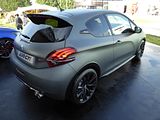



Making its UK debut alongside the 208 was a larger brother, the 308 GTi. Due to go on sale in the UK later in 2015, this C-segment car follows the same formula as many a hot hatch, offering upgraded looks, power, suspension and brakes, with 2 different engine outputs of 247 and 270 bhp going to be available. Like the smaller Peugeot, it will also be offered with the two tone finish, and an example of that was on show here. Also like the 208, you have to content with the low set and tiny steering wheel. It’s a shame that Peugeot insist that this arrangement is popular with its customers, as my experience driving a regular 308 for a weekend is that it would completely preclude me owning one, and yet there is plenty to like in all other regards about this welcome addition to the ranks of the affordable hot hatch brigade.
Still a concept at the moment was this 308 R Hybrid. It develops 493bhp and 538lb ft of torque from its petrol-electric hybrid powertrain, which sees the 267bhp 1.6-litre petrol engine from the Peugeot RCZ R mated to two electric motors. Combined, the car has a 0-62 mph sprint time of 4.0 seconds, but emits just 70g/km of CO2. The 308 R Hybrid has been adapted to cope with the extra power on offer, with the front and rear tracks both widened by 80mm. It sits on 19-inch alloy wheels, clad with 235/35 R19 tyres. Power is sent to all four wheels, and there are upgraded brakes front and rear. There are four driving modes: Hot Lap; Track; Road, and ZEV. Hot Lap mode is designed to make the most of the car’s power, while Track only allows access to 395bhp. Track uses the petrol engine and the rear electric motor, with the front one acting as a booster for acceleration. Road mode has 296bhp and uses the petrol engine, supplemented by the rear motor for acceleration, while ZEV only runs on the electric motors. Peugeot has not said how far the car can travel on electric power alone, but has said it can be fully recharged on a fast charger in just 45 minutes. At the front, the grille has been modified and features a chequered pattern, while the bonnet has two air scoops, one on either side. It is more understated at the rear, with a narrow spoiler at the top of the tailgate. There are two more air scoops on the bumper, which help keep the battery cool by drawing out hot air. The two-tone paint job is familiar as this also appeared on the earlier 308 R concept that first appeared at the 2013 Frankfurt motor show, although it is blue and black on this Hybrid. The paint contains glass particles to add shine, while the colour scheme is normally only used on French competition cars. Inside, the cockpit is familiar to the rest of the 308 range in many ways, with the same instrumentation. However, it gets four individual sport seats, in fawn leather, while the dashboard is covered in a soft-touch fabric that Peugeot uses on its concept cars. It has the same small steering wheel as the rest of the 308 range, but with 308 Hybrid R badging. The six-speed automatic gearbox is controlled by paddles behind the wheel, and a head-up display projects the crucial data into the driver’s eye-line. Production is still very much a possibility.
Less sporting cars were around the other side of the stand and these included the 2008 and the recently facelifted 208. It would need a trained eye to spot the visual alterations that were made when the model was revised, with more significant changes coming under the bonnet and to the equipment levels.
Far more interesting, to me at least, on this side of the stand were the motorsport cars: the legendary 205 T16, Group B Rally car of the mid 1980s was joined by Peugeot’s two current competitors, the very substantial 2015 Dakar entrant 2008 and the 208 WRC model.
A joint venture between Peugeot, Red Bull and Total, the Peugeot 2008 DKR shares an unmistakable family resemblance with Peugeot’s road-going crossover, albeit with more muscular forms and more imposing overall proportions that have been honed to meet the challenges of one of the worlds toughest events, in which Carlos Sainz and Cyril Despres were to compete. The 2008 DKR features an aggressive stance dictated by the technical constraints associated with its mission. There was a very precise brief for Peugeot’s Style Centre, with the basic key dimensions, as well as other information such as the cabin space required, plus the wheel size and the suspension travel. There was also aerodynamic data resulting from early simulation work. One question that Peugeot Sport’s design team had to answer at a very early stage concerned the new beast’s transmission: four-wheel or two-wheel drive? The decision effectively influenced the car’s design in two key areas: Having carried out an in-depth analysis of what already existed in the world of cross-country rallying and weighed up the benefits of the different solutions, Peugeot opted for an approach that was quite different to that of the competition. Given the off-road capability of two-wheel drive transmission and its ability to run on sand, that was the choice. It enabled the fitment of bigger wheels and allowed more suspension travel. The 2008 DKR consequently sits on 37-inch diameter Michelin tyres. A further bold choice as to use a diesel engine, making this car unlike its main rivals. The decision to go for a two wheel drive solution has another advantage: far less weight, as allowed by the regulations. The bigger wheels provide a certain advantage when it comes to coping with the many pitfalls associated with the type of terrain that will be encountered, and it is possible to minimise the front overhang. The 2008 DKR can practically climb vertical walls! And that’s not all! Longer suspension travel – 460mm instead of 250mm – enhances its ability over dunes and when soaking up uneven ground, a key asset on an event like the Dakar! Another advantage of the larger wheel size is a system that enables the tyre pressures to be adjusted remotely from inside the cockpit upon entering a zone of dunes – a tactic that could yield a gain of precious minutes! In order to exploit these benefits fully, Peugeot Sport’s engineers put their creativity to the test to come up with an extremely compact car. With its 340bhp, V6 twin-turbo diesel mid-rear engine, the 2008 DKR resembles a muscular feline ready to pounce and soak up obstacles. Fitting all of the vital assemblies into such a small space gave the designers quite a headache, but as small cars tend to perform more comfortably over twisty WRC-type stages, this arrangement increased the potential of two-wheel drive cars in situations where the 4x4s tend to have the edge. The car went on to win the event.
There were some more Peugeot models inside, including the 508 Saloon, which was recently updated. Again, you need to be very familiar with the earlier model to be able to spot the difference.
The car I more enjoyed seeing here was much older, a beautifully preserved 309 GTi Goodwood. This was a UK only Limited Edition model, based on the regular GTI, but with full black leather interior as standard, and no-cost optional wooden steering wheel, gearknob and CD-Autochanger. The model was only available in limited numbers for the UK market (only 398 vehicles were constructed), all of them in metallic pinewood green with anthracite Speedline alloy wheels, with metal lip on outer rim and badging depicting the Goodwood racing circuit on the front wings, tailgate and steering wheel boss. When the Goodwood was launched, the high asking price resulted in some examples not finding homes until 1994, hence some being registered on an ‘L’ prefix registration. There are only a few survivors.
PORSCHE
The Porsche hospitality area, vast in size, was adjacent to the Lamborghini one. Lacking an invite to enter, like most people visiting the event, I had to content myself with looking at the 919 Le Mans car that was parked on the corner of the enclosure. This turned out to be the 919 Porsche Hybrid number 19 with which Nico Hülkenberg and co-drivers Earl Bamber and Nick Tandy drove to victory at the 2015 24 Hours of Le Mans.
RENAULT
Making its UK debut was the Kadjar, a close relative of the Nissan Qashqai, and a vehicle which at quick glance you could easily mix up. The Kadjar goes on sale in the UK later in the summer at prices which we are told will be lower than those of the Nissan. Given the fact that the cars look similar, and share the same mechanical underpinnings, I have to wonder if the Renault will cannibalise sales of the established Nissan or whether this 21st century example of what is more like badge engineering than just platform sharing will help to wipe out the competition. Certainly in its native France, a Renault badge will be a huge asset, but elsewhere, it will be interesting to see what happens.
UK sales of Renaults took a massive nose-dive a few years ago, even before half the range was withdrawn from our market, and that is largely because the cars that were being offered were simply too undistinguished against an onslaught of very capable opposition. The one exception was in the hot hatch sector of the market, where models like this Megane RenaultSport RS 275 Trophy, to give it its full and rather lengthy name, proved to be absolutely class-leading where the base car from which the model was developed was not, proving that Renault can “build a better car”, as the advertising slogans so memorably said some time ago.
Everyone rather hoped that this would apply when the RenaultSport RS200 version of the fourth generation Clio was launched in 2013, and as we all know, the proverbial spot was missed by a surprisingly large margin, largely thanks to the automated gearbox which was the only configuration offered. Renault have launched a revised version of the RS200 this year, and it was on display. Whilst better, it has still not exactly convinced the UK press that this car is now the equal of, let alone able to better the Fiesta ST.

Renault have been standing firmly behind what they call ZE (Zero Emission) vehicles for a while now. Two of them are offered in the UK at present, the slow selling Fluence having been withdrawn from the market, the Twizy and the Zoe. Very different in concept, the latter is a neatly styled B-segment sized family hatch whilst the Twizy is definitely a rather zany little fun car which could just about be used as an everyday car (though you may not enjoy it much in the rain!).
The rear-engined Twingo has been on sale for a few months now. There was lots of enthusiasm for the promise of this mechanical layout. but apart from a particularly tight turning circle, it does not seem to endow the car with any particular advantages and it does impose some constraints in terms of packaging and boot space. That’s a shame as the car looks quite neat.
Selling strongly, no doubt much to Renault’s relief and delight, is the Captur. Effectively a crossover version of the Clio this is very much a car for the moment, offering the advantages of the body style with few compromises, though it is hardly an exciting car, and I remain very disappointed by the quality of the interior which is full of thin-feeling hard and sharp edged plastics.
SEAT
I did not get to spend much time on the SEAT stand, which is a shame, as I rather like their current range of products. There was nothing that was completely new here, but this was one of the first appearances of the recently facelifted Ibiza and the ST (SEAT speak for Estate) version of the very impressive Leon Cupra were both on show.
There were a number more SEAT cars inside the Moving Motor Show area, but by the time I got to these, the lights were being switched off, and it was time to leave.
TESLA
A small stand for Tesla to showcase and talk about the Model S was not really enough for most of the day, as this car generates massive amounts of interest wherever it is shown. Only late in the day did the crowds dissipate and I could get a decent photo of the car.
TOYOTA
Perhaps wisely, Toyota decided to concentrate on sport-related models on their stand, rather than to fill it with the exceedingly unimaginative products that constitute the bulk of their current range. My favourite was not a new car, but what for many people, me included, is the “best” Toyota ever built, the legendary 2000GT. A front-engine, rear-wheel drive, two-seat, hardtop coupé grand tourer designed by Toyota in collaboration with Yamaha, the 2000GT was first displayed to the public at the Tokyo Motor Show in 1965. It was then manufactured under contract by Yamaha between 1967 and 1970. In Japan, it was exclusive to Toyota’s Japanese retail sales channel called Toyota Store. The 2000GT revolutionised the automotive world’s view of Japan, then viewed as a producer of imitative and stodgily practical vehicles. As sleek, high-performance fastback, it demonstrated its auto makers could produce a sports car to rival the better marques of Europe. Most of the 2000GT’s design was done by Yamaha, which also did much automobile work for other Japanese manufacturers, originally for Nissan rather than Toyota. Many credit the German-American designer Albrecht Goertz, a protégé of Raymond Loewy who had previously worked with Nissan to create the Silvia, as inspiration. He had gone to work for Yamaha in Japan in the early 1960s to modernsze Nissan’s two-seater Fairlady sports car. A prototype 2000GT was built, but Nissan declined. Yamaha then proposed the design to Toyota, whom they also did contract work for, then perceived as the most conservative of the Japanese car manufacturers. Wishing to improve their image, Toyota accepted the proposal, but employed a design from their own designer Satoru Noza. The resulting car is widely considered a classic among 1960s gran turismos. Its smoothly flowing “coke bottle” bodywork was executed in aluminium and featured pop-up headlights above large plexiglass covered driving lamps flanking the grille similar to those on the Toyota Sports 800. Bumpers were minimal, and the car was extremely low, just 45.7 in to the highest point of the roof. In spite of a custom open-top version built for the James Bond film You Only Live Twice, a factory-produced convertible was never offered. The engine was a longitudinally mounted 2.0 litre straight-6, based on the engine in the top-of-the-line Toyota Crown sedan. It was transformed by Yamaha with a new double overhead camshaft head into a 150 hp sports car unit, with three carburettors. A five speed manual gearbox was part of the spec. Just 351 examples were made, and on the rare occasions that one comes up for sale, you could well be looking at figures of half a million to buy one.
Displayed alongside the 2000GT was a modern reinterpretation of the idea, the Concept FT1. First unveiled at the 2014 Detroit Motor Show, the FT1 was intended to mark the start of a new chapter of Toyota design philosophy that will result in more passionate, exciting vehicles. The car was described by its maker as “a true enthusiast’s track car in the lineage of the 2000GT and Supra”. The name FT-1 stands for ‘Future Toyota’, with the number one representing “the ultimate world-class sports car with the ultimate performance envelope”. Although Toyota would not be drawn on technical specifics of the FT-1, sources did confirm that it has a combustion engine only, with no hybrid system. Performance from the engine is described as “high output”. The FT-1’s front engine/rear-wheel drive configuration allows the cockpit to sit further towards the rear of the car, within the wheelbase, helping to improve weight distribution and creating classic sports car proportions. The wraparound windscreen and side glass arrangement are a clear nod to the design of the original 2000GT. The cockpit was described as a “delta-shaped display zone. This helps to make the driver feel at the heart of the action, fully connected to the car”. It features a Formula 1-inspired steering wheel and a colour head-up display that projects key information just above the wheel. The FT-1 was conceived at Toyota’s Calty design research centre in California. Calty president Kevin Hunter said the philosophy behind the car marked a radical change in the way Toyota’s products are designed, the result of a challenge from company boss Akio Toyoda to create cars that sparked people’s emotions, cars that make people say, ‘I want this, I have to have this’. The brief was very simple: “make it cool”, and the designers chose to answer the challenge by creating a truly exciting, high-performance halo sports car. Beyond its obvious visual impact, the FT-1 was intended to be symbolic of a new chapter for Toyota global design. For many years Toyota has approached product development relying on a strong influence from the market through consumer studies and a degree of internal consensus, but with this car, the goal was to produce a vehicle that was liked by everyone, so the decision was taken not to stray too far from designs that had been a success, with the goal of developing future generations of products that connect on an emotional level. It is expected that some elements of this car will make it to production with what may or may not be badged Supra when a new Toyota emerges in 2016/2017. Whatever that car ends up being like, the FT-1 is not part of the Japanese manufacturer’s collaboration with BMW, which is limited to the production of hybrid-based sports cars. The Toyota FT-1 was added as a download to Gran Turismo 6 within days of appearing at the Show, and it was said that company chief Akio Toyoda’s first-ever look at the FT-1 was via the virtual version in the computer game.
Bridging the gap between the FT1 and the 2000GT was one of the Supra models from the mid 1990s.
In one corner of the front of the stand was Toyota’s successful Endurance racer, the TS030, which has won just about everything apart from le Mans. The TS030 marked Toyota’s first works entry at the 24 Hours of Le Mans since the Toyota GT-One was entered in the 1999 race, and is notable for being the first petrol-powered hybrid car to be entered in the FIA World Endurance Championship. The TE030 features the Kinetic Energy Recovery System (KERS) regenerative braking device to charge a supercapacitor. The extra power is directed to the rear wheels. Under the 2012 Le Mans rules they were allowed to use the system at any speed, unlike Audi who had elected to send power to the front, with a restriction to a minimum speed of 120 km/h. Expected to make its debut at the 6 Heures de Spa-Francorchamps in May 2012, a testing crash at Paul Ricard had damaged the chassis beyond repair, so the team was forced to delay the TS030’s debut until that 24 Hours of Le Mans in June because of the time needed to produce a new monocoque. On lap 82 at Le Mans, Anthony Davidson’s TS030 became airborne after a collision with Piergiuseppe Perazzini’s Ferrari, and collided hard with track barriers. Davidson suffered two broken vertebrae from the incident. The second TS030, which had briefly led the race before the accident, retired several hours later after an engine failure. After finishing in second place at the 6 Hours of Silverstone, the TS030 Hybrid took its first pole position and victory at the 6 Hours of São Paulo race, held at the Autódromo José Carlos Pace in São Paulo, Brazil. It finished the 2012 season with two more victories at the 6 Hours of Fuji and the 6 Hours of Shanghai. Toyota started the 2013 schedule with two 2012 spec TS030’s. Both showed stunning pace in qualifying at the first race of the season, the 6 hours of Silverstone, with the #7 machine qualifying more than 3 seconds ahead of the nearest Audi, whilst the #8 sister car qualified second. The race however was at best uneventful, with neither car being able to match either Audi’s pace, finishing third and fourth overall having struggled in the first few hours of the race with tyre management. The second round at Spa-Francorchamps would see Toyota debut the new 2013 specification TS030 featuring a revised aerodynamic package and including an updated monocoque. After a close qualifying session, the updated #7 ran near the front of the race for the first three hours, before retiring due to overheating brakes as a result of a malfunctioning energy recovery system. With the rear brake assembly designed to be assisted with certain amounts of mechanical retardation provided by the hybrid recovery system by design, it did not provide the deceleration when malfunctioning, thus overloading the conventional rear brakes. The sister car remained in fourth for the rest of the event, closing what was a mixed outcome for the team. Post race, technical director Pascal Vasselon complained that his team’s analysis from Spa showed that the current Balance of Performance significantly favoured Audi’s turbodiesel powerplant over its own normally-aspirated petrol engine, calling the ACO and FIA for a more favourable balance of performance to be applied before Le Mans. As agreed at the start of the season, the FIA and the ACO reviewed the technical regulations at the end of May 2013 to adjust the performance between petrol and diesel LMP1 cars for the remainder of the 2013 WEC Championship. From the 24 Hours of Le Mans onwards, petrol-engined cars were permitted an additional 3 litres of fuel capacity. It was not enough to give the Toyota victory, though, with Audi once again claiming the chequered flag.
VAUXHALL
Vauxhall did have a stand, but it was well apart from all the other manufacturers, and I only came across it late in the day, when – being honest – I was heading towards a toilet block. I am glad I did find it, as rather than filling it with the current everyday range of models, it contained some of the most sporting cars from their back catalogue, with the VX220 VXR, Lotus Carlton and the Firenza HP.
Also on show was the 2003 VX Lightning Concept. This attractive 2 seater sports car very nearly made it to production, and indeed the Kappa platform on which it was built, was used to underpin the Saturn Sky and Pontiac Solstice which were offered to US buyers for a few years. Although physically larger, the Lightning was positioned as a cheaper car than the VX220, and was aimed at the Mazda MX5 and MG TF, but a number of factors conspired against getting it into production.
VOLKSWAGEN
Volkswagen had a large stand at the end of the long line of manufacturer displays, but it was well worth the long walk to get to it, as on show here were several concept vehicles, all of which had been quickly whisked off the various international shows stands as soon as the press departed, thereby depriving the paying public the chance to see them for themselves. Perhaps the most radical of them was the XL Sport, which combined the super smooth body of the futuristic XL1 with a potent Ducati engine. Premiered at the 2014 Paris Show, the mid-engined, rear-wheel-drive XL Sport concept marked the 200 millionth car produced by Volkswagen. Powering this one-off was the Ducati’s V-twin engine, the world’s most powerful two-cylinder motorcycle engine, derived from that found in the 1199 Panigale Superleggera. Installed in the sleek XL Sport, it produces 197bhp, has a top speed of more than 167mph and revs to a maximum of 11,000rpm. This engine, together with a seven-speed DSG transmission, launches the sports car from 0-62mph in 5.7 seconds and revs up to 11,000rpm. The tyres are 205/40 R18 at the front and 265/35 R18 and the rear, and the wheels are made from forged magnesium, which brings a total weight reduction of 23.9kg compared with aluminium wheels. The XL Sport weighs 890kg and has a drag coefficient of 0.258. Volkswagen claims these factors combine to make it the fastest car in the world for its power output. Although the car bears a close resemblance to the super-frugal XL1, some major design aspects have been developed completely from scratch. There are a number of special aerodynamic tweaks including special air curtains, wheel arch air outlets, an optimised underbody, a diffuser that reduces aerodynamic lift and adaptive exhaust heat vents integrated in the rear lid. The concept car is slightly longer and wider than the XL1 with a length of 4291mm, width of 1847mm and height of 1152mm. It has a 2424mm wheelbase, longer than the XL1, significantly wider wings and larger wheels. The extendible rear spoiler is powered by the same apparatus unit as in the Lamborghini Aventador. It also has adaptive waste heat vents incorporated in the rear hatch – the louvres opens and closes automatically as required to conduct excess engine heat away. The air supply for cooling the Ducati engine is via vents in the rear wings. It has a carbonfibre tub like XL1, with steel space frames at either end to hold the suspension. They are supplementary to the carbonfibre tub and aluminium crash structures. The suspension consists of a double wishbone front axle with the dampers connected below in a pull-rod configuration, and a double wishbone rear axle with the dampers connected above in a push rod configuration. Like the XL1, many parts of the XL Sport’s body are manufactured in carbon-reinforced polymer (CFRP), with a monocoque featuring slightly offset seats for the driver and passenger. The interior boasts a number of changes over the standard XL1, such as a digital instrument cluster, with an individual lap time and oil pressure display. A flat carbonfibre part that extends the top of the instrument cluster covering to eliminate reflections in the windscreen. The car remains a one-off, with no signs that it will enter even limited production.
Something we are more likely to see would be a production model not too unlike the Sport Coupe Concept GTE. Unveiled at the 2015 Geneva Show, but also removed before I got there, this Concept is said to provide plenty of clues for the next generation CC as well as to hint at the design of the long-awaited replacement for VW’s range-topping Phaeton saloon. At 4870mm long, 1865mm wide and 1407mm tall, the Sport Coupé GTE is longer, wider and lower than the new Passat saloon. Its wheelbase is also 50mm longer than its four-door sibling’s, at 2841mm. Inside, the concept has a full-length centre console and a series of digital displays and touchscreens. There is seating for four on individual seats and 480 litres of boot space. The Sport Coupé GTE also showcases a plug-in hybrid system that VW is investigating for a range of future models. The petrol-electric system is based around a turbocharged 3.0-litre V6 petrol engine that produces 295bhp in the Sport Coupé GTE. It operates in combination with two electric motors — one in the front of the gearbox housing that delivers 54bhp and another at the rear providing 114bhp. The hybrid system produces a combined 374bhp. A nominal torque rating has yet to be divulged, although the six-speed dual-clutch automatic gearbox is claimed to handle up to 516lb ft. The petrol engine and front electric motor power the front wheels, and the rear electric motor powers the rear wheels via a so-called electronic propshaft, giving the Sport Coupé GTE on-demand four-wheel drive capability. No weight has been revealed, but computer simulations suggest a theoretical 0-62mph time of 5.0sec and a top speed of 155mph. Combined-cycle fuel economy is put at 141.3mpg, with average CO2 emissions of 46g/km. The concept has an electric range of up to 31 miles, VW says. The overall petrol-electric range is a claimed 746 miles.
Not a concept, but also a VW that you cannot buy, is the Polo WRC car, VW’s entrant in the world of rallying.
Two examples of the Golf were here, one of which is available now (though the waiting list is long) and one of which we are told you will be able to buy “soon”. The first is the GTE, the clever hybrid model that combines the technology of the eGolf with the more conventional diesel powerplant of the GTD, and the one you should be able to buy in due course is the GTi ClubSport, still officially a concept. The ClubSsport is differentiated from existing seventh-generation Golf GTi models through a series of styling upgrades which are claimed to provide it with true downforce, both on the front and rear axle, at speeds above 75mph for the first time. Included is a unique front bumper featuring a large central air duct with a honeycomb insert, additional trapezoidal ducts used to cool the front brakes, high-gloss black blades low down on the outer edges for added downforce, so-called air curtains to smooth airflow around the edges and a splitter element down low. The upgrades up front are accompanied by high-gloss black door mirror housings and a black graphic along the lower edge of the doors in homage to the look of the original 1976 Golf GTi. At the rear, Volkswagen’s design team has provided the new car with a new twin-vane spoiler mounted atop the tailgate, together with vertical vanes along the outer edges of the rear window, a heavily restyled bumper with an integrated diffuser and larger-diameter chromed tailpipes. The Golf GTI ClubSsport is powered by a reworked version of the Volkswagen Group’s turbocharged 2.0-litre four-cylinder EA888 petrol engine, as used by existing versions of the Golf GTi. But while the standard Golf GTi gets 217bhp, or 227bhp in Performance guise, the ClubSport offers up 261bhp between 5350 and 6600rpm. That’s not the end of the story, though. An overboost function temporarily raises turbocharger boost pressure from 1.9bar to 2.1bar for up to 10 seconds on kickdown, increasing overall power output to 287bhp – albeit only for a maximum 10 seconds. That’s just 8bhp less than the Golf R. All this does not come cheap, though, as in the UK it is likely to cost around £29,000 when it goes on sale in early 2016. Only limited numbers will be built.
There was also an example of the Passat GTE here. Conceptually similar to the Golf GTE, this also marries hybrid technology with a 1.6 litre TDi engine.
OTHER DEALER DISPLAYS
As well as the main manufacturers, a number of dealers as well as various other trade stands extend over quite a wide area, and you could easily spend a large part of the day browsing what they have to offer. Sadly, there was not time to do that, so I am well aware that there will be sorts of interesting things from this part of the event that I will have missed. These are the things which did catch my eye and my camera.
ALVIS
Respected Coventry marque Alvis may have ceased building new cars in 1967, but the company did not actually go out of business, and the survival rate of the cars that they had created over the preceding 60 years remains high, so there is still plenty of interest in restoring and subtle modernisation of Alvis products and an offshoot from the original company, called the Alvis Car Company is doing just that, as well as planning to create 77 what are called “Continuation Series” cars. Seen here is a beautiful Speed 20 from the mid 1930s.
MUSTANGS – BILL SHEPHERD
Bill Shepherd is an established and well known specialist in all things Mustang. Their business is likely to change a little now that Ford themselves are importing the latest car, but there will still be plenty for them to offer with the last 50 years worth of the model to sell and support. A surprising number of old Mustangs are in the UK, as was proved for the 50th anniversary celebrations in 2014, and although the first series cars are the most popular, there are examples of all generations over here. Bill Shepherd had a varied display of models on their stand, which ranged from the latest GT350 to some early Coupe, Fastback and Convertible cars.
OTHER
Looking more like they were abandoned, rather than parked up to produce a striking display was a dealer collection of some interesting exotics, which were behind some of the manufacturer stands, and what struck me about this was that here were a Ferrari Testarossa, a 512TR and a 512M altogether, something you don’t see very often.
Among a collection of classic 911s, the same dealer had a 1995 RUF Porsche BTR, one of just 13 such cars made, on offer.
PRINDIVILLE
A dealer that I don’t recall coming across before, Prindiville had a reserved grassy area for some of the cars that they have for sale and these included a LaFerrari and a Lamborghini Diablo
TAG HEUER DRIVERS CLUB
TAG Heuer has been the official timing partner of the Festival since 2010, showcasing its watches at an impressive stand and the sponsored Drivers’ Club as well as presence around the track. I did not get access to the Driver’s Club, but reports I read after the event revealed that this year the Swiss brand introduced several timepieces to commemorate its bond with the Festival and former home to the Grand Prix races of old, as well as limited edition TAG Heuer pieces shown at Baselworld 2015, including the new Formula 1 McLaren watches The approach to the Drivers Club is always lined by a display of interesting cars, and this year the connection was Steve MacQueen. who wore a TAG Heuer watch in his famous 1970 film “Le Mans”, and so this year there was a line of cars from his estate, including a version of the famous green Mustang that he drove in the 1968 classic Bullitt (one surviving car was sold to an employee after the filming ended). Not only did McQueen do his own driving stunts, but the movie also contained a record for the longest drive chase without any dialogue. Also to be seen here were a Radford Mini Cooper 1275, a Jaguar XKSS and a Porsche 356 Speedster
The GERRY JUDAH CREATION of 2016
Although the theme for the event is announced well in advance, there are always plenty of surprises, and one of them is just what the showpiece will be on the main lawn in front of the house. Renowned sculptor Gerry Judah has been wowing the crowds for 18 years with something bold, original, distinctive and very different from what has gone before, and this year was no exception. The theme for 2015 was Mazda, so perhaps it was no surprise that cars from this Japanese marque would feature on his creation. Two of them were selected, a Group C 787B and an LM5S Vision PlayStation concept, for the 36 metre high structure. The latter had been a virtual creation only until this event with the displayed car being specially constructed for the Festival. The form was apparently inspired by the marque’s Kodo design philosophy of strength, tension and beauty, it certainly captured something otherwise ineffable. Two racing cars trailing a double helix of steel, the structure curved back on itself so that the cars hung over anyone standing beneath. Instead of steel sheets that were used for previous designs, this year the sculptor used stacked overlapping bars, that were assembled in modules in the factory. The modules were later fitted in place using a crane and careful supervision from the team. As ever, it was stunning.
CARTIER STYLE et LUXE CONCOURS
Once again, there was a fabulous display of elegant cars on the side lawn, in the manner of a traditional Concours, as there has been at the event every year since 1995. There were around 50 machines in total entered, including a collection of classic motor bikes with side cars, though not all of them were present on the Thursday and as in previous years, there were lots of individual classes, with no evident linkage between them, meaning that there was plenty of variety of what was on show. Without exception the vehicles on display were absolutely fabulous, and considered as an ensemble were like an event in their own right. There were winners declared in each class, and one overall winner, and a whole panel of judges, which included Lord Linley, Sir Jonathan Ive, Geodie Greig, David Gandy, Nick Foulkes, Darcey Bussell, Marc Newson, Roger Taylor, Flavio Manzoni and Jodie Kidd had the difficult task of making those decisions. That might seem like a slightly surprising list of names, but the Cartier Style et Luxe is unique in that it focuses primarily on design excellence rather than on restored condition. It is for this reason that the competition is decided not by expert car judges, but rather by eminent personalities from the creative industries, as, so we are assured, “their many and varied sympathies focus on such abstract concepts as proportion, texture, shape and detailing”.
A SPORTING ADVANTAGE – SUPERCHARGED SPORTS
Winner of this class, and a car I could stand and stare at for ages, was this 1931 Alfa Romeo 8C 2300 MM.
1936 Alta SC 2 seater sports
By the early 1930s, MG had quite a bewildering array of different models on offer, but it seemed that this was not entirely a bad thing, as sales were strong. Seen here is a 1934 MG K3, one of just 33 such models built. In 1932. MG had introduced yet more new models. The already successful Magna range was complemented by the addition of what were to be known as the K series Magnettes. The cars followed on in logical sequence from the very popular J types and the K1 and K2 utilised the now familiar and well established conventional MG chassis layout. These new models were to form the basis for an important new racing model and it was with this solely in mind that Cecil Kimber took the decision to “produce the K1 and K2, as he could not justify the production of a racing model on its own at the time. The K3 as it was designated did not in fact appear at the same time as the K1 and K2, although it was announced at the 1932 Motor Show. A prototype did however emerge from the factory in January 1933 which would give Kimber his much desired entry into Class G (1100cc) racing as this class fell midway between the 847cc Midgets and the 1271 cc Magnas. The K types were available at first in two chassis lengths with the K1 having a wheelbase of 9’0″ and the K2 being 7′ 10″, with a track of 4’0″ in ‘each case. 13″ drum brakes provided the stopping power and although the engine was 1087cc it did have more power than its larger engined predecessors, the Magnas. Sporting a cross flow head and stronger crankshaft, the engine at first fitted was known as the KA and was based closely on the six cylinder Wolseley Hornet unit. This was underpowered for the long wheelbase K1 and short wheelbase K2, so very soon after the two models had gone into production, a more powerful KB type engine was made available. These engines were put into the open tourers as they were deemed more worthy of the extra power, whilst the more sedate saloons retained the less powerful KA engine. The K1 was offered either as a very attractive pillarless four door, four seater saloon or slightly later as an open four seater. This car could be had with either a four speed ‘crash’ gearbox or with a Wilson preselector transmission. The K2 was strictly a two seater car and the chassis and body was essentially a widened version of the J2 with the classic cutaway doors and the addition of sweeping front wings completed the package. The MG model range was particularly confusing at this time with the K series having three different chassis, four different engines, three gearboxes and five body variations and with such small quantities of each one being produced, no two cars seemed alike! As if this was not enough, early on in 1933, the Magna range was updated with the introduction of the L type in which was placed an engine derived from the KB Magnette power unit. This became known as the KC type with coil ignition and twin carburettors. Despite this ever bewildering range of cars, Abingdon did see very good sales during this period, this no doubt helped to justify probably the most famous Magnette of all time, the racing K3. It was in the winter of 1932 that two K3 prototypes took shape in the racing department at the Abingdon factory, both utilising supercharged 1100cc engines on specially made chassis upon which were mounted modified C type racing bodies. One of the cars .was entered in the Monte Carlo Rally and it proved to be the fastest car on the Mont des Mules hillclimb section, breaking the class record easily. The other car, accompanied by Reg Jackson and a team of drivers, went to Italy to make an entry in the Mille Miglia. This was a gruelling 1000 mile race on public roads which had always been dominated by home teams such as Maserati. The prototype was thrashed around sections of the Mille Miglia course on a reconnaissance mission prior to the event; this was intended to show up any weaknesses in the car and this it did. The pre-selector gearbox had to be revised because the gearing was too low and it also consumed too much oil. Road wheels and hubs were redesigned as were the brake drums which failed under the arduous two month testing. Back in Abingdon, three team cars were prepared and they were shipped to Genoa in early March 1933, ready to tackle the Mille Miglia, driven by Earl Howe and Hugh Hamilton, George Eyston and Count Lurani, with the third car manned by Henry Birkin and Bernard Rubin. Birkin’s K3 had to retire with a broken valve, but the remaining two K3s proceeded to break all existing class records, finishing first and second in their class and also collecting the team prize. This marvellous victory at an event that was renowned for being the toughest in the racing world set the stage for countless other successes at race venues all over the world. In its class, the K3 remained at the top for the best part of two years, becoming one of the most successful racing cars of all time. The two prototype K3s differed from the production K3s in several ways, with the production specification as follows. The standard K2 chassis of 7’10 3/16″ was employed based on an open channel frame stiffened with tubular cross members and cruciform centre bracing which was under slung beneath the rear axle. Remote chassis lubrication was provided by grouped oil nipples mounted on a plate on the offside bulkhead. Suspension was by semi-elliptic leaf springs front and rear, running flat under load and being taped and then cord bound. The main spring leaves moved in sliding trunnions at the trailing end. Two Hartford duplex friction dampers were mounted longitudinally at the front and four were utilised at the rear, mounted transversely. Wheels were of the Rudge Whitworth wire spoked racing type, 19″ in diameter. Brakes were 3” drum type, cable operated via a central cross shaft connected to a fly-off type handbrake lever. The brakes were adjustable from the cockpit via a small hand wheel mounted on the back of the gearbox below the preselector lever. Steering was effected by means of a cam type box and transverse draglink to an axle mounted slave arm that controlled the wheels through a divided track rod. The 6 cylinder overhead camshaft K3 engine had a bore and stroke of 57mm x 71 mm and a displacement of 1086cc. The four main bearing crankshaft carried steel connecting rods with aluminium pistons. Engine lubrication was effected by a wet sump system utilising a gear driven pump and a large triangular shaped finned sump assisted with the oil cooling. A reserve oil feed tank was mounted on the scuttle. The cylinder head was of the cross flow type with a single overhead camshaft driven by a vertical shaft directly from the crankshaft. This shaft also formed the armature for the vertically mounted dynamo. Special valves and triple springs were used on both inlet and exhaust and the bearings all had special metalling applied. The Powerplus vane type supercharger was mounted ahead of the radiator and ran at 75% of crankshaft speed, driven from the crankshaft nose via a splined coupling shaft with universal joints. This ran with a high boost pressure, the end result being a power increase of nearly three times that of the standard engine. Peak figures quoted for the engine show 118 bhp @ 6000rpm with the Powerplus supercharger and on the 1934 engines fitted with the Marshall Roots supercharger 115bhp@ 6500rpm. These later engines had an improved N type cylinder head with more efficient porting, giving smoother and more progressive power through the range. A Wilson preselector gearbox with centrally mounted selector lever transferred the power to the road wheels via a three quarters floating rear axle with a straight cut bevel final drive. The exhaust system was a Brooklands competition system with a six branch primary manifold feeding an externally mounted silencer which then led to a huge fishtail tailpipe. Engine cooling was by means of a thermo syphon system and engine driven water pump with a stone guard protected radiator featuring a quick release competition filler cap.
Also in the class, but not on show on the Thursday were a 1938 AC 16/90 and a 1934 Triumph Dolomite 8C SS Corsica Roadster
SWEEPING STATEMENTS – FIGONI et FALASCHI
Giuseppe Figoni was the artistic genius and Ovidio Falaschi the businessman, and together they created some of the most elegant (and aerodynamic) bodies for the best chassis of the day from their bodyworks in Boulogne-sur-Seine. With their Figoni bodies, chassis from manufacturers such as Talbot-Lago, Delahaye and Bugatti were turned into France’s supercars of the 1920s and ‘30s, offering both ‘style’ and ‘luxe’ in spades. Marking the 80th anniversary of Figoni et Falaschi was a category exclusively for cars bodied by the legendary French coachbuilder, which enveloped some of the most sought-after cars of the day with Giuseppe Figoni’s distinctive teardrop shapes and golden wood interiors. Five cars were entered in this class, all brought over from California by renowned collector Peter Mullin
This is a 1934 Avions Voisin C27 Grand Sport Cabrio. Between 1919 and 1939, pioneer French airplane constructor Gabriel Voisin built expensive, high quality vehicles. Voisin’s most successful period was the mid-1920s when the range consisted of four and six cylinder models with relatively small displacement engines. Quite unusually for the time, most of the cars were offered complete, with the coachwork designed and constructed in-house. Inspired by the success, Voisin started working on larger engines to rival the likes of Hispano Suiza, Isotta Fraschini, Bugatti and Rolls Royce. In a cruel twist of fate, he introduced these new six and twelve cylinder machines right at the moment the world economy hit a major depression. With sales dwindling rapidly in the early 1930s, Voisin was faced with a decision to either tone it down a little and sell cheaper cars, or continue on the same path with no compromises. Fortunately he persevered and used all his experience to develop some of the finest vehicles of the decade, or arguably of all time. The first sign of the great things to come was the C24 ‘Aerodyne’ on display at the Paris Salon in 1933. Its typical, but also very modern art-deco design signaled a new direction for Voisin that would further perfected in the next year. A year after the first Aerodyne saw the light of day, a second one was unveiled in Paris, now using the all new C25 chassis, which came complete with high tech features like adjustable shock absorbers. It clearly shared its aerodynamic design theme with its predecessor, but the brightly painted C25 ‘Aerodyne’ sported several new features, including an incredible sliding roof. Although not present yet on the Voisin stand in Paris, the company also announced two variations of the three litre engine C25 chassis; the long wheelbase C26, and the shorter and underslung C27. The Paris Salon of 1934 was clear proof that Gabriel Voisin was at the very top of the game, but sadly the world was not ready yet for his exotic machines and the sales figures remained poor. Just 28 examples of the C25 chassis were ever constructed and with one and two built respectively the C26 and C27 were even less successful. Voisin tried once more with the even more advanced 3.3 litre C28 chassis, but despite the incredibly modern ‘Aerosport’ coachwork without separate wings, the company struggled to find buyers for their cars. Sadly Gabriel Voisin was forced to give up just when he reached the peak of his abilities. Seen here is one just two C27 models built. This one was sold as a chassis with the well-balanced Figoni & Falaschi body being unique to this particular car. The other C27, an Aerosport Coupe has factory coachwork and was on display at the 1935 Geneva Motorshow. Its first owner was Andre Noël-Noël Telmont (Voisin’s design partner) who kept the car for over ten years before it passing through several other owners. The car was shown at the 2006 Pebble Beach Concours d’Elegance where it was shown with the Sport Cabrio model seen here. The C27 is powered by a 3-litre six-cylinder engine equipped with two Zenith carburettors producing 104 hp and has a top speed of 93 mph. This car was built late in 1934 and was shown at the Madrid Auto Show. It was ought by the Shah of Persia, and subsequently given to the Iranian attaché in Paris. In 1948, it was bought by a Monsieur Poirer who kept until the early 1960s, It was then owned by a collector called Serge Pozzoli who started a restoration and intended to display in a museum, which never happened. The car was found in a barn in southern France in the late 1970s, in a somewhat poor condition. Restoration worked, led by Figoni’s son, started in 1984, completing in 1991, with the car being painted blue. Peter Mullin was later to buy it and undertake a second and far more comprehensive restoration.
This 1929 Bugatti Type 43/44 Roadster Luxe with body work by Figoni started life as a Type 43 racing car complete with factory-built racing body. It ran in the Ireland TT among other races. In 1929 it was rebodied by Figoni as an open Roadster Luxe, complete with signature flowing wings and two-tone paint. Then, when the car was restored in 1959, its then-owner upgraded the engine with a brand new 3.0-litre straight six from the Type 44.
This astonishing 1937 Delahaye 135M Torpedo, chassis 49150, is known to some as ‘The Star of India’. It was commissioned by the explorer and businessman Casimir Jourde, a personal friend of the world-renowned Coachbuilder Joseph Figoni, who perfected the ‘French curve’ and ‘the double curve’ featured on the Type 135. Eleven cars in this series, the Paris Auto Salon Series, were built between 1936 and 1939, and this is 1 of 3 of them which survive, bearing Figoni’s elegant bodywork. The curved arcs of the wings established the standard for the ‘French curves’ that are considered a signature characteristic of streamlined automobiles from the 1930s. Following its purchase after the 2002 Pebble Beach Concours d’Elegance by Peter Mullin, the “Star of India” has returned to its former grandeur and remains one of the shining centrepieces of the Mullin Automotive Collection.
Another of Peter Mullin’s treasures was this 1939 Delahaye Type 165 Cabriolet. with its enclosed wheels and novel disappearing windscreen. The 165 – the Figoni-bodied ‘production’ version of the racing 145 – was billed as something more than just beautiful: the car of the future. The aerodynamic cabriolet was chosen to represent France at the 1939 New York World’s Fair, and when initially produced it was engine-less. Needless to say, it was the talk of the Fair. With the outbreak of war, the car never made it back to Europe and was stored, minus its V12, on a dock in New York harbour, impounded by US customs. Roger Barlow bought it at auction in 1946 and fitted a Cadillac motor to it. Mullin discovered it in Hawaii in the 1980s, and during restoration finally fitted the planned exotic Delahaye V12 engine. Only two of these cars were ever made, making it one of the most historically important cars in the Mullin collection. And a complete jaw-dropper to boot. And in case you were wondering how you could steer a car with front wheel spats… just like a regular car! Somehow, Figoni figured out a way to make those front wheels turn as normal.
Overall winner not just of this class but of the entire Concours was a wonderful 1937 Talbot-Lago T150 “Goutte d’eau” (Teardrop) Coupe, also brought over by Mullin . Sadly, I don’t seem to have a picture of it, but suffice to say that the judges were pretty unanimous in declaring that this is one of the sexiest cars ever.
COACH and HORSES – COACH BUILT FERRARI
Oldest of the Ferrari models in this class was a 1951 212 Vignale Cabriolet. The story goes that British born, Paris based clothing tailor, John McFadden ordered a 212 Vignale Cabriolet back in 1952. For reasons that are not at all clear, it appears Ferrari attempted to deliver a right hand drive example of the same model, #0227EL which John refused to accept. To rectify the problem, Ferrari changed, restamped the chassis number of this left hand drive 212 Inter Vignale Cabriolet, from #0255EU to #0227EL and at the same time changed the chassis number of the original from #0227EL to #0255EU. This is the only LHD example 212 Inter Vignale Cabriolet of the total of four built. When it was delivered it carried black bumpers that were chromed by David G. Seibert in Atlanta during his period of ownership between 1978 and 1980. The car features a unique single rear seat on the passenger side which allows anyone travelling on it to put their feet behind the drivers seat. There are some claims that the car was once owned by suave British actor David Niven; but there is no validation of this that has been found, and was claimed on the notice board with the car as displayed here. Nor is this car a short wheel base Vignale Export Cabriolet model as it was also incorrectly labelled. Only 2 such cars were built, chassis #0106E and #0110E, neither of which is this car.
This 1953 212 Inter Vignale Coupe has been at a number of shows in the past year or so, displayed by Tom Hartley Junior, who has the car for sale. At the end of 1952 Vignale started producing its definitive 2 bumper coupé bodies designed by Giovanni Michelotti for the 116 mph Ferrari 212 Inter. It is believed no more than six of these twin bumper 212 Inters were produced from a total of 26 Vignale bodied 212 Inters and this car, chassis number #0257EU was the first chassis to be so futuristically equipped. This particular car was initially sold in 1953 to a Turin dealer called Fontanella who exhibited it at the Concorso d’Eleganza San Remo in 1954. Later in 1954, Luigi Chinetti sold the car to the paper product tycoon Robert C. Wilke of Milwaukee who was president of Leader Card Inc, who would become a well known sponsor of Indy cars. The car’s engine block is believed to have been replaced twice, first due to a crack that developed and secondly after a mechanic who over torqued the heads causing the studs to be pulled from the second block. The car resided in the United States until 1979 when it was acquired by a Belgian who kept it until 2006 when it returned to the United States. In 2009 Michael Green in Texas bought it along with the original engine block from John Hadjuk in Indiana whom he entrusted with the mechanical restoration of the car, while Gassman Automotive in Waynesboro Virginia took care of the rest. Mr Green sold the car for just over US$1.7 million including the buyer’s premium at Scottsdale in January 2014 and the car came over to the UK, where it was more or less immediately put up for sale again.
This 1959 250 GT Pininfarina Cabriolet Series 2, chassis #1865GT, was initially sent to Ferrari Representatives of California in 1960 before being bought by a former lab assistant, book salesman and piston ring salesman turned successful broadcaster of the (American) Today show, David Garroway. “The Roving Announcer”, Garroway was a pioneer of the informal conversational style television presentation, that had hitherto been more authoritative in the style of public oration, introducing one show thus :- “And how are you about the world today? Let’s see what kind of shape it’s in; there is a glimmer of hope.” in 1957. David broadcast the Today show from a variety of locations including; Paris, Rome, car shows, technology expos, plays, movies and aboard a B-52 bomber for a practice bombing run and his catchphrase when signing off was “Peace”. In the 1980s, this car’s original engine, stamped 326/F, was installed in a Ferrari 250 GT Coupé chassis # 2027GT of similar vintage, while the engine from a 250 GTE chassis #2929GT had already been installed in this car a decade earlier. This is the 29th of the 201 Ferrari 250 GT Series 2 Cabriolets to be built between 1959 and 1962 and was entered here by John Collins.
This is the one off 1963 250 GT Lusso by Fantuzzi. Originally built as a standard specification 250 GT/Lusso in March of 1963, making it the 16th car produced of this model, this car was originally grey metallic with a black interior and was delivered new to Luciano Pederzani of Bologna, who with his brother Gianfranco, owned Tecno, a builder of Formula F2 and F3 cars. The car was re-bodied around 1965 by Medardo Fantuzzi, who was designing the bodies for their Tecno race cars. Fantuzzi created a one-off treatment with more aerodynamic front end, faired in headlamps, and more pronounced rear spoiler. The colour was changed to gold metallic at this time as well. In 1966 the Pederzani brothers sold the car to someone in Venezuela. By summer of 1968 the car turned up in New York and was owned by Richard Trask. The car had a few more American owners during the 1970s. Terry Kramer bought the car, at that time the car was painted black, in 1977 and shipped it to Honolulu. The car went through Collier Thelian’s hands in 1978 and was sold to Gerald O’Conner in 1979. He then put it in storage in 1981 where it would remain for the next 24 years. The car arrived at DK Engineering in the Autumn of 2011 and their restoration team immediately set about stripping the car to chassis and body. Due to the car being unique, the bodywork stage was especially challenging; moulds, drawings and diagrams were made from genuine GTOs and precisely scaled to Lusso size for the GTO louvres and vents on the bonnet and front and rear wings. The covered headlights and altered bootlid were also painstakingly re-profiled to ensure 100% accuracy. Once the body was considered ready for paint the car was primed and painted in Rosso Corsa. The car returned from paint at the beginning of November 2012. The car was finally completed in 2014.
There was another showing here of the 1965 330GT Vignale Shooting Brake, which has been seen at quite a few events now in the past year or so. A special one-off model based on the 330 GT, this Shooting Brake was designed by Vignale, the last Ferrari that this styling house produced, and indeed the last car produced by Fredo Vignale before he passed away in 1969. Car number 7963 was originally built in 1965 as a left-hand-drive American market model and shipped to Luigi Chinetti Motors in Greenwich, Connecticut. Finished in red with beige interior, it rode on the standard perforated alloy wheels. Sold new to an American owner named Desy, by 1967 it was in the hands of Luigi Chinetti Jr, son of the American Ferrari importer. Coco, as he was known, had an eye for design and had grown up around everything Ferrari. With the collaboration of commercial artist Bob Peak, he came up with a concept for a completely new sport wagon design to be built on the 330 GT 2+2 chassis. To put the design into the metal, the pair contracted with Alfredo Vignale, who had bodied many a Ferrari in the days before Pininfarina became the exclusive carrozzerie for the marque from Maranello. When the 330 wagon appeared, there wasn’t a panel in common with the donor body. The prow was sharp and swept up slightly over the front wheels, while a pronounced beltline crease swept from behind the front wheels all the way aft. Vignale displayed the unusual Ferrari on his stand at the 50th Turin Motor Show, before it was returned to Coco Chinetti in Connecticut. It turned up several years later in the Philadelphia area and by 1977 it had migrated to the Northern Virginia and Ed Waterman’s Thoroughbred Motorcars. By the 1990s it was in Paris with Jean-Claude Paturau, who displayed it at the Louis Vuitton Concours d’Elegance at Bagatelle in September 1996. Withe 13,000 miles on the odometer, it came up for auction in 2008, with a guide price of $500 – 600,000 but did not sell. Later it was snapped up by a certain Jamiroquai, but is now for sale. The car is in exceptional condition, resplendent in its original colour Verde Metalizzatto , though the original Gold roof sections were repainted at Jay Kay’s request. The original Campagnolo alloy wheels are unmarked. The unique Glass Hatch-back section allows access to the cavernous lather lined boot. The Tan interior, Nardi steering wheel and dash are faultless and include badging on the passenger side from Vignale saying ‘Carrozzeria Vignale Examplare Unique’, another feature unique to this car. The car and its ownership history have been well documented in many Ferrari publications, and it has been seen at exclusive events such as Salon Prive in recent years.
At first glance, if you really know your early Ferrari models, you would declare that this is a 1957 250GT Zagato. But it is not quite. In 1955 Ferrari built the first of four series of Long Wheel Base 250 GT Berlinetta’s, the last of which was built in 1959. It is believed that 79 of these Berlinettas were built and all bar five of them had bodies by Scaglietti, with either: no, one, three or 14 louvres in the C – pillar. The remaining five became the second model, after a one off 166, to receive bodies from Ugo Zagato in Milan that featured Zagato’s signature double bubble roof line. With more collectors with an interest in classic Ferrari’s now than ever before, and the price of a genuine 250GTZ well into eight figures, and the fact that the real cars rarely come up for sale, it is perhaps not surprising that several lesser Ferrari’s have been fitted with replica Zagato bodies. In 1990, Zagato in Milan even fitted a double bubble body to the Long Wheel Base 250 Berlinetta #0757GT which became a 250 GTZ, with the correct chassis, engine and running gear. Seen here is a “look a like” Double Bubble body, but it is mounted on a 1962 250 GT/E, chassis number #4019GT, belonging to James Cottingham of DK Engineering. Not only does not have the “correct” running gear, it appears to be devoid of the chrome louvre trim on the bonnet seen on the genuine 250 GTZ’s, but even so, it is a very lovely machine indeed and well worthy a place in this concours.
The car which was declared the winner of the class was this 1965 500 Superfast. Chassis number 6659SF, it was invoiced to Maranello Concessionaires, GB on the 21st September 1965, and is the 22nd of the 25 Series I Superfasts. It was finished in the Argento exterior and Rosso interior colours still worn by the car today. This car appears to have been the very first Superfast to have been fitted with a five speed gearbox, as were all 12 of the Series 2 Superfasts. Uniquely amongst all 37 Superfasts this was the only one supplied with factory fitted rear seats, it was also supplied with the factory fit air conditioning option. Peachy Property Corp. tycoon, Fulham Football Club director and later treasurer of Socialist International, Sir Eric Merton Miller, bought the car on the 9th of February 1966. Even as he was being Knighted in 1976, rumours of financial impropriety at the Peachey Property Corp. were circulating and after being issued with four writs for the restitution of funds, Sir Miller shot himself on the Jewish Day of Attonement, 22nd of September 1977. Since then the car has had a succession of Australian and British owners. It was entered here by John Collins of the classic Ferrari Specialists Talacrest.
MODERN CLASSICS
This class was for modern interpretations of old favourites, and included a trio of cars which I have not managed to photograph, including Ian Callum’s somewhat controversial reinterpretation of the Mark 2 Jaguar, and a Singer version of the legendary Porsche 911, which was attracting lots of interest and adulation. It was won by the 2011 Eagle Speedster, a modern version of the Jaguar E Type.
This 1954 Bentley Continental “LaSarthe” is becoming quite well known, appearing at just about every major show you can think of, following a debut in 2014 when no-one really knew what it was. A feature in Octane magazine a few months ago no doubt filled in some of the gaps, too. It combines a modern body with the underpinnings of a fully restored 1954 Bentley R Type. The new aluminium bodywork is some 300 lbs lighter than that of an original R-Type Continental Fastback, so coupled with its maker Bensport’s engine and exhaust developments, it is sure to go as well as it looks. The handling also benefits significantly from detailed chassis modification, and uprated suspension, brakes and cooling systems also improve its usability in modern urban traffic. For now, it remains a one off, but if you wave the appropriate quantity of monies around, BenSport Ltd could be persuaded to build one for you as well.
2006 Ferrari P4/5 by Pininfarina – This one-off is based on the Enzo, but with a new body designed and built by Pininfarina. The bodywork is inspired by the 330 P3 and P4 race cars of the 1960s. It was commissioned by James Glickenhaus, an entrepreneur and car enthusiast from America whose own supercar design was also to be seen at this event.
GODDESS of the HIGHWAY – CITROEN DS
2015 marks the 60th anniversary of the launch of the legendary Citroen DS, and to mark this, there were a collection of 6 very different models produced during the near 20 year life of the “Godess”.
Oldest of the DS models here was a 1957 Citroen DS19, produced less than two years after the launch of the car at the 1955 Paris Show. When Citroën put their minds to replacing the Traction Avant which had been in production since 1934 they wanted a car that would be equally revolutionary and innovative setting new standards in style, comfort and safety. Italian sculptor and industrial designer Flaminio Bertoni and the French aeronautical engineer André Lefèbvre took care of the styling and engineering while Paul Magès took care of the hydropneumatic self-levelling suspension that could be adjusted to ride height. Additionally the DS featured a single spoke steering wheel, a lightweight fibre glass roof to keep the center of gravity down, semi automatic transmission requiring no clutch and was the first mass production car to be fitted with disc brakes. It was originally intended to scale up the aircooled flat 2 cylinder 2CV engine into a flat six for the DS, but when the development costs could no longer be met the 1,911 cc in line four from the Traction Avant was upgraded with an aluminium hemi cylinder head that bumped the horsepower up from 6 0hp to 75 hp and mounted behind the gearbox which drives the front wheels. The DS pronounced “Déesse” in French, meaning “goddess” was received with tremendous enthusiasm, which translated into 12,000 orders on the 5th of October 1955 the day it was launched at the Paris Motor Show and it was described by structuralist philosopher Roland Barthes as looking as thought it had “fallen from the sky”
With a declining market for his coach building skills on supplied bare chassis, Parisian coachbuilder Henri Chapron turned his attention to tailoring existing bodies for his demanding clientele starting with converting saloon Citroën DS19s into two door La Croisette Décapotable convertibles and the later two door La Paris Coupés in 1958. Until 1959 his DS 19 conversions were built without the approval of Citroën, so Chapron had to buy entire cars and convert them, using a vertical chrome strip to hide the join between the rear door panel and the rear wing panel. From 1960 the La Croisette, named after the exclusive Cannes boulevard, was built with a single rear panel from the rear to the door, first seen on the Chapron Le Caddy Convertible in 1959. From 1961 Citroén commissioned Chapron to build the DS19 Usine (factory) Convertibles to order for distribution through their dealer network, the Usine being based on Flaminio Bertoni’s drawings. Building La Croisette, Le Caddy and factory Usine Convertibles at the same time proved unsustainable and the La Croisette model was dropped after 52 examples had been built, in 1962. The Le Caddy lasted until 1968 with 34 examples built, while the Usine production survived in ID/DS19 and later DS21 form until 1971 with 1325 examples built. Seen here was a 1958 Citroen DS19 Coupe LeParis and a DS21 Usine Convertible, as well as a later DS23 Chapron Convertible
Top model in the range was the DS23 Pallas, which had a larger 2347cc four cylinder engine with fuel injection, coupled to a five speed gearbox. To many, these are the most desirable of the Saloon models produced and this Swiss plated example was in stunning condition.
Final example of the DS collection was this 1973 Citroen DS21 Familiale, with the rare extra seat option was absolutely immaculate. Belonging to Jaroslaw Pawluk, it will now be shipped to his holiday home in Ibiza, where it will serve as family transport. It was three years after the launch of the Citroën DS before an Estate model joined the range, in 1958. The major difference between the Estate (Break to the French, Safari to the British) and Saloon, aside from the vast cargo capacity, was that the new variant was built with a steel roof to which a standard roof rack was fitted. All of the Estate / Station Wagon DS’s had three rows of seats, with the middle three all folding down to allow access to the rear, but the different markets were supplied with different variants with different names. in France, the down market ID based and higher spec British and Australian DS based models were fitted with two side facing seats in the cargo area where as the Familiale, or Estate in the UK, Wagon in the US and Station Wagon in Australia were all fitted with a forward facing third row of seats as seen here. Ambulance versions of the Familiale were also built with a 60/40% fold down split in the 2nd row of seats to accommodate a stretcher and at their Slough plant in the UK a three door hearse was also built. Fans of horse racing in the UK became particularly familiar with a 1974 DS 23 which was converted by the British Broadcasting Corporation into a Colour Roving Eye. The Colour Roving Eye comprised a colour television camera and cameraman on the roof, a Band V transmitter within the cargo area, with a small generator on a trailer in tow to provide the necessary electrical power for the equipment. The heavily laden vehicle, chosen for its smooth ride over uneven terrain such as that found next to race courses was ideal for live transmissions. It was regularly seen in long shots during live transmissions at the start of horse races being driven at speed alongside race courses before the transmissions cut to close up shots as the races were in progress.
BIKES with SIDECARS
I will confess that I did not pay much attention to this class initially, but on reflection, I probably should have done. It was for classic Bikes with Sidecars, and an array of machines dating back to over 100 years ago were assembled. I took few picture and even fewer notes, sadly, but here is what I did capture.
The one I missed was the 1907 Vindec Special 5 hp with wicker Bath Chair
1912 Wilkinson TMC with Wilkinson sidecar
1923 James with Camelot sidecar
1924 BSA Colonial taxi with sidecar
1934 Brough Petrol Tube with sidecar
1936 Moto Guzzi 500S with de Longhi sidecar
1959 BSA Gold Rush with Busmar sidecar

THE 200mph CLUB
This class comprised a quintet of supercars from the 1990s all of which were able to exceed the once holy grail of 200 mph.
It’s quite sobering to realise that the oldest of these cars now dates back more than 25 years, the car having produced to mark its maker’s 40th anniversary. This Ferrari F40 dates from 1990, relatively late in the production series as the model first appeared in 1987. Almost all F40s are painted red, so a black one is most unusual, possibly unique in the UK. The car seen here was supplied new in Germany, reaching the UK in 2006.
Winner of this class was this 1991 Jaguar XJ220. The production XJ220 was powered by a twin-turbo V6 engine, but this car is the prototype, which was built by specialist Justin Law to include the V12 engine Jaguar had originally intended to use in the car. The Jaguar XJ220 hit a top speed of 213mph in 1992, making it – for a short while – the world’s fastest car
Also present was a lovely 1995 Bugatti EB110SS. Believe it or not, this car owes its origins, at least in part, to Ferruccio Lamborghini. By the mid 1980s, he was no longer involved with the marque which bears his name, but he remained interest in the world of cars, even though he was now making his money as a vintner. He still harboured a dream of once again making cars, and he managed to get introduced to Romano Artiolo, who a the time was one of Ferrari’s most successful European distributors across Germany and Italy, and who owned a number of classic Bugattis. A discussion between the two men at the 1986 about trying to revive the marque led to a scheme with the EB110 at its heart, though Lamborghini soon lost interest in the venture and his part in the Bugatti revival are largely forgotten these days. As plans were made, an array of other stars from the industry came and went. Paolo Stanzani, former Technical Director at Lamborghini did not last long as he did not get on with Artioli and his place was taken by Nicola Materazzi, who had been the project leader on the Lancia Stratos and was heavily involved with the Ferrari Testarossa, 288 GTO and F40. Marcello Gandini, by then a freelancer, was engaged to style the car. No expense was spared, with a purpose-designed state of the art factory being constructed in Campogalliano on the outskirts of Modena. The specification was equally ambitious, with early prototypes with aluminium monocoques being deemed not sufficiently rigid, so aeronautics company Aerospatiale was engaged to develop and produce the carbon fibre tub. The engine was a 3.5 litre all-alloy 60 valve V12, with four small superchargers, which meant that in the SuperSport version, there was 603bhp available. A six speed manual gearbox transmitted all those horses to all four wheels. There was a fairly conventional double wishbone suspension with twin spring/damper units, Brembo brakes and tyres specially developed by Michelin, which all helped the car to establish a production car top speed record of 212.5 mph. Artioli wanted to make ownership painless (relatively) with a three year warranty and service deal. The car was unveiled at the Place de la Defence in Paris in September 1991, on the occasion of Ettore Bugatti’s 110th birthday. Everything looked rosy. but then the world’s economies then stagnated. Artioli’s Suzuki franchise collapsed, though somehow he still had the money to buy up Lotus, but money became tight. The proposed EB112 saloon was quietly shelved, and the EB110 struggled to find buyers. It never got close to the projected 300 units per year. First deliveries were made in December 1992 and when the last car was made in September 1995, just 102 cars had been made. 102 of them were GTs and 38 Supersports. The EB110 was not a bad car, but what really sealed its fate was the McLaren F1, which is just about every respect was simply a better one. That was true back in 1994 and if you look at values of the two cars now, it is clear that the market sees it that way now. On the rare occasions that F1s come up for sale, you are going to have to pay sums in excess of £5 million, which would buy you 10 of the EB110s.
And here is that McLaren F1, a 1995 car which started out as the property of Mario Andretti.
1995 Lamborghini Diablo VT
SUPERCAR PADDOCK
Another highlight of the event is an assembly of super- and hypercars, with many of the latest models making an early appearance. However, on reaching the area where they have been on show in previous years, they were not there, the paddock space given over to more of the historic cars which would be taking part in the Festival. Time to look at the program and site map, when I discovered that they had been moved to a new area which was well hidden by surrounding vegetation. I am glad I did look at that map, though, as there was a vast array of cars here. Not all of them were true supercars, with a number of recently launched performance cars also on show. There was a raised dais, and a number of owners, or custodians of the cars, were invited to bring the car over, and then to be interviewed whilst everyone could get a closer look at the car in question. Almost all the cars on display here would be seen in action on the hill during the course of the Festival.
ARASH
British manufacturer Arash unveiled its new mid-engined AF8 supercar, as a rival cars like the Noble M600, back in February 2014, but little has been heard of it since then. It was making another appearance here, having been seen at the event a year ago. This £165,000 supercar is reputed to be capable of 200mph and 0-60mph in 3.5sec. Power comes from a dry-sumped 7.0-litre LS7 Chevrolet V8. In standard form the V8 produces 505bhp and 470lb ft, and the Arash features upgrades including a carbonfibre intake system and a high-performance exhaust system, resulting in outputs of 550bhp and 472lb ft. A six-speed manual transmission, with an independent oil cooler for added reliability, sends drive to the rear wheels. Stopping power is provided by six-piston calipers acting on 380mm floating ventilated steel discs at the front, and four-piston callipers and 362mm floating ventilated discs at the rear. Underpinning the Arash AF8 is a tubular steel chassis that features ‘hybrid’ carbonfibre reinforced and aluminium honeycomb structures for the passenger compartment panelling. A kerb weight of just 1200kg is quoted, 195kg lighter than the £208,000 Ferrari 458 Speciale. High tensile steel side impact tubes and a roll cage serve to improve the chassis’ durability and safety, while kevlar and carbonfibre-reinforced plastics are used in strategic points to provide extra strength. The AF8 uses a conventional suspension system, with double wishbones all round and oil-filled dampers, and a power-assisted rack-and-pinion steering set-up, the column of which benefits from adjustable rake and reach. Arash has constructed the exterior panel work from carbonfibre, and a range of ten solid finishes and some metallic finishes will be offered. The company can paint the body in clear coat, leaving the carbonfibre naked, or wrap the car in a specific design. Aerodynamics have not been overlooked either, with the AF8 having a flat underfloor, an exhaust-driven rear diffuser and front and rear spoilers. The use of lightweight materials carries through to the interior, which is finished primarily in carbonfibre. It benefits from upmarket-looking details like a leather and carbonfibre-finished steering wheel, and many buyers will no doubt also appreciate the fitment of a conventional mechanical handbrake. Equipment includes five-way traction control, touchscreen sat-nav, Bluetooth connectivity, a heated front windscreen, Bi-Xenon headlights and LED rear lights. Only 36 ‘First Edition’ cars will be built, costing £165,000, all of which will be finished in the yellow colour pictured. These First Edition cars will feature titanium-coloured brake callipers, a carbonfibre rear wing and a carbonfibre engine cover.
ARIEL
Nomad
ASTON MARTIN
Vantage GT12
AUDI
Audi had examples of the new R8 and the potent RS3 Sportback out here to complement the ones on their vast stand.
BAC
There was a second example of the Mono here. I can’t recall ever seeing one in red before, as the model usually appears in white. It certainly makes it look quite different.
BENTLEY
Continental GT3R
BMW
Although it’s a couple of years since its announcement, the i8 still pulls the crowds wherever it appears. Launching a £100k supercar with just a 1.5 litre petrol engine was something of a gamble, but when waiting lists exceeded 18 month even before the car went on sale, BMW must have felt that their bold venture was a gamble that had paid off. As well as the striking and somewhat futuristic looks, BMW’s i8 could claim, with some justification, on launch in 2013 to be the world’s most progressive 2+2 seater plug-in hybrid sports car. With an electric motor and that small capacity petrol engine, the BMW i8 plug-in hybrid combines the performance and appeal of a sports car with the fuel consumption and emissions of a small car. It accelerates from 0-100km/h in 4.4 seconds, using just 2.1 litres of petrol per 100kms and emitting just 59g/km of emissions. An all-embracing sustainability concept runs throughout the entire value chain of the BMW i8 using 100% renewable electricity along with a high proportion of recycled and environmentally friendly materials. It has impressed everyone, not just with the way it looks, but anyone lucky enough to have driven it (sadly, that’s not me, at least not yet!), also loves the way it drives.
CHEVROLET
There were a couple of examples of the latest C7 generation Corvette here, comprising the Z51 Convertible and the extra potent ZO6 model, which Chevrolet will tell you is a credible competitor to a Porsche 911 Turbo. On paper it is, and the figures suggest that it can more than hold its own against the German car, but whilst the interior of this one is leagues better than previous Corvettes, I am not sure how many prospective purchasers of the Porsche will really ant the Chevy instead.
FERRARI
There was a particularly strong showing of Ferrari models in this part of the event, as you might expect. That included the current production models, with this being the first chance many would have to set eyes on the 488 GTB which was presented with the California T and F12 Berlinetta.
Making another appearance here, following its debut in 2014 was the F12 TRS. Based on an F12 Berlinetta, this car has been produced in accordance with the design and specification of its (unspecified) owner. Although they were removed for this event, it usually bears Guernsey licence plates, so I guess that is its current domicile.
Needing no introduction was an example of the LaFerrari, Ferrari’s most recent hypercar, and with a power output at 950 bhp, the most powerful of any road-legal Ferrari produced to date. With a top speed exceeding 217mph and 0-62mph in less than three seconds, the Ferrari LaFerrari is as exhilarating as it is beautiful. Only 499 cars have been produced in total, making it a very rare car indeed.
As well as the “regular” LaFerrari, there was also an example of the FXX K here, the track-only version of the Ferrari La Ferrari, the FXX K. An astonishing technical achievement, it is Maranello’s most powerful creation to date, being the first Ferrari to produce more than 1000bhp. Power is delivered via a V12 engine producing 860bhp and an electric motor which produces 190bhp. This combination provides torque in excess of 900nm. The car also adopts a kinetic energy recovery system (KERS), the same technology used in today’s F1 cars. The select few who are lucky enough to own an FXX K will undertake an exclusive dynamic test programme with Ferrari.
In a way, precursor to the FXX K was the FXX and there was one of these here, too. FXX. Revealed in 2005, the FXX used some technology developed from the Enzo Ferrari, and combined it with some new developments from Ferrari and its suppliers. An evolution of the Enzo, in essence, the FXX shares some components with the original car, but numerous, significant developments are unique to the FXX. The FXX’s engine was based on the Enzo’s, but displacement was increased to 6,262 cc from 5,998 cc. The output was boosted from the Enzo’s 670 PS to 820 PS at 8,500 rpm. The gearbox incorporated the latest developments from Ferrari’s F1 program and has a shift time of under 100 ms. The brake pads were also upgraded from the Enzo. It did, however, retain the Carbon fibre-reinforced Silicon Carbide (C/SiC) ceramic composite discs found on the Enzo. The tyres are custom-developed 19″ slicks. The FXX features comprehensive data-monitoring and telemetry that not only allows the driver to improve performance, but also provides Ferrari technicians with valuable data to improve the FXX and future road-going Ferraris. The model was only sold in Europe. Units could be imported, but not owned, in any other continent. 30 of them were built, with one special edition added to the 29 that were originally planned. Those original 29 were all sold to pre-selected past Ferrari customers. The 30th was retained by Ferrari S.p.A. and presented to Ferrari’s F1 World Champion driver, Michael Schumacher, when he retired from Formula One racing at the end of 2006. Schumacher’s FXX differs from others in being black without a stripe, having red trimmed wheels, matte rather than chrome exhaust tips, and his personal logo stitched on the racing seats. However, “acquiring” an FXX was only a part of the overall program. The FXX Evolution package was reported to cost 1.5 million euros (excluding taxes) including the car, the crew and the services provided by Ferrari, and this only allowed them to drive the car on special track days, approved by Ferrari. As part of the FXX programme, the car is maintained by the Ferrari factory, and FXX owners also participate in Ferrari’s testing and brand development programs as well as being entitled to be briefed by Ferrari on the car’s performance after every drive. The purpose of this particular program was to allow Ferrari’s top customers exclusive access to its most up-to-date technology and to utilise their input in the development of future models. Ferrari’s sister company, Maserati, developed a similar car, the MC12 Corsa. It is suspected that one reason Ferrari so closely guarded the FXX at launch was due to the car incorporating various advanced technology from Ferrari’s F1 team that the company did not want being inadvertently released to rivals.
There were some other very special Ferrari models parked with it, including a 599XX but when I first saw them, the sun and shadows created a photography problem, and when I returned late in the day, they all appeared to have had covers put on them. Grr!
FORD
Ford had an example of the new Focus RS here, but it was literally under wraps, sitting alongside their other cars, but covered up. It was pretty obvious what it was, and you could see a corner of it to know that it was painted in the signature blue colour that was used for its static launch at Geneva earlier in the year. As it was not available for inspection, I had to content myself with the other Ford models on display. Two of them were classic models from the mid 1980s, the RS200 and Sierra RS Cosworth, with very low mileage pristine examples from Ford’s own collection on show.
Bringing things up to to date was the latest and hottest version of the new Mustang, a Shelby GT350R. This version is not scheduled to go on sale in Europe, remaining a US market only car, sadly.
HONDA
There was another example of the manic new Civic Type R out here.
JAGUAR
Jaguar’s history in supporting world land speed records dates back to 1983 with an XJ12 for Richard Noble’s record attempt in Thrust 2, and continued with an XJR in 1997 for Andy Green’s Thrust SSC. Support will continue with the two vehicles shown here representing Jaguar as a Technical and Innovation Partner to the Bloodhound Project with the world debut of its custom-built XJR Rapid Response Vehicle (RRV) alongside the F-Type R AWD RRV version which was first shown a few weeks earlier. These two new additions to Bloodhound’s fleet are the latest creation of Jaguar Land Rover’s Special Vehicle Operations (SVO) division and are wrapped in a bespoke livery created by Jaguar Design incorporating the Bloodhound SSC colours. To accommodate vital equipment in the XJR, Jaguar Land Rover SVO engineers removed the rear seats and fitted a roll-cage along with specially-made housings to carry tools supplied by British manufacturer Angloco, which include a bespoke foam misting cylinder, a hydraulic pump, motor and hose. The cars have a dual role of showcasing SVO’s ability to design and engineer bespoke vehicles to the highest possible standards as well as playing a part in another British land speed record attempt.
The F Type Project 7 made its first appearance here in 2013, as a concept, intended to show the art of the possible, rather than with specific production intent. Such was the reaction, though, that Jaguar decided that they would develop the car, though their Special Vehicle Operations division, with the car going on sale in 2015 and first deliveries expected imminently. Even at a starting price of £130,000, there were more people who wanted to buy one than cars that Jaguar planned to make, with the car selling out before it officially went on sale. Just 250 will be built, 80 available to buyers in the UK, 50 in Germany and the balance to the Americans, who, it would seem, have been getting their cars first. The Seven in the name refers to Jaguar’s seven Le Mans wins (two of them with the help of Ecurie Ecosse, of course). Visually, it is easy to recognise from a standard F Type, with its abbreviated screen, its new front bumper, many aero mods (carbonfibre splitter, blade-like side skirts, rear diffuser and deck-mounted rear wing) and its nose stripes and racing roundels. The owner explained that he is not allowed to put a number on the roundel for road use, and he is also agonising over whether to put on a front number plate, as it would spoil the looks of the car. The Project 7 starts as a standard V8 drophead, with its 5.0-litre supercharged engine modified to produce 567bhp, which is 25bhp more than an F-Type R Coupé and 516lb ft of torque (15lb ft more). Proportionally speaking, these aren’t huge increases, but they’re delivered via unique throttle maps that let you feel the extra energy from around 2500rpm and these figures do make this the most powerful Jaguar ever made. Combine this with the benefits of a 45kg weight reduction (35kg of this comes from that rather ungainly “get you home” hood and the seats have race-bred carbonfibre shells) and you get an F-Type capable of the 0-60mph sprint in 3.8sec. The top speed is electronically limited to 186mph or 300km/h, as with other F-Types. With the exhaust butterflies open (there’s a special console switch), the car emits a superb growl-bark that turns into a magnificent crackle on the overrun. It’s the one thing that makes you want to slow down, though we did not get the real benefit of this as the car was driven, carefully around the rough and cobbled surfaces of the Square. A lot of the engineering effort spend on developing the car was in rebalancing the suspension and aerodynamics for high-speed duty. Font negative camber was increased from 0.5 to 1.5deg, to encourage the front wheels to dig in, and rear torque vectoring – differential braking of the rear wheels – is there to make the car turn easily. The car’s rear-biased aerodynamic downforce was addressed by fitting side skirts and a large front splitter, while slightly reducing the effectiveness (and drag) of the bootlid wing. Project Seven is fitted with all the top-end running gear: eight-speed Quickshift transmission, electronic differential, carbon-ceramic brakes, unique-tune adaptive dampers and its own special settings for engine management and chassis stability control. The Project 7 also has unique springs and anti-roll bars, the most prominent feature being front springs that are a stonking 80% stiffer, to cope with the potential force generated by the brakes and withstand turn-in loads at high speed on the soft standard Continental Force tyres. Engineers also moved the Sport and standard suspension settings further apart, to provide good options for short and long-distance use. The modifications are apparently most obvious on track, and Jaguar SVO reckon most owners will take their cars there as part of the limited mileage that they will probably cover in an average year.
Rather more affordable is the commercially important XE, which went on sale a few weeks ago. There was an example of the XE-S here to back up the ones seen on the main JLR stand of the event.
KOENIGSEGG
There were two Koenigsegg cars here, something that you don’t encounter very often. One of them was a One:1. This version of the Swedish hypercar was introduced in 2014, and production was capped at seven examples, plus one prototype, making it one of the most exclusive production car programs ever seen in the car industry. The hp-to-kg curb weight ratio is an astonishing 1:1, which is the origin of the name of the car. This is the “dream” equation, previously thought impossible when it comes to fully road legal and usable sports cars. The One:1 is the first homologated production car in the world with one Megawatt of power, thereby making it the world´s first series produced Megacar. The One:1 truly raised the performance bar. The One:1 featured new, unique solutions to enhance track performance without compromising top speed or everyday usability, with a stunning visual appearance to go with it, and these included: unique track-optimised aero winglets, extended venturi tunnels and side splitters, Le-Mans inspired active wing configuration and optimised active under trim air management. Large air vents for improved cooling, roof air scoop to support the 1 Megawatt of power, 8250 RPM rev limit, complemented with custom-made Michelin Cup Tires, upgraded rear Triplex suspension with carbon bevel springs and active shock absorbers and ride height, combined with upgraded revolutionary Koenigsegg Aircore carbon fibre wheels. Koenigsegg was the first extreme car manufacturer to take steps toward green technology with the release of the biofuel CCXR in 2007. The One:1, a sibling of the highly competitive Agera R, follows in the footsteps of the CCXR as it also runs on E85 biofuel, race fuel or normal gasoline.
This is a Koenigsegg Agera N, and it is a one-off. It is very similar to the One:1, but Koenigsegg said that they would only build 7 of those, and they decided to stick to their guns, so when the owner of this car tried to order one, they said he could not have one. But they would build him something awfully similar. I listened to him being interviewed, whilst his car was on the podium. Needless to say, it is not his first or only super- or hypercar, but it came across that this is in many ways his favourite, as it is so eminently civilised, as well as being blisteringly quick. He was less than complimentary about his experiences in discussions over a potential LaFerrari.
LAMBORGHINI
There was another opportunity to see the same duo of cars as were on display on Lamborghini’s stand in the Moving Motor Show, namely a Huracan and an Aventador SV
LAND ROVER
Range Rover Sport SVR
LEXUS
Although production of the LF-A supercar completed some while back, it is still a popular vehicle for enthusiasts to get the chance to see close up, as there are only a handful of them in the UK. Lexus’ first, and only supercar had a very long gestation. The story goes back to February 2000 when development work started on a supercar project codenamed P280, which was intended to showcase the performance capabilities of Toyota Motor Corporation and its Lexus marque. The first prototype was completed during June 2003, and early prototypes were spotted regularly undergoing testing at Nürburgring, from October 2004. Numerous test vehicles had been equipped with automatic retractable rear wings, and carbon ceramic brake discs. In January 2005, the first LF-A concept premiered at the North American International Auto Show in Detroit, as a design study with no plans for production. This first LF-A concept had an overall length of 4,399 mm (173.2 in), 13 cm (5 in) shorter than the Porsche 911 Turbo (996) while its wheelbase measured 2,581 mm (101.6 in), or about 23 cm (9 in) longer. The concept was nearly 1,219 mm (48 in) in height, with a width of 1,859 mm (73.2 in). Some reported that the concept name referred to Lexus Future-Advance, a claim later dismissed by Chief Engineer Tanahashi. The first LF-A concept featured a glass roof and side cameras mounted in the side mirrors. Twin rear radiators were installed behind the rear wheels, and visible behind large screens. The rear bumper featured a triple exhaust placed in an inverted triangle formation. The wheels were shaped like turbines, and air-scoops were placed on the C-pillars. Following enthusiastic public reaction for the LF-A concept on the autoshow circuit, development continued with a greater emphasis on a possible production model. Concurrently, Lexus was preparing for the launch of its long-rumuored F marque series of performance vehicles, with a production LF-A being a possible future member of this lineup. Reports in 2006 suggested that the LF-A concept car had received the green-light for production, however these reports were not officially confirmed. Following the original LF-A concept, development time was lengthened by the switch from an aluminium frame to a carbon fibre tub, the result of engineering efforts aimed at improving the LF-A’s power-to-weight ratio. The LF-A was reported to draw engineering resources from Toyota’s Formula One team. In January 2007, a restyled LF-A concept car premiered alongside the first production F marque vehicle, the IS F sports sedan. The second LF-A concept featured a more aerodynamic exterior, a near-production interior, and F marque emblems. Later that year, Lexus GB director Steve Settle indicated plans for a V10 and hybrid version of the LF-A. The hybrid version, combining a petrol engine with electric motors, would likely feature a V8 powertrain similar to that designed for the Lexus LS 600h L. LF-A test mules continued to be spotted at the Nürburgring, including early models with a large, fixed rear wing. In December 2007, Auto Express reported that the LF-A had set an unofficial 7:24 lap record at the Nürburgring.In January 2008, Lexus displayed a roadster version of the LF-A concept car designated LF-A Roadster or LF-AR at the North American International Auto Show. Initial specifications for the roadster were a V10 engine under 5.0 litre with over 500 hp and a top speed of over 320 km/h (200 mph). Automotive photographers capturing the LF-A in various test guises had photographed a disguised drop-top test model, dubbed LF-A Spyder, on the Nürburgring as early as October 2005. After its debut at the 2008 North American International Auto Show, the LF-A Roadster was also shown at the 2008 Pebble Beach Concours d’Elegance, the 2008 Geneva Motor Show, the United States Open Championship tournament, and at Lexus exhibits in Japan. A single LF-A racing prototype was also entered into Veranstaltergemeinschaft Langstreckenpokal Nürburgring endurance races at the Nürburgring in May 2008, competing in the SP8 class of VLN events. Media reports uncovered an LFA trademark filing with the United States Patent and Trademark Office in December 2008, with the concept LF-A name dropping its hyphen to become LFA for a possible production model. The second LF-A concepts had an overall length of 4,460 mm (175.6 in), and a wheelbase of 2,598 mm (102.3 in); height remained the same as the prior concept, while width grew to 1,895 mm (74.6 in).While the original LF-A had been strictly a concept model, the second concept’s design reflecting engineering analysis for possible production. The exterior design had been restyled to take advantage of the flexibility offered by carbon fibre construction, with improved aerodynamics and surface features aimed at improving the coupe’s overall top speed The reshaped exterior featured smoother lines with additional detailing, and more curved surfaces. The aft radiator cooling vents were retained, but integrated into the rear fascia, and the lower side and front air intakes were restyled, along with the forward fascia and headlamps. Designers reportedly drew inspiration from the 1965 Toyota 2000GT sports coupe, which was also produced in a front-engine, rear-wheel drive layout, and represented the combination of Japanese technology and design ethics in an supercar However, no design features on the LF-A were directly derived from the 2000GT. The second LF-A concept and accompanying LF-A Roadster were also equipped with a retractable rear wing for improved handling at speed and a two-seat interior with a two-tone colour scheme. On August 5, 2009, Toyota’s new CEO, Akio Toyoda, publicly confirmed production of the LF-A in his speech at a conference held at the Center for Automotive Research in the United States. The production vehicles were expected to carry V10 engines, putting the car in market competition with the Lamborghini Gallardo, Ferrari F430, the Porsche 911 (997), and the Chevrolet Corvette C6 ZR1. Pricing was estimated at close to US$400,000. Two LF-A prototypes had also competed at Nürburgring VLN endurance races in mid-2009. In September 2009, reports in Japanese automotive magazines indicated that the 4.8 L V10 engine for the LF-A would carry a 1LR designation. A subsequent television ad for the Japanese market showed the pre-production LFA testing at the Fuji Speedway.On October 21, 2009, the production Lexus LFA was unveiled on the first press day of the 41st biennial Tokyo Motor Show. The vehicle was introduced by Akio Toyoda at a press conference, in which it was disclosed that the vehicle would be limited to 500 production copies. The vehicle carried the same designation as the concepts, LFA, but without the hyphen. The production designation reportedly stood for Lexus Fuji Apex, another claim dismissed by Chief Engineer Tanahashi. The LFA was shown as the final vehicle of the press conference, following the LF-Ch hybrid concept. Pricing details at the show was estimated at US$375,000. The production announcement for the LFA supercar marked the 20th anniversary of the launch of Lexus. Given the high cost of construction and development, analysts did not expect LFA sales to be profitable. However, the coupe was intended to serve as a testbed for new car technologies, including carbon fibre mass-production, and related performance vehicle development. At its debut, a circuit-ready model was also indicated for 2012 release. Lexus began taking orders for the LFA supercar on October 23, 2009. Buyers were selectively chosen by Lexus in the second quarter of 2010. Production began in December 2010 as a 2011 model. Only 500 total LFA models were scheduled to be made worldwide, with only 20 produced each month. Each car had to be custom ordered to the customer’s specifications, and cost approximately US$375,000, depending on options and customisation. Following the LFA’s release at the Tokyo Motor Show, Lexus unveiled a website with a ‘LFA configurator’ which allowed users to select exterior and interior colours, brake caliper colours, seats, steering wheel leather, and other interior designs. In total, there were over 30 billion possible configurations. Each LFA was hand-built by a dedicated production team of engineers and specialists at Toyota’s Motomatchi plant in Aichi, Japan. In the North American market 150 LFAs were initially sold through a two-year lease program much like the Ferrari F50. This was to prevent owners from reselling the vehicle for a profit. Racing driver Scott Pruett was hired to give test drives to interested buyers, demonstrating the vehicle’s capabilities at Auto Club Speedway. The Lexus division of Toyota Motor USA stopped taking orders at the end of 2009, at which time they planned to open discussions about a purchase plan for the lessees. Lexus later changed their stance and allowed outright purchase, but only on the condition that they sign an agreement giving the dealer first right of refusal to buy back the LFA if the owner wanted to sell it within the first two years. The dealer would have the option to buy back the used LFA for either fair market value or the original sticker price, whichever is lower. In the European market buyers ordered their LFA through a single Lexus dealer located in Park Lane, London where they were purchased outright. During LFA production, each vehicle received an individually numbered plaque, indicating the unit’s place in the production run. Each LFA V10 engine carried the signature of the specialist who assembled it. With 20 units produced monthly, production of the entire LFA extended from December 2010 to December 2012. Production ended on December 14, 2012, with LFA #500, in white, Nürburgring package. When production ended, no successor was scheduled.
Making what was called its “dynamic debut” (which means that it would be seen in action during the Festival) was the GS-F, Lexus’ rival to the BMW M5 and AMG E63. Such a car has been on the starting blocks for several years. Lexus’s F-brand performance division was ready to launch it back in 2010, using the third-generation GS as a basis – only for global financial conditions to be deemed too hostile. They’ve now concluded that the world’s recession has bated sufficiently, and certainly new car sales suggest that this is the case, so they are finally entering the market for the insanely fast (and very costly to buy and run) high performance saloon. Like the IS F, LF A and RC F before it, the GS F is an unconventional kind of performance machine that speaks volumes about Lexus’s alternative approach. If it were built by a German carmaker’s performance division it’d be more powerful, more expensive and turbocharged. All three facts would be inevitable in order to earn the car a place in the ever-escalating horsepower race that has defined Germany’s market for ’bahn-storming four-doors this past decade or so. That Lexus have not done the same is deliberate, as they admit that this is a fight that they cannot win. So instead of focusing on power and outright sledgehammer pace, Lexus counters with noise, excitement and ‘performance feel’. Its 471bhp 5.0-litre atmospheric V8 engine is the main conduit of all three, with a building torque delivery quite unlike the walloping mid-range of the turbo V8s now common in the niche. Away from the engine compartment, Lexus has gone to rare lengths to give the GS F the tools it needs to take on the might of Bavaria. New joining techniques, alongside bracing of the car’s body-in-white, add about 10% to the static torsional stiffness of the GS’s monocoque chassis, while lightweight forged aluminium control arms, new rear suspension mounts, lowered and stiffened springs and uprated ZF Sachs dampers bring sporting purpose to the suspension. Braking is by Brembo iron discs all round, measuring 380mm up front and clamped by six-piston calipers, and backed up by an enlarged hydraulic master cylinder. If all of that sounds familiar, it may be because the RC F used many of the same ingredients. But the RC F’s main penalty against its rivals was weight. The GS F actually weighs significantly less than the current BMW M5 and less than a Mercedes-AMG E63, and it also gets the substantial torque-vectoring rear differential as standard that its two-door cousin offered as an option. It has all the attributes you would expect of a Lexus, including a beautifully finished interior and it is likely to be as reliable and easy to own as any of the brand’s other cars. Will it be what buyers want for the £70,000 that Lexus will be charging for the car when it goes on sale at the end of the year? Time will tell, but I suspect it will remain a very minority choice indeed.
Also on show was an example of the RC-F Carbon Edition. Available as a standalone model rather than an optional extra, the RC F Carbon gets an unpainted carbon fibre bonnet, roof and spoiler. It weighs 10kg less than the standard car but boasts identical performance figures from the ballsy 5.0-litre V8. That means it still does 0-62mph in 4.5 seconds, and will keep accelerating to an electronically limited 168mph. There’s no denying it’s fast, but all the press reports from its launch earlier this year suggest it doesn’t feel as urgent as turbocharged rivals like the BMW M4, even in Sport or Sport+ mode. The Carbon edition adds the £3,500 Torque-Vectoring Differential as standard, improving agility and making the car more responsive. It goes someway to disguise the car’s weight, but apparently can feel artificially snappy on turn-in – almost as if it is trying to anticipate your manoeuvre using various clever computers. Inside, changes to the cabin are few and far between, meaning you get the same well-built dashboard, TFT dials and touchpad control system. All Carbon models also get a 17-speaker Mark Levinson stereo, over and above the normal RC F’s 10-speaker Pioneer setup, while as before each car gets heated and ventilated seats, dual-zone climate control and rain sensing wipers. You pay en extra £8000 effectively for some “Fast and Furious” add ons. If you really want an RC-F (and I certainly would not), the standard car looks like much better value.
MASERATI
Familiar, as they have been in production for a number of years now, were the duo of GranCabrio and GranTurismo MC Stradale models representing Maserati.
McLAREN
650S
MERCEDES-AMG
The A45 AMG has recently received a small power boost to ensure that AMG retains its bragging rights over the Audi RS3.
MORGAN
Morgan showed the world a new car at the 2015 Geneva Show, and then things went rather quiet again, in advance of its anticipated availability to customers later in the year, but here it was again, so another chance to have a look. Dusting off the Aero 8 name, last seen on a model that shocked the Morgan traditionalists when it first appeared in 2001, the new car shares the front end with the much lauded AeroMax designs, but has a completely different back end. Standard equipment is a soft top, but a hard top is optional, and there were examples of each on show. The car carries over the 4.8 litre BMW sourced V8 engine, and is offered with a choice of six speed manual or automatic boxes. Morgan say that build quality is improved over previous models, there will be better passenger comfort, greater refinement, reduced noise and improved protection from water leaks, thanks to better door seals. It is also lighter than previous Aero models, weighing just over 1000 kg. Sales start later this year and it is expected to cost around £80,000.
NOBLE
Sole offering from Noble for some time has been the M600. Well received at launch, this is far from cheap, and it is not clear how many (or perhaps how few) of these have actually been sold.
PAGANI
Four years after it was launched at the 2011 Geneva Show, and we all still struggle both to spell and to pronounce this car, the Huayra. An Italian mid-engined sports car, it succeeded the company’s previous offering, the Zonda. Costing €1,198,000, it is named after Wayra Tata, which means “God of the winds” in Quechua, the official language of the Inca Empire. The Huayra was named “The Hypercar of the Year 2012” by Top Gear magazine and received a very positive review when tested by Richard Hammond on Top Gear. The Huayra is currently the fastest road car to go around the Top Gear Test Track, setting a time of 1:13.8, beating the previous record of 1:15.1 set by the Ariel Atom V8 in January 2011. It was used in the movie Transformers: Age of Extinction as the KSI prototype turned Deception Stinger. The Huayra uses a twin-turbo, V12 engine developed by Mercedes-AMG specially for the Huayra. The Huayra’s 6.0-litre engine, the M158, produces 720 bhp and 811 lb·ft of torque. Its top speed is about 238 mph and it has a rating 0–62 mph of 3.0 seconds. Using Pirelli tires, the Pagani Huayra is capable of withstanding 1.66 g of lateral acceleration at speeds of up to 230 mph. The Huayra uses a seven-speed sequential gearbox and a single disc clutch. The choice not to use a dual-clutch in an oil bath was due to the increase in weight of over 70 kg, thus negating any advantage of the faster gear changes in a double-clutch transmission. As a result, the entire transmission weighs 96 kg. The car is equipped with Brembo brake calipers, rotors and pads. The calipers have four pistons in front and four in the rear. The rotors are drilled carbon ceramic, 380 mm in diameter and 34 mm thick. Mercedes-Benz’s AMG division provides the engine of the Huayra which is hand-built. The 5,980 cc, twin-turbo, 60° AMG M158 V12, has been designed at the request of Pagani to reduce turbo lag and improve response, realised with smaller turbos, a different intercooler configuration and re-programmed ECU settings. Like many high-performance cars, the Huayra uses dry sump lubrication. This has several key benefits including guaranteeing oil flow even when the car is subjected to extreme lateral acceleration, preventing “oil surge” which allows the engine to operate more efficiently while the lack of an oil pan allows mounting the engine lower, lowering the car’s center of gravity and improving handling. The fuel consumption of the Huayra is 10 mpg in city and 14 mpg on the highway. A water / oil heat exchanger reduces engine warm-up times on cold days and helps maintain a stable temperature for refrigerants and lubricants. To minimise the use of pipes and fittings (and the overall weight of the vehicle), the expansion tank is mounted directly on the engine. Intercooler fins act as an expansion tank circuit at low temperatures. The titanium exhaust system was designed and built by MHG-Fahrzeugtechnik. Hydroformed joints were developed to reduce back pressure and ensure a free flow exhaust. Titanium reduces the weight of the exhaust system while the Inconel silencers improve reliability in the most exposed parts of the exhaust at high temperatures. The entire system weighs less than 10 kg. The Pagani Huayra is different from its predecessor in that it incorporates active aerodynamics. It is capable of changing the height of the front from the ground and independently operating four flaps placed at the rear and front of the car. The behaviour of the flaps is managed by a dedicated control unit that is fed information from systems such as the ABS and ECU, which pass on information about the car’s speed, yaw rate, lateral acceleration, steering angle and throttle position. This is intended to achieve minimal drag coefficient or maximum downforce depending on the situation. The Huayra’s designer Horacio Pagani states that it has a variable drag coefficient of between .31 to .37. The system also prevents excess body roll in the corners by raising the “inside” flaps (i.e. the left ones in a left-handed corner and vice versa), increasing the downforce on that side of the car. The rear flaps also act as an airbrake. Under hard braking, both the front suspension and the two rear flaps are raised to counteract weight transfer to the front wheels and keep the whole car stable, for instance when entering a corner. Air from the radiator is extracted through an arch in the bonnet at an angle that is designed not to affect the streamline around the body. The side air intakes behind the front wheels create a low pressure zone, resulting in downforce. On February 11, 2015, it was reported that the Pagani Huayra has been sold out, as the Huayra was limited to just 100 units as part of Pagani’s agreement with engine supplier Mercedes-AMG.
PEUGEOT
There was another example of the 308 GTi out here, in readiness for its action over the weekend.
PORSCHE
Making their UK debut were the two limited production cars that Porsche unveiled at the 2015 Geneva Show. Needless to say, both were generating lots of interest. First up was the 911 GT3 RS. This model has some very big shoes to fill, as its predecessor, the 997-based GT3 RS model was rated by everyone lucky enough to get behind the wheel. Its combination of extra power and reduced weight made it even better to drive than the standard non-RS version of the car, itself a very desirable machine indeed. A slightly different approach was taken here, with the result weighing just 10kg less than the GT3. It is based on the extra wide body of the 991 Turbo. Compared to the 991 GT3, the front wings are now equipped with louvres above the wheels and the rear wings now include Turbo-like intakes, rather than an intake below the rear wing. The roof is made from magnesium a bonnet, whilst the front wings, rear deck and rear spoiler all in carbonfibre-reinforced plastic (CFRP), the rear apron is in a new polyurethane-carbonfibre polymer and polycarbonate glazing is used for the side and rear windows. The wider body allows the RS’s axle tracks to grow, to the point where the rear track is some 72mm wider than that of a standard 3.4-litre Carrera and the tyres are the widest yet to be fitted to a road-going 911. A long-throw crankshaft made of extra-pure tempered steel delivers the 4mm of added piston stroke necessary to take the GT3’s 3.8-litre flat six out to 3996cc . The engine also uses a new induction system, breathing through the lateral air intakes of the Turbo’s body rather than through the rear deck cover like every other 911. This gives more ram-air effect for the engine and makes more power available at high speeds. It results in an output of 500 bhp and 339 lb/ft of torque. A titanium exhaust also saves weight. The suspension has been updated and retuned, with more rigid ball-jointed mountings and helper springs fitted at the rear, while Porsche’s optional carbon-ceramic brakes get a new outer friction layer. Which is to say nothing of the RS’s biggest advancement over any other 911: downforce. The rear wing makes up to 220kg of it, while the front spoiler and body profile generates up to 110kg. In both respects, that’s double the downforce of the old 997 GT3 RS 4.0. The transmission is PDK only. The result is a 0-62 mph time of just 3.3 seconds, some 0.6 seconds quicker than the 997 GT3 RS 4.0 and 0-124 mph (0-200kmh) in 10.9 seconds. The 991 GT3 RS also comes with functions such as declutching by “paddle neutral” — comparable to pressing the clutch with a conventional manual gearbox –- and Pit Speed limiter button. As with the 991 GT3, there is rear-axle steering and Porsche Torque Vectoring Plus with fully variable rear axle differential lock. The Nürburgring Nordschleife time is 7 minutes and 20 seconds. The interior includes full bucket seats (based on the carbon seats of the 918 Spyder), carbon-fibre inserts, lightweight door handles and the Club Sport Package as standard (a bolted-on roll cage behind the front seats, preparation for a battery master switch, and a six-point safety harness for the driver and fire extinguisher with mounting bracket). Needless to say, the car was an instant sell out, even at a starting price of £131,296.
Joining it was a Cayman GT4. With prices starting from £64,451, it costs just shy of £10,000 more than the Cayman GTS which it sits above in Porsche’s range. It is positioned as sitting between that car and the 911 GT3,. The Cayman GT4 uses a stiffened and strengthened Cayman bodyshell as a starting point. It is lowered by 30mm and then, as Porsche GT boss Andreas Preuninger says, “as many GT parts as possible” are added to it. “We didn’t make this out of a Cayman GTS,” he says. “This is an entry-level mid-engined GT3 car.” Mounted midships is a reworked version of the Carrera S’s 3.8-litre flat six engine, producing 380bhp at 7400rpm and 310lb ft at 4750-6000rpm. It is hooked up to a modified version of the Cayman GTS’s six-speed manual gearbox. A PDK dual-clutch automatic was considered but rejected, meaning the Cayman GT4 is manual only. The engine didn’t fit at first, but that problem was overcome, and the result of what has been called an “old-school hot rod – a big engine in a small car”, is a model with a 0-62mph sprint of 4.4sec and a top speed of 183mph. Combined fuel economy is 27.4mpg and CO2 emissions are rated at 238g/km. The front axle and suspension are borrowed from the 911 GT3 and the rear axle and forged aluminium double wishbone suspension are completely new. Dampers are taken from the 911 GT3. The electric steering system from the 911 GT3 does make it onto the Cayman GT4 but is given new software. There’s no need for the likes of the 911 GT3’s rear-wheel steering for the Cayman GT4, because the mid-engined car simply doesn’t need it, according to Preuninger. Stopping power is provided by standard steel brakes, or optional carbon-ceramics from the 911 GT3 that Preuninger describes as “slightly over-engineered and delightfully oversized” when fitted to the Cayman GT4. The forged 20in alloy wheels are new and are shod in Michelin Pilot Sport Cup 2 tyres. The rear 295/30 ZR20 tyres are bespoke, but the front 245/35 ZR20s are borrowed from the 911 GT3 as they were “a perfect match”, according to Preuninger. The goal was to create a “zero lift car”, but thanks to the extensive aerodynamic and cooling package on the car – which includes a front splitter, a larger front grille and increased frontal air intakes, side air intakes, not one but two rear spoilers and a fully functional diffuser – the Cayman GT4 produces as much downforce at speed (100kg) as the 911 GT3. Every single part on the Cayman GT4 has a functional use. “There are all sorts of other ‘want factor’ details, such as the “cool” black glass on the front and rear lights, blackened twin central exhausts and quality stitching on the twin lightweight bucket seats, taken from the 918 Spyder, as small details adding to that ‘want factor’.Despite all the extra equipment, the Cayman GT4 weighs no more than a Cayman GTS, tipping the scales at 1340kg dry. You can delete items such as the sat-nav and air-con to save weight, but it is expected that only a few customers will do so, as only 2% of 911 GT3 RS buyers took away the air-con. Inside, the steering wheel is new for the GT4 and the sports seats are trimmed in both leather and Alcantara. Standard equipment includes bi-xenon headlights, a sports exhaust system, a Sport Chrono Package with dynamic engine mounts, the Porsche Torque Vectoring system, a mechanical limited-slip differential at the rear and the Porsche Stability Management system. On the options list are items such as carbonfibre-reinforced, plastic-backed seats for the two-seat interior. These weigh just 15kg each and are inspired by the 918 Spyder. A customised version of the Sport Chrono Package is offered, as is a Club Sport Package. Porsche massively underestimated demand, and many of those who tried to buy one found that they would be unsuccessful, with dealers getting smaller allocations than they could have sold. A sure-fire future classic.
Third crowd-puller was a 918 Spider, seen in the rather distinctive livery of the Weissach Edition.
From the current range of cars, that are not sold out, were a Cayenne Turbo S and a 911 Carrera 4 Targa GTS
This classic looking 911 has received the Singer treatment, which means that although it looks old, it is effectively a brand new car, with new mechanicals and a new interior. The 4.0 badge on this car is there because the car is powered by a 4.0-liter flat-six engine built specifically by Ed Pink Racing. The engine is rated at 390 hp and is linked to a six-speed manual transmission. Add to that the suspension from Ohlins and the obsessive attention to detail that characterises Singer’s creations and you have the recipe for a very special machine indeed.
ROLLS ROYCE
Wraith
SCUDERIA CAMERON GLICKENHAUS
This small company is owned by cinema scriptwriter, actor, director and producer James Glickenhaus, who is also a lover and creator of exciting and unusual cars. Very possibly being seen on British soil for the first time was the SCG003 supercar which was unveiled at the Geneva Show earlier in the year. Both a racing and a road car version will be offered. The former will cost £1.65 million before the tax and the latter slightly less at £1.5m. Both feature the same all carbon-fibre construction and Le Mans prototype-style bodywork. The race version is powered by a modified Honda HPD 3.5 litre twin turbo V6 which gives out 520 bhp, with the restrictor mandated by GT3 technical regulations, which also dictate its 1300kg weight. In road-going form, the same puts out around 650 bhp and the car weighs just 1150 kg. This very car competed in the 24 hr Nurburgring race in May and was also displayed at Villa d’Este – quite a contrast in activities for any car!
SEAT
Leon ST Cupra 280
SINCARS
Another of those cars launched with great expectation and interest, and about which very little has subsequently been heard. The Sin R1 road car, a 444bhp lightweight sports car, was announced at the end of 2013 as being offered for a relatively low price of £72,000. To be be assembled in the UK, the R1 road car is a collaboration between Sin Cars and British supplier ProFormance Metals. Powering the R1 is a Chevrolet-sourced 6.2-litre V8 engine producing 444bhp. Sin says the R1 has a top speed of around 170mph and that it’s capable of 0-62mph in just 3.5sec. Officials also claim the R1 is capable of returning up to 24mpg. The V8 is mated to a six-speed manual transmission, which drives the rear wheels. Paddle-shifted sequential options will be introduced in the future. The car weighs 1100kg, and uses an FIA-homologated tubular spaceframe chassis. Its aerodynamic bodywork is made of carbon composites. Other features include bespoke 19-inch alloy wheels, performance brakes, a Formula 1-style FIA-approved fuel tank, adjustable double wishbone suspension and an interior that features carbonfibre trim and two leather sports seats with racing harnesses. The road-going R1 is the sister car to Sin’s GTB racer, which made its debut at the Autosport show in 2013, with a dynamic debut at the Goodwood Festival of Speed, and then went on to competed in the 2013 GT Cup Championship, driven by company boss Rosen Daskalov. The racing version, which cost £110,000, features unique bodywork and a modified chassis, but Sin officials stress that the road car uses many of the same technologies developed for the racer. At launch, it was claimed that Sin was ready to make up to 120 cars annually, though it is far from clear how many have actually been made since then.
VAUXHALL
Parked up around the side of the Supercar Paddock was the VXR Road Train, consisting of Corsa VXR, Astra VXR, Insignia VXR and mighty VXR8. The cars, driven by Paul Swift’s stunt drivers, produced 1400 bhp in total and set a precedent for the 2015 festival’s departing traffic by travelling impossibly closely together but doing it in a good spirit. Stunt driving at its finest. I wish I had seen it for myself!
ZENVO
Still not exactly well known is the Zenvo STi, a custom-built sports car, with a myriad of available options which allows the prospective owner to personalise their car, the Zenvo ST1 sports a ferocious 6.8 litre V8 engine which produces 1104bhp, enabling it to accelerate from 0-100km/h in just 3.0 seconds. The ST1 is equipped with one of the most technologically advanced gearboxes in the world, with gear changes performed in an unbelievable sub 35 milliseconds. This is a world-record for a production car with non-double clutch transmission.
FESTIVAL of SPEED PADDOCK
Invitations to bring a car and to take part in this event are sent out well in advance, with planning for a Festival of Speed starting almost as soon as the preceding one is cleared away. That allows for plenty of time for proud owners of what in many cases are unique and extremely valuable machines to have them shipped over to Goodwood, in the peak of condition, ready for thousands to see and to watch in action. It’s an offer that most owners find irresistible, so you do see plenty of cars and bikes in the paddock which usually live a long way from the UK, many of which have not been seen here before, or not been seen in conjunction with some of the other cars around them. In 2015, that meant an amazing array of Mercedes-Benz SLR cars from the 1950s and a series of historic rotary engined Mazdas, among plenty of other treasures. Not everything was in place in the Paddock on the Thursday. with some slots bearing the name of the car but an empty space. Also, because it was such a sunny day, the shadows were such a problem for the photographer when I first got to this part of the event, that I decided to return later in the day, only to find that some of the cars had been hidden under a protective cover for the night, so there are not quite as many photos of the hundreds of cars that I saw as I would like. There’s still plenty to drool over here, though, with cars representing just about every genre of motor sport: Formula 1, the Le Mans 24 hour race, rallying, world land speed record cars, British and Australian Touring Cars and NASCAR.
PEOPLE
Lots of well known figures from motor-sport and elsewhere come to the event, but you don’t see many of them on the Thursday. During the course of the weekend sir Stirling Moss was reunited with the Mercedes he drove in the mid 1950s, Formula 1 star Nico Rosberg celebrated his 30th anniversary, Jensen Button made another appearance, Ken Block showed off some amazing driving in the Hoonicorn, NASCAR’s Richard Petty reminded us that there are skills in that genre, and Valentino Rossi made his Festival debut. I did not see any of these people, sadly, but the one I did come across was “local-boy” Derek Bell. Marking the 40th anniversary of the first of his wins at Le Mans, there were a number of his former race cars on show, ranging from a Brabham-Ford MT30 to the McLaren F1 GTR that he drove with his son Justin and Andy Wallace to third place at the 1995 Le Mans 24 Hours race, as well as his road-going Porsche 924 Carrera GTS.
ALFA ROMEO
Almost the entirety of the focus at Alfa Romeo from the marque’s inception in 1910 was around racing, and the Milanese firm established a formidable reputation in the 1920s for its cars, such legends as the RL and the later 6C1750 and 8C2300. Whilst these icons continued to compete as the 1930s arrived, the regulations changed, with racing cars no longer required to carry a mechanic, so Alfa Romeo decided to build their first single seater race car. It was seen in 1931, the Monoposto Tipo A, and it used a pair of 6-cylinder engines fitted side by side in the chassis. As the resulting car was too heavy and complex, Jano designed a more suitable and successful racer called Monoposto Tipo B (aka P3) for the 1932 Grand Prix season, creating the world’s first purpose designed single seater Grand Prix car. The Tipo B proved itself the winning car of its era, winning straight from its first outing at the 1932 Italian Grand Prix, and was powered with an enlarged version of the 8C engine now at 2,665 cc, fed through a pair of superchargers instead of a single one.
Although Alfa’s focus post war shifted from racing to rad cars, the track was not completely foresaken, and as well as modifying some of the road-going Giulietta models for racing, some special-bodied cars were also produced very much with competition in mind. Foremost among those were the TZ versions of the Giulietta. The original TZ, currently sometimes referenced as TZ1 to differ from later TZ2, was developed in together with Autodelta, a company led by Ex-Ferrari engineer Carlo Chiti. It featured a 1,570 cc twin cam engine and other mechanical components shared with the Alfa Romeo Giulia and carried a 105 series chassis number, but was a purpose built sports racing car, with a tubular spaceframe chassis, light all-aluminium bodywork, disc brakes and independent suspension. The result was a lightweight coupé of only 650 kilograms and a top speed of 134 miles per hour. The TZ was built both for street and racing trim, with the later racing versions producing up to 160 bhp. Alfa’s twin-spark cylinder head, as also used in the GTA, contributed to the speed of the TZ; the standard Giulia alloy block with wet steel liners was installed at an angle under the hood of the TZ to improve airflow. Aiding the TZ in its quest for performance was the treatment of the rear bodywork. Incorporating the research of Dr. Wunibald Kamm, the TZ used a style called “coda tronca” in Italian, meaning “short tail.”, otherwise known as the Kamm tail. The principle is that unless you are willing to incorporate an aircraft-like extended tail (not practical for an automobile), there is surprisingly little, if any, increase in drag and a marked decrease in lift or even some downforce by simply chopping off a portion of the tail. Zagato had previously proved the success of this tail treatment in their “coda tronca” Sprint Zagato sports-racing cars, and it was a natural evolution to adapt this to the Giulia TZ. The car debuted at the 1963 FISA Monza Cup, where TZs took the first four places in the prototype category. At the beginning of 1964 the TZ was homologated (100 units were needed for homologation) to the Gran Turismo category. After homologation it started to take more class wins in Europe and North-America. Of the first TZ, 112 units were built between 1963 and 1965. In 1965 the car was updated with new fibreglass bodywork providing lower drag and reduced weight (620 kg). This new version was also made by Zagato. The new design was called the Alfa Romeo Giulia TZ2. The TZ2 was only built as a racing version; it was equipped with an Autodelta-prepared twin plug, dry sump lubrication 1,570 cc straight-4 DOHC engine producing around 170 bhp at 7000 rpm. With this engine the car reached top speed of 152 mph. The rear window was also changed, now single unit rather than the three part window of the TZ. Development of TZ cars was stopped in the end of 1965, to make room for the new GTA racing program. Only 12 TZ2s were built and this is the last of them all.
ASTON MARTIN
Oldest of the Aston Martins present was a very special Ulster model from 1934. This car was Derrick Edwards’ personal Aston Martin Ulster, the machine he raced, tuned, raced, lightened and raced again, and again, for more than 30 years. Derrick Edwards was a legendary figure, a marque specialist restorer, preparer, tuner and racer whose name and reputation became absolutely synonymous with Aston Martin’s 1930s finest. He was the man who founded Aston Martin specialist Morntane Engineering, from which grew Ecurie Bertelli, taking the family name of Augusto Cesare ‘Bert’ Bertelli, whose family directed the Aston Martin company’s progress and fortunes from 1926 to 1937. Whenever he made a far-reaching modification to the car in search of saving another elusive half-second around the classic and historic racing circuits of the world, Derrick Edwards carefully preserved any original components removed and these have now all been returned to the car, so it is in virtually the same configuration as it would have been during its International heyday of frontline competition, when it took part in such prestigious events as the 1935 Le Mans 24-Hour Grand Prix d’Endurance, the Mille Miglia, and the grueling Targa Abruzzo at Pescara on Italy’s Adriatic coast. It is one of only 21 Aston Martin Ulster sports cars manufactured by the Bertelli-directed company in its Feltham workshops, built closely to the same specification as the illustrious LM-prefixed factory team cars which had previously garnered the Team Prize in the 1934 RAC Tourist Trophy race around the Ards circuit in Ulster, hence the model name. They were lightweight versions of the Aston Martin Mark II, featuring 1496cc dry-sump 4-cylinder engines and handsome, elegantly-proportioned bodies, and were guaranteed to provide the proud new owner with genuine 100mph motoring. Ulster ‘CMC 614’ made its competition debut in nothing less that most gruelling endurance race of the ‘tween-war years, the Italian Mille Miglia. First to compete in ‘CMC 614’ was that great British motor sportsman, Edward Ramsden ‘Eddie’ Hall, of Kirkburton near Huddersfield. He was heir to a successful Yorkshire textiles business which funded his motor racing and other sporting exploits. He lived at Kirkburton near Huddersfield, was burly, powerfully built and outgoing. He favoured races that demanded personal stamina, and is best remembered today for his multiple drives in the Tourist Trophy race at Ards in Ulster, in which he appeared every year it was run, from 1928-1936. Partnered by friend and mechanic Marsden in the 1935 Mille Miglia, he fought for the class lead with ‘CMC’ now offered here before having to retire at Siena with the Aston Martin leaking oil. The problem was quickly corrected back at Feltham and the car prepared for the Le Mans 24-Hours, in which two other prominent British amateur drivers of the period, Maurice Falkner and Tommy Clarke, survived the full duration to finish eighth overall, second of the Aston Martin entries and part of the winning team of the Rudge Whitworth Cup. Eddie Hall then entered the car for the Targa Abruzzo 24-Hour race on the long Pescara road circuit in Italy. His co-driver was to be Count Giovanni ‘Johnny’ Lurani but when they met on the road outside Pescara, the outgoing, urbane Italian aristocrat was startled to find Eddie Hall most unhappy. His hotel had proved abysmal, he had not in any way received the welcome he had been expecting and without further ado he left for home, leaving the car and a team of Aston Martin works mechanics there to support them kicking their heels. Lurani evidently then spent a fraught three days trying to contact ‘Bert’ Bertelli who was somewhere on an Italian holiday. Once contact had been made, Lurani sought permission to run ‘CMC’ in the Pescara race. Bertelli happily agreed terms, and Lurani shared its driving with ErmenegildoStrazza to finish quite handsomely, first in the 1.5 litre class, third on handicap and fifth on the road. Eddie Hall never did step up to the plate and buy the car from the Aston Martin factory. He concentrated instead upon his Derby Bentley ‘TT special’, and in 1936 this Aston Martin went instead to its alternative first owner ex-works, one Ian Porter-Hargreaves. He tried to enhance its 1½-litre engine’s performance by fitting a Centric supercharger, but over the following three years the car in his hands did not achieve startling success. Although the Centric supercharger was removed from ‘CMC’ many years ago, the bonnet bulge to accommodate it remains in place. Porter-Hargreaves retained the Aston Martin during the war years 1939-45, eventually selling it to a fellow enthusiast named McNab-Meredith. The supercharger was removed at some point during his tenure, and it was from him that Derrick Edwards bought the car in 1963. He began a hectic competition career in the car which saw him racing, sprinting or hill-climbing almost every weekend, not only in the British Isles but also on Continental tours in Europe. In a ‘Motor Sport’ magazine feature on the car in the June 2002 issue, Fred Blakelock is quoted: “He went out almost every weekend. At first he would drive to the events, but as the car became more highly modified he began to trailer it. The car even went round the world in a container. He sent it to Laguna Seca, got there with minutes to spare before qualifying, then couldn’t get it to start. He repacked it in its container and it went on to complete the journey. His comment was ‘I hope it enjoyed its trip…”. Indeed the cars fame became such that during Edwards ownership it was ‘CMC’ that was chosen by Matchbox to be the example of this famous model which they modelled for their Airfix 1/32 kit. Over the many years through which he campaigned ‘CMC’, Derrick Edwards constantly modified it to save split seconds in competition. Like all his rivals he adopted small-diameter, wider-rim wheels, replaced its 25-gallon fuel tank with a sprint replacement good for ten laps round Silverstone. The engine – painstakingly rebuilt for Mr Edwards by Eckhart Berg – received a bunch-of-bananas exhaust system, the suspension was stiffened and dampers uprated, every surplus ounce of weight was saved. The Derrick Edwards Aston Martin Ulster became a familiar and famous Alfa and Invicta eater. Most importantly, Derrick Edwards carefully stored everything he had removed from the car during this development programme, and in Fred Blakemore’s later stewardship they were all conscientiously refitted – returning ‘CMC’ (liveried in his favourite and familiar dark blue) closely to its original 1930s specification. Despite its hectic competition programme ‘CMC’ proved incredibly reliable. Part of this longevity has been due to the engine being assembled with shell bearings instead of white metal and steel connecting rods instead of duralumin. The unit ran safely to 5,500rpm, and Derrick Edwards quoted its power output as being nearer to 120bhp than to Feltham’s original 85. This would have been reduced to around a current 105bhp when the original cast exhaust manifold was refitted, but with benefit of constant improvement in cam design, valve-gear, valve springs and breathing. At some point, the original cylinder block and head have been replaced, this representing the only significant disruption to the fabric of this remarkable car during its long life. The car has been used on many recent classic events.
There were two examples of the DBR1, including the car in which Sir Stirling Moss was successful at the 1959 le Mans 24 hours race. The DBR1 first appeared in 1956, intended for the World Sportscar Championship as well as non-championship sportscar races at the time. It is most famous as for that 1959 24 Hours of Le Mans win, Aston Martin’s only outright victory at the endurance classic and it is one of only three cars in the 1950s to win both the World Sports Car Championship and Le Mans 24 Hours in the same year (the others being the Ferrari 375 Plus in 1954 and the Ferrrai 250TR in 1958). It came about following changes to the rules for sportscar racing which meant that entrants no longer had to use cars which were road legal, or based on road legal cars, such as the Aston Martin DB3S. Therefore, with the ability to create a sportscar from a clean slate for 1956, Aston Martin created the DBR1, with Ted Cutting as chief designer. The body evolved from the DB3S’s shape, featuring a much lower profile. Most notable was that the back of the front wheel well was no longer left open. Instead, the DBR1 featured full bodywork with a large triangular vent on the side, a design trait which would become standard on all future Aston Martins. The DBR1 was initially fitted with a new smaller 2493 cc all alloy racing engine very loosely derived from the racing version of the Lagonda Straight-6 engine to comply with that year’s Le Mans 24 Hour regulations whilst the RB6.300 Straight-6 2992 cc unit, rated at 250 hp was developed for the 1957 season. Debuting at the non championship 1956 24 Hours of Le Mans, David Brown’s Aston Martin racing team set out with the 2.5 litre DBR1/1 alongside two older 2.9 ltie DB3Ss. Although performing well through most of the race, the DBR1 suffered gearbox failure after 246 laps, forcing drivers Reg Parnell and Tony Brooks to retire. Making a full debut in the 1957 World Sportscar Championship season as well as various non-championship races, Aston Martin started the season with DBR1/1 in 2.5 litre form and the car recorded its first finish, with a 2nd place for Roy Salvadori at the British Empire Trophy, followed by another 2nd place at the Goodwood Circuit’s Sussex Trophy. DBR1/1 was then upgraded with the newer 3.0 litre engine, and joined by the identical DBR1/2. Together at the Spa Sportscar Race, Aston Martin took the top two spots, with Tony Brooks winning over Roy Salvadori. The DBR1s then made their World Sportscar Championship debut in the fourth round, the 1000km Nürburgring. Here DBR1/2 took an overall victory at the hands of Tony Brooks and Noël Cunningham-Reid, earning Aston Martin its first World Championship win since the Collins/Griffith DB3S had won the Tourist Trophy in 1953. Roy Salvadori and Les Leston finished 6th in the same race in DBR1/1. The victory against the full works might of Ferrari and Maserati with their 335S and 450S models in the hands of drivers such as Collins, Hawthorn, Moss and Fangio gave the Aston Martin team confidence that they now had a car that could compete against the best in the world. Unfortunately these hopes were dashed at the 1957 24 Hours of Le Mans when both DBR1s failed to finish. Finally at the non-championship Spa Grand Prix, DBR1/2 took the only other victory of the year in the hands of Tony Brooks ahead of Masten Gregory in a Ferrari 290MM and Olivier Gendebien in a Ferrari 335S with Roy Salvadori 4th in DBR1/1. For 1958, DBR1/3 was completed and Aston Martin now had three cars with which to compete. The World Sports Car Championship was now restricted to cars of no more than 3 litres and the DBR2 with its 3.7L engine was ineligible. David Brown therefore chose to concentrate on the Championship with the DBR1, leaving the DBR2 for non-championship races. The team did not enter the opening round in Buenos Aires which was won by Ferrari, deciding instead to race at the following round, the 12 Hours of Sebring. Neither DBR1 managed to finish, both suffering gearbox failure, although in the hands of Moss it was the fastest car in the race. This was followed at the Targa Florio, with the new DBR1/3 also suffering a gearbox failure and not finishing but not before Moss had broken his old lap record set in the Mercedes 300SLR by over a minute. At the 1000km Nürburgring, where the DBR1 had won the previous year, Aston Martin managed to repeat their victory, with Stirling Moss and Jack Brabham’s DBR1/3 beating a large contingent of Ferraris and Porsches. Unfortunately the bad luck returned at Le Mans, with all three DBR1s failing to finish again. However, at the season ending Tourist Trophy, Aston Martin managed a 1-2-3 finish with Stirling Moss and Tony Brooks driving the winning car (DBR1/2) ahead of Salvadori/Brabham in DBR1/1 and Shelby/Lewis-Evans in DBR1/3. However Ferrari had chosen not to compete having already won the championship and the race was only of 4 hour duration and consequently only half points were awarded. This victory allowed Aston Martin to finish 2nd in the constructor’s championship behind Ferrari. Returning again for 1959, Aston Martin had completed two more chassis, DBR1/4 and DBR1/5. The first car was actually a conversion from a DBR3, while DBR1/5 was a spare chassis sold to privateer Graham Whitehead. This latter car was the only DBR1 to be sold to a privateer during the 1956-59 period when the factory team campaigned with them. With four chassis, Aston Martin would again concentrate on the World Sportscar Championship. The season started slowly, with a sole entry, DBR1/1, in the hands of Salvadori and Shelby failing to finish at the 12 Hours of Sebring which resulted in a 1-2 for Ferrari with their 250TR model.This was then followed by the team not appearing at the Targa Florio which was won by Porsche with a 1-2-3-4. Aston Martin then completed a hatrick of victories as the sole factory entry (DBR1/1) again won the 1000km Nürburgring, with Stirling Moss and Jack Fairman driving. In addition to this victory, Aston Martin finally achieved what is considered their finest motorsports triumph. DBR1/2, driven by Carroll Shelby and Roy Salvadori, took victory at the 1959 24 Hours of Le Mans. DBR1/4, driven by Maurice Trintignant and Paul Frére, managed second. The next closest competitor was a distant 25 laps behind the duo. With the constructors championship now closely contested by Ferrari, Porsche and Aston Martin, the team appeared at the final round, the Tourist Trophy at Goodwood. Aston Martin entered three DBR1s, as well as privateer Graham Whitehead’s DBR1/5. During the race, DBR1/3 which had been leading caught fire whilst refuelling in the pits, damaging the car too badly to continue and leaving Aston Martin without room to refuel their other cars. To salvage Aston Martin’s hopes of the championship, Graham Whitehead withdrew his entry from the race in order to allow Aston Martin to use his pits stall and finish the race. Stirling Moss took over the car driven by Carroll Shelby and Jack Fairman and in DBR1/2 was able to secure victory and the championship. The remaining Aston, DBR1/4, in the hands of Trintignant/Frere came 4th. Aston Martin scored 24 points from their three victories with Ferrari in 2nd place and Porsche 3rd, the only World Sports Car Championship won by Aston Martin. Following Aston Martin’s success in 1959, David Brown decided to make a move to Formula One with the DBR4 and DBR5 that ultimately proved unsuccessful. Thus the factory’s David Brown Racing Department would no longer compete in sportscars. The four DBR1s retained by the factory, including the rebuilt DBR1/3, were sold off to customers for use in various championships. DBR1/2 would be the only car to score a win in privateer hands, winning the 1960 Rouen Grand Prix. Following the 1962 season, all DBR1s would retire from racing and eventually end up in museums or private collections. Seen here were DBR1/1 and DBR1/2.
BMW
Older of the two BMWs in the Paddock was a 328, the first true sports car produced by a company whose origins were first in making aircraft engines and then motorcycles when the first activity was prohibited after 1918, BMW entered the automobile market in 1928 when it acquired the Dixi factories in Eisenach. The first type produced, an Austin Seven under licence, was followed by increasingly sophisticated models until the 303, the first six-cylinder model of the brand, was launched in 1933. On its tubular, rigid and modern chassis with independent front wheels and hydraulic brakes, BMW installed increasingly powerful engines, culminating in 1936 with the 328 type, of which the six-cylinder two-litre group reached 80 hp. This remarkable yield was due to the adoption of a hemispherical cylinder head designed by the aeronautical engineer Rudolf Schleicher, the inventor of a novel distribution system that made it possible to use the bottom end of the engine and the lateral camshaft of the front 326 type whilst adding a system of return rods and two rocker-arm ramps that controlled two tilted valves per chamber, without having to resort to distribution to one or two overhead camshafts, which was expensive. The short and almost vertical inlets, surmounted by three inverted carburettors, also contributed to the excellent yield of this two-litre group. From 1936 onwards, the competition version of the modern 328 proved unbeatable in its category, dominating the European circuits and road events, Mille Miglia, the 24 Hours of Le Mans, the Spa 24 Hours, the Tourist Trophy, etc. Its performance continued to be remarkable after 1945 and it was the origin of the Veritas and Bristol automobiles, among others. In total, BMW produced only 426 BMW 328 models between 1936 and 1939, of which only 200 are left. The 328 seen here, chassis number 85075, with the roadster competition version of the bodywork, was delivered new to Karl G.Roehrs KG. in Hannover. Purchased in 1993 by Andreas Rathmayr, it was completely restored in Germany by Peter Rosenow in Rangsdorf in 1995. Its engine was pushed to 135 hp, it was prepared for participation in historic events, and the car took part, with its previous owner, in the most prestigious events: the Nürburgring Oldtimer GP, Mille Miglia, the historic Le Mans and the Eifel Klassik.
Almost forty years its junior is this 3.0CSL Batmobile. Introduced in May 1972, the 3.0 CSL was a homologation special built to make the car eligible for racing in the European Touring Car Championship. The “L” in the designation meant leicht (light), unlike in other BMW designations, where it meant lang (long). The lightness was achieved by using thinner steel to build the unit body, deleting the trim and soundproofing, using aluminium alloy doors, bonnet, and boot lid, and using Perspex side windows. The five hundred 3.0 CSLs exported to the United Kingdom were not quite as light as the others, as the importer had insisted on retaining the soundproofing, electric windows, and stock E9 bumpers on these cars. Initially using the same engine as the 3.0 CS, The 3.0 CSL was given a very small increase in displacement to 3,003 cc by increasing the engine bore by one quarter of a millimetre. This was done in August 1972 to allow the CSL to be raced in the “over three litre” racing category, allowing for some increase in displacement in the racing cars. In 1973, the engine in the 3.0 CSL was given another, more substantial increase in displacement to 3,153 cc by increasing the stroke to 84 mm (3.3 in). This final version of the 3.0 CSL was homologated in July 1973 along with an aerodynamic package including a large air dam, short fins running along the front fenders, a spoiler above and behind the trailing edge of the roof, and a tall rear wing. The rear wings were not installed at the factory, but were left in the boot for installation after purchase. This was done because the wings were illegal for use on German roads. The full aero package earned the racing CSLs the nickname “Batmobile”. In 1973, Toine Hezemans won the European Touring Car Championship in a 3.0 CSL and co-drove a 3.0 CSL with Dieter Quester to a class victory at Le Mans. Hezemans and Quester had driven to second place at the 1973 German Touring Car Grand Prix at Nürburgring, being beaten only by Chris Amon and Hans-Joachim Stuck in another 3.0 CSL. 3.0 CSLs would win the European Touring Car Championship again in every year from 1975 to 1979. The 3.0 CSL was raced in the IMSA GT Championship in 1975, with Sam Posey, Brian Redman, and Ronnie Peterson winning races during the season
BLOODY MARY
Designed and built by brothers John and Richard Bolster as a schoolboy project to race around a local field, Bloody Mary was continually developed into one of the fastest pre-war hillclimb and sprint specials. The ash frame was propelled by various configurations of JPA engine and rather than adopt supercharging, a second engine was fitted in 1933. The low 2 litre 7 cwt chain-driven machine developed 110bhp and fed with methanol, was good for 125 mph. Buried under rubbish in a barn during WW2, Bloody Mary was recommissioned for a return, but a big crash at Silverstone, driving an ERA, prompted John Bolster to give up competition and to launch Autosport magazine instead. These days, Bloody Mary usually lives at Beaulieu.
BUGATTI
Slightly surprisingly, there were only a couple of Bugatti models entered this year, a Type 39/ 35 and the rather larger type 54. This is the former.
CHEVROLET
There were a couple of NASCAR Chevrolet models here, a Monte Carlo from 2000 and an SS from 2013. The bodies of most NASCARs look pretty similar in a given year, it is what is underneath which is significant.
DALLARA
Following Dallara’s work in constructing the Toyota GT-One in 1998, Audi R8R in 1999, and Audi R8 in 2000, the company decided to use their expertise to develop their own Le Mans Prototype for the LMP900 class in 2001, specifically for use by customer teams as an alternative to the factory-backed efforts. While the design of the SP1 was still being completed, Chrysler Corporation was in the process of expanding their Le Mans program. Following years of success with their Chrysler Viper GTS-R program, including three class wins, Chrysler had begun development work in the use of a Le Mans Prototype, including running two Reynard prototypes in 2000. For 2001 Chrysler, with partner Oreca, decided to concentrate solely on prototypes, ending their Viper program. Looking for a more capable car to replace the Reynard, Chrysler approached Dallara and decided to use the SP1 that Dallara was still in the process of completing. With a partnership agreed upon, the cars became known as Chrysler LMPs, and would use a Mopar 6.0 litre V8. Oreca assisted Dallara in the development of the SP1 chassis, leading to its chassis using the designation DO (Dallara-Oreca). Following Chrysler’s withdrawal from the program, the Mopar V8 would be replaced by Judd V10s, ranging from 4.0 litres to 5.0 litres, for use by privateers. In 2005, Rollcentre Racing would install a turbocharged Nissan VQ V6 based on a JGTC unit, in an agreement with Nissan Motorsports for testing the possible use of the engine in a customer program. The project would however be considered a failure. An X-Trac 6-speed semiautomatic gearbox unit would be used throughout the history of the SP1, although it was upgraded in 2005 by Rollcentre to use a paddle-shift system. The SP1’s design was very different from prototypes like the Audi R8, using many curved design elements including a large, rounded nose and footbox and sweeping fenders. The SP1 also featured a large air intake nacelle located on the side of the chassis, although this was later moved to a more tradition location on top near the rollover hoop. The design would also incorporate the use of multiple dive plans, including the first use of some on the nose. Later, vertical boards would be added to the rear tail in order to help increase downforce in conjunction with the rear wing. As part of their deal with Chrysler, Dallara promised to provide three SP1s for use in the 2001 24 Hours of Le Mans. However, in preparation for their Le Mans debut, Chrysler used the new European Le Mans Series for an opportunity to test their new car in competition. Appearing at Donington Park, the Chrysler LMP managed to qualify in fourth place behind three Audi R8s. Mechanical problems, however, saw the car finish well down the order, nearly 40 laps behind the winning R8s. With more testing following their debut at Donington, the team was able to improve and the three Chrysler LMPs appeared at Le Mans showing some speed. One of the three entries managed to take the sixth fastest qualifying time (Olivier Beretta driving), beating out both of the Bentley EXP Speed 8s. During the race itself, the Chryslers were able to remain in the top ten for most of the race until mechanical woes took out one entry halfway through the race. In the final hours, while running fourth and fifth, another Chrysler LMP suffered a fire on the Mulsanne straight, taking it out of the race. The lone remaining Chrysler was left to take a fourth-place finish, 23 laps behind the winning Audi R8. Even with a fourth-place finish in their debut, Chrysler Corporation decided that the Le Mans project was no longer fruitful, and they cancelled the entire program at the end of 2001. Chrysler’s partner, Oreca, decided to continue on with the program as a privateer, replacing the Mopar V8 engines with Judd GV4 V10s. Although purchasing three SP1s, Oreca decided to use a two-car effort for Le Mans while the third car would be used in the FIA Sportscar Championship. In the first race of the season, the SP1 showed its potential by finishing second behind a Pescarolo Sport, then followed this up by gaining its first win at Autódromo do Estoril. For Le Mans, the SP1s continued to show the pace they had in 2001, taking the fourth fastest qualifying time behind the trio of R8s. In the race itself, both SP1s performed well, remaining immediately behind the leading R8s and Bentley for the entire race, finishing in fifth and sixth place overall, both cars 16 laps behind the winner. Oreca would not continue with the SP1s, deciding to take a brief hiatus from prototypes to work on other projects. Besides Oreca’s efforts, one of Chrysler’s former SP1s was purchased by American team Doran Racing for use in the Grand American Road Racing Championship, with drivers Didier Theys and Mauro Baldi. Doran’s SP1, which was lightly modified to meet the SRP regulations yet would install the Judd GV4 (later upgraded to a GV5) like Oreca, was a championship contender in the series. In its debut at the 24 Hours of Daytona, the Doran took the overall win by six laps, earning the Dallara its first victory. Doran would continue with their winning ways by taking the next two rounds at Homestead-Miami Speedway and California Speedway, with a final victory on the season at Mont-Tremblant. Doran would end up taking second place in the teams championship, a mere nine points behind Dyson Racing. Doran would also make an appearance at the American Le Mans Series’ 12 Hours of Sebring, although it would fail to finish due to an accident. For 2003, Doran would be the only ones to use a Dallara SP1. Due to changing Grand Am regulations, the team would not return. Instead, the team would turn to the American Le Mans Series, starting the season at the 2003 12 Hours of Sebring. The car would manage a seventh-place finish, again just behind a trio of Audi R8s and a duo of Bentley V8s, with a lone Panoz managing to beat out the privateer Dallara. The next two rounds saw Doran taking a fifth-place finish, then a fourth. The team did not return for the rest of the season, though, quickly ending Dallara’s involvement in 2003. For 2004, two SP1s would be purchased by new team Rollcentre Racing of the United Kingdom. Rollcentre would debut at the 12 Hours of Sebring, continuing the strong performance of SP1s at Sebring by taking fifth place. Rollcentre would then concentrate on the new Le Mans Endurance Series, earning a best finish of fifth place at Monza and taking eighth place in the teams championship. For Le Mans, Rollcentre entered a lone car, and performed well until they were taken out in a large accident for team owner Martin Short caused by damage from a previous accident. Another SP1 had also been bought in 2004, by Italian squad Spinnaker Clandesteam, for use in the Le Mans Endurance Series and 24 Hours of Le Mans. This came to a quick end after the first race of LMES saw the car fail after twenty laps; the team withdrew their Le Mans entry and were dissolved. Going into 2005, Rollcentre acquired another SP1 chassis for use in a two-car effort in the Le Mans Endurance Series. One of the two SP1s had its Judd V10 replaced with a new Nissan engine, in a partnership with Nissan Motorsports to experiment with the engine to test the possibility of Nissan providing it as a customer unit in the future. Rollcentre would also upgrade the SP1’s gearbox with a paddle-shift unit. Rollcentre decided to debut their Nissan-powered SP1 at the 12 Hours of Sebring, although the car would fail to finish due to problems with the new gearbox system. Back in Europe, Rollcentre’s Judd-powered car would have strong performances, including three straight podium finishes, earning the car fourth place in the teams championship. The Nissan-powered car suffered various problems throughout the season, however, scoring no points until Nissan officially ended the project and a Judd engine was placed back in the car. For Le Mans, both cars were entered, with the Nissan-powered car yet again failing to finish, while the Judd-powered SP1 took a distant 16th-place finish. Following the 2005 season, Le Mans Prototype regulations were changed, leaving the SP1s no longer legal. Although extensive modification could have allowed the SP1 to become legal in 2006, Rollcentre Racing decided to switch to a new car in a new class. Thus the Dallara SP1s career came to an end. The car seen here dates from 2001.
FERRARI
Oldest Ferrari in the Paddock was this 250MM PininFarina Berlinetta. This car last appeared here in 2013 when it was driven by Annette Mason. In 2015, it would be her daughter, Holly Mason Francitti who would be behind the wheel. In the early Fifties the berlinettas were essentially spyders or barchettas with a roof added. The tubular frame was self-supportive. With this 250 MM Berlinetta, PininFarina introduced a new and exceptional styling design where the cabin takes the full width of the body. The rear wings are completely incorporated into the single volume passenger’s area. The rear end includes a fully enveloping rear window that is entirely integrated in the rounded back of the car. In competition models a brake cooling air intake was added over the rear wheel arch. This famous and successful body style has been adapted to different models of the maker with only adjustments in size and front end details.
Former British Hill Climb champion David Franklin was celebrating his first fifty years in motorsports driving Arnold Meier’s svelte 1969 Ferrari 312 P Coupé chassis #0872.
Derek Bell made his debut at La Sarthe in 1970 driving this 512M with Ronnie Peterson, but engine failure prompted early retirement. After acquisition by Solar Productions for Steve McQueen’s “Le Mans”, the car burst into flames with Bell suffering burns.
Perhaps the ultimate variation of the Ferrari 512 S is Paul Knapfield’s chassis #1010 which was fitted with a 7 litre / 427 cui V12 and open spyder body work for Jean Pierre Jarier to drive in a couple of Can Am races in 1972.
There were a couple of the iconic 312 series Formula 1 cars here. This series evolved over nearly a decade. When the new 3 litre Formula One regulations for 1966 were announced, most teams were caught on the hop, not least because when Colin Chapman went to meetings to negotiate new post 1.5 litre regulations with the sports authorities, he expected that if he asked for 3 litre engines, he and the authorities might reasonably settle on a maximum 2 litre size. Instead the authorities simply rubber stamped the 3 litre suggestion. At this time, Ferrari were in the process of securing their second Formula One World Constructors Championship with John Surtees and caught in a ferocious spending war with Ford in the World Sports Car series. Short of funds, having turned down an offer from Ford, Ferrari were left with little choice but to adapt a sports car V12 engine to meet the new regulations and fit it to the 1966 Ferrari 312. An internal squabble stymied what should have been a successful couple of years with the 312, as until the arrival of the Ford financed Cosworth DFV in 1967, there were few 3 litre engines of equal power, but without John Surtees, the Ferrari team lost out to the reliable Repco powered Brabhams in both 1966 and ’67. After Ferrari were thoroughly beaten by Ford at Le Mans in 1966 and 1967, the sporting authorities rashly announced that future sports cars would also be restricted to a maximum 3 litre capacity and Ferrari’s technical Director Mauro “Fury” Forghieri at last time and funding to turn his attentions to building an uncompromised 3 litre racing engine. His intentions with the new motor were to keep the centre of gravity low and so he chose a 180°, also known as flat, V12 architecture, not a true boxer despite the 312 B, 312 B2 and 312 B3 designations of the first 3 Formula One designs to which they were to be fitted from 1970 to 1974. By 1972 “Fury” had turned his attention to reducing the polar moment of inertia to improve the handling of his designs by moving the front radiators behind the front axle line on the unraced curiosity known as the Spazzaneve, snow plough, however Enzo Ferrari’s failing health led to FIAT executives demoting Mauro when taking over the running of the Formula One team and a most disastrous season followed in 1973 until Il Commendatore returned to work midway through the season. Enzo immediately reinstated Mauro who set about turning the poorly conceived and executed 1973 Ferrari B3 into a winner for the 1974 season. For 1975 “Fury” started with a clean sheet and designed the reliable 510 hp flat 12 powered 312 T that not only had the front radiators mounted behind the front axle, but also had the gearbox mounted transversely ahead of the rear axle so that only the front and rear wings, used to aerodynamically balance the car, protruded from the axles of the car, which when developed with Niki Lauda at the wheel resulted in a superior handling. After starting the 1975 season with the older B3 design, the 312T was introduced at the South African Grand Prix, after all of the bugs of the new car had been ironed out. Niki Lauda went on a winning streak in Monaco, Belgium and Sweden, finished second to James Hunt in Holland and won again in France and at the season ending US Grand Prix, having sewn up the Drivers World Championship with a third place finish at Monza where team mate Clay Regazzoni took a popular win in this car, chassis #024, which helped Ferrari win their first Formula One Constructors Championship since 1964. Chassis #024 was the last of of five 312T’s to be built prior to his win at Monza. Clay drove this car in France, where he retired, Britain where he finished 13th and Austria where he came home 7th. Subsequent to the race at Monza, Clay drove the car to a seventh place finish at the 1976 season opening Brazilian Grand Prix before winning the inaugural US Grand Prix West at Long Beach. New rules were mandated after this final appearance and the 312T’s were superceded by the 312T2. This particular chassis ended up with British computer leasing magnate John Foulston before his death in 1987.
Ferrari continued to develop the 312, with T3, T4, and finally T5 cars appearing. Seen here is the last of these, the T5 that was driven by Gilles Villeneuve. The late Canadian great and team mate and reigning champion Jody Scheckter struggled with the normally aspirated Ferrari 312 T5, Gilles drove chassis #048 to a sixth place finish in the German Grand Prix which was one of just five points scoring finishes for the team in 1980, while chassis #042, was raced twice by Jody and once by Gilles during 1980 and failed to finish on each occasion.
Successor to the T5 was the 126, Ferrari’s first turbo-charged car, and there were two of them present. Gilles Villeneuve drove the Ferrari 126 CK chassis #052 seen here to two of the most memorable consecutive Grand Prix victories ever seen at the 1981 Monaco and Spanish Grand Prix. Ferrari themselves brought along one car and the other was privately entered.
From the 1990s was a lovely example of the Ferrari 641. Ferrari managed to lure Alan Prost away from McLaren to join Nigel Mansell, and to drive the Enrique Scalabroni and Steve Nichols designed 641 to five victories, as opposed to Nigel’s one, claiming second place in the World Driver’s and Manufacturer’s Championship after an alleged rival settled the outcome of the Driver’s Championship by deliberately punting Alain into a gravel trap in the first corner on the opening lap of the Japanese Grand Prix.
This is a period correct 512 BB/LM, driven this year by Annette Mason, a car previously owned and raced by Nick, her husband’s former band management EMKA and raced by former band manager Steve O’Rourke.
Also present, though undepicted here was a Ferrari 458 GT3, used as course car, and which had previously been been raced in British GT and Britcar championship events. .
FIAT
For many people, and that certainly includes me, this car was the star of the entire day. I had read about the “Beast of Turin” as it this Fiat S76 was known, and its lengthy rebuild, so was eager to see it. And my chance came when I found it parked up in front of the house, all by itself. Later in the day, I was to hear it, being driven across the site, though this was far from the full fire-spitting experience that people would see the following days when it was on the track. The S76, as the car is known, was built in 1911, is not some ill-judged lash-up with a 28 litre airship engine, as some might imagine, but a high tech masterpiece, created with no expense spared. In fact, two of these cars were made over the winter of 1910/1911. Visually similar, there were detailed differences between the two. The cars wowed everyone when they first appeared, but the novelty was short lived, as regulation changes for Grand Prix cars, limiting the size of the engines and forcing designers to concentrate on high revving units with multiple camshafts, the complete antithesis of this Fiat. Even so., it was still used for a couple more years, with the car achieving timed runs of 132.37 mph over the flying kilometre along the sea front at Ostend in the summer of 1913, although these results were not officially recognised by the French-regulated speed record authorities. A couple of years earlier, the S76 had made its debut at Brooklands. The first outing wasn’t entirely successful, with 23 year old driver Pietro Bordino only able to us half throttle because of the track’s bumpy surface, and to stay on the lower part of the banking. Undeterred, Bordino then decided to drive the car on the road up to the Saltburn Sands in North Yorkshire for the annual speed trails that were held on the beach there. The accompanying mechanic reported seeing 120 mph on the speedometer, and at the time the Land Speed Record was only 126 mph. Come the day of the trial, though, the sand was saturated by overnight rain, which limited speeds. Bordino set a new world flying mile record of 116.3 mph, which was all the more impressive when you learn that the next fastest car achieved just 81.04 mph. Bordino then set about driving the car back to London, saying he did not need lights, as the “thunder and lightning” from the exhausts would suffice. With the new Grand Prix regulations taking effect for 1912, Fiat took little persuading when approached by a car-loving Russian aristocrat, Prince Boris Soukhanov, who wanted to buy the car. He had it converted for road use, which consisted of fitting an ugly chimney-sized exhaust system and a pair of basic chain guards. He soon found it was simply too fast, though for use on the road, and decided instead to make an attempt on the flying kilometre record, and he contracted racing ace Arthur Duray to drive it for him. He had the car shipped to Brooklands, but it was concluded that the circuit was not suitable, which is when the idea of using the 7 mile straight along the Ostend seafront came in. This proved hard, as the weather conditions were generally awful in those final weeks of 1913., but in the end it was an obstreperous tramway director that really caused the problems. There was a tramway parallel with the road, and Duray was forbidden from making an attempt when the tram was making its 40 minute journey. The tramway company would not alter their timetable, and to get an official record, Duray was going to have to make two runs, in opposite directions, so although there was a run timed at 132.37 mph, it did not officially county. And that was that. In 1914, with war clouds looming, no further thoughts were given at another attempt, and Soukhanov quietly disappeared from Moscow, and was never heard of again.
As to the cars, there are still some unknowns. It is thought that car number 2 was cut up for scrap. Certainly Fiat had a policy of destroying all their obsolete racing cars to protect their designs. But car number 1 did survive. It was spirited out of Russia and the chassis was used to build a 1920s special, probably with a Continental engine from a Stutz. There are photos from 1921/22 showing the S76 rebodied in a lower style, with a U-shaped cross-member to carry the engine. After that, though, no-one really knows, but the rolling chassis, terribly battered and bent, but complete with axles, steering box, springs and pedals was found in a ravine in New South Wales, Australia in the 70s. It passed through various hands over the next 30 years, but no-one did anything with it. What it did not have, though, was an engine. Fiat did not begin building airship engines until 1915, so the unit used in the S76 was completely different, however, it turned out that a genuine one had survived, in Turin. It was at one of Fiat’s many buildings in Turin, dismantled, but largely complete apart from a magneto and most of the fiendishly complex carburettor. And so, the story of the restoration, or recreation, as there are indeed lots of new parts that had to be made, as the originals simply no longer existed, and that is where current owner Duncan Pittaway comes in. In 2003, he was on the re-run of the 1903 Paris-Madrid “Race of Death” with a load of other Edwardian car owners and he said that he really fancied restoring a large engined car. The Fiat S76 was mentioned, and one of the others present, Mark Walker who owns the 1905 Darracq sketched the outline of the car from memory. And so began a project which was only completed earlier this year, some 12 years later. It was a massive undertaking, Pittaway spent 10 years sourcing and restoring all the surviving original parts and arranging for all the missing elements to be recreated. Building the body proved to be one of the more difficult tasks, because there are some subtle curves spread over a large surface area. Once he had the original engine, it needed a replacement of the seized pistons and con-rods, but most of the other components could be rebuilt, and Pittaway was lucky to find an Italian magneto specialist who not only found but rebuilt the Fiat’s unique triple-spark ignition and made a special set of mica plugs. A new gearbox had to be created, but the most of the rest of the chassis and mechanical components of the finished product are from an original S76. When a video of the finished car was released earlier this year, with sheets of flames jetting from the exhaust stubs, it went viral, and who can be surprised. It is an amazing machine. It may look elephantine in profile, but it is surprisingly aerodynamic, and the body has a narrow cross-section of just 800mm (2 ft 7.5″) at its widest point. Clearly it has to have a tall bonnet, to accommodate that 28,354cc 4 cylinder SOHC iron-block 3 valves per cylinder engine. Its ungainly proportions did lead to it being ridiculed somewhat when new, but that was to miss the point. It is very different in execution to much of what followed. That huge engine puts out 300 bhp, at just 1000 rpm, with the unit idling at just 80/90 rpm. Get it above 500 rpm, and the whole thing starts to shake, apparently, The steering is very direct, with just one turn lock to lock. It is, in other respects, not that difficult to drive, with an easy and quick gearchange and brakes that work well, though there is limited ground clearance so care needs to be taken not hit the sump plug on speed bumps. Of course what makes it so intriguing is the fact that it spits out real flames as it goes along. And when the hill climbs were done here, Pittaway could probably have cooked breakfast for the entire paddock with the heat that emanated from the engine. An amazing machine, and an amazing story.
It was not the only historic Fiat here, as we were also treated to the sight of the 1911 S74 Grand Prix car. In the early 20th century, Fiat was heavily involved in racing to promote the reliability and mechanical fortitude of their brand. It was not uncommon for the early four-cylinder engines to displace over ten litres; many reaching into the 20-litre range. For Fiat, they too found provenance in expanding their engines. Their answer in the 1904 Gordon Bennett Cup race, an early type of “Grand Prix” racing, was the S74; a 75-horsepower racer which displaced fourteen litres from its four-cylinder engine. It was first raced by Vincenzo Lancia (the future founder of the Lancia Company) and Fiat’s works driver. He drove in the 1903 Paris-Madrid race, two US Vanderbilt Cup races, Multiple Grand Prix races, and possibly more. The 1912 French Grand Prix was arguably the best showing for the S74 then eight years old. Fiat had their S74 racer in the hands of many including David Bruce-Brown who was in the lead for much of the race. He unfortunately was disqualified for refuelling away from the pits. Ralph De Palma, also driving a S74, was as well disqualified from the race due to repairs performed outside of the pits. First place went to Georges Boillot and his Peugeot followed by Louis Wagner in a Fiat S74. This car is owned by George Wingard of Oregon and in a good year it can be seen racing at Laguna Seca’s Monterey Historic Races, so it was a real treat to get sighting of it here.
FORD
So often when you see what looks like a GT40, it turns out to be a replica. Many of them are of good quality and can be hard to tell from the real thing. This is one of the original cars. The GT40 goes back to 1962, when the Ford Motor President decided that his Company needed a new image for attracting new customers. Competition was the selected “tool” for this image build up and victory at Le Mans 24 hours was one key target. After an inconclusive negotiation to acquire Ferrari, Ford decide to fight Ferrari with newly developed racing cars. A Lola GT prototype with a Ford V8 engine in a central position in a monocoque chassis was purchased in 1963 as development testbed, and Eric Broadley, its manufacturer, was hired as a consultant. The first Ford GT appeared at Le Mans in 1964, a mid engined GT prototype, powered by Ford 4,7 litre V8. It took two years of further development and a change to a 7,0 litre, resulting in the GT40 MkII to reach the victory lane at Le Mans. Ford accumulated 4 victories at Le Mans with factory entered cars and private teams. A number of racing versions were sold to private teams and several road versions of the Ford GT 40 were built.
Representing the Australian Touring Car Championship was this V8 engined Falcon from 2001. Ford and marketplace competitor, with their Commodore have been the bitterest of rivals in the series for many years
From the WRC a few years ago was this Focus.
FORMULA 1 GRID
There was an interesting assembly of cars from the world of Formula 1. None of them were from the 2015 grid, as using them here would count as additional practice, not allowed under FIA rules, so instead there was an assembly of cars from the back catalogue, some more recent than others, many of which took to the hill during the Festival so that they could be seen in action again..
Red Bull had the Cosworth-powered RB1 from 2005 here.
The two Ferrari cars here were recent ones, from 2010, with a couple of F10 cars, one for display and one for action. The F10, the 56th single-seater car produced by Ferrari to compete in Formula One, was launched in Maranello, and online, on 28 January 2010. Felipe Massa was due to undertake the car’s first shakedown later the same day at the Fiorano Circuit, but due to inclement weather in the area, this was postponed to the following day. However, the weather conditions did not improve and thus the car’s first run was at the first group test at Circuit Ricardo Tormo in Valencia on 1 February. The F10 proved immediately more competitive than its predecessor, with Felipe Massa and Fernando Alonso picking up 2nd and 3rd respectively in qualifying at the 2010 Bahrain Grand Prix. Fernando Alonso won the race with Felipe Massa finishing second. Alonso’s fastest lap of the race is still the lap record at the Bahrain International Circuit. At the Australian Grand Prix, Alonso spun at the first corner after contact with Jenson Button. This dropped Alonso to the back of the field, but he fought his way up through the field throughout the race to eventually finish in fourth, just behind his team-mate Massa who finished third. At the Malaysian Grand Prix, both Alonso and Massa as well as McLaren’s Lewis Hamilton failed to make it through to the second qualifying session after late entries into an increasingly wet session. Both Ferrari drivers fought their way up through the field. Alonso suffered from a downshift problem which eventually resulted in an engine failure just two laps from the finish. Despite not completing the full race distance, he was classified in thirteenth. Massa finished seventh after passing Button in the late stages of the race. In China, Alonso qualified third while Massa qualified seventh. Alonso jumped the start which resulted in a drive-through penalty and both of them made counter-productive pitstops onto intermediate tyres which dropped them to over 50 seconds behind race-leader at the time Nico Rosberg. Alonso passed Massa into the pitlane entry which resulted in Massa having to wait behind Alonso while his team-mate was serviced. A safety car caused by Jaime Alguersuari colliding with another car allowed the rest of the field, including Alonso and Massa to catch the leaders. With a few laps to go, Alonso passed Robert Kubica to gain fourth but couldn’t pass Rosberg for third and he duly finished fourth after another spectacular charge for the third consecutive race. Massa on the other hand struggled in the later part of the race and finished ninth. Ferrari have openly admitted that they have not achieved what they were capable of, having been overtaken by McLaren for first in the constructor’s championship. F-duct system was introduced in the car for Spain. Initially introduced by McLaren on the MP4-25, the F-duct is an aerodynamic aid which causes the rear wing to enter a stalled state at high speed, reducing aerodynamic drag and increasing straight line speed. Unlike the system on the MP4-25, the F10 uses a pad on the drivers left hand to block the airflow. At the European Grand Prix, Ferrari introduced the blown diffuser, a concept first introduced by the Red Bull Racing team. Ferrari repositioned the exhaust between the rear upper and lower wishbones, beefed up the bodywork and rear upper and lower wishbone assemblies to handle the temperatures and repositioned the rear brake ducts. For the German Grand Prix, Bridgestone announced its intentions to increase the difference between its tyre compounds, meaning that the teams have to deal with the extremes in the rubber compounds. At the Belgian Grand Prix, Ferrari introduced an improved double diffuser layout and Red Bull Racing inspired rear wing on Felipe Massa’s car. At the Italian Grand Prix, Ferrari ran revised front and rear wings on both the cars as part of the team’s low-downforce package. It turned out that these minor changes suited this car, especially at Monza and Alonso took pole position on Saturday. At the start of the race, Button overtook Alonso, but better strategy contributed to Alonso taking the lead again and winning the race, with team-mate Felipe Massa finishing 3rd, thus having both Ferraris on the podium. At the Singapore Grand Prix, Alonso took pole again after Sebastian Vettel made a mistake in Q3. On a very narrow track with almost no opportunities of passing the driver ahead, Alonso drove calmly and won the race. At the next race in Japan, the track suited Red Bull so neither Alonso nor Massa had a chance of scoring better than Alonso’s 3rd position at the end of the race. In Yeongam, Korea, the race was full of excitement, but Vettel suffered an engine failure which allowed Alonso to win the race. Massa finished 3rd. At the next race in Brazil, the track again suited the very aerodynamic cars of Red Bull, seeing them score a one-two finish, while Alonso finished 3rd. At the last race at Abu Dhabi, Alonso only needed 2nd to win the championship, and just 4th if Vettel was to win the race. Despite Vettel taking pole position, it all started well with Alonso taking 3rd in qualifying, but in the race Ferrari chose the wrong strategy when they didn’t call Alonso into the pits after the Safety Car had been deployed and that soon put him in a bad position. He found himself in 7th and had to fight for places but despite all Alonso’s efforts, the Ferrari F10 with a reduced horsepower engine (this was the 5th consecutive event for the engine due to other engines failures and problems in the first part of the season) was unable to pass Petrov (who, with the Renault engine had a much higher top speed than Alonso) and the Spaniard ultimately missed the chance of winning the championship and finished it in 2nd.
Whilst some of the other teams have retained more of less the same livery over many years, Williams have had to change theirs as the sponsors have changed. The cars of the 1900s are the ones that many will remember as these were the glory years with Nigel Mansell battling for the Championship, and from this time was the FW13-B seen here as well as the Williams-Mercedes FW37 of far more recent times.
The McLaren display reminded us of the glory days of Mclaren-Honda, and included the ex Ayrton Senna MP4/6 which Jensen Button drove later in the festival, and also on show were the MP4-5B and later MP4-7A.
GINETTA-NISSAN
In an effort to encourage younger and “gentleman” drivers into the sport, the Automobile Club de l’Ouest announced a new LMP3 class as part of the European and Asian le Mans series for 2015. In August 2014, former winner at Le Mans 24 Hour and Ginetta Chairman, Lawrence Tomlinson announced his intent to return to the Le Mans Series in this newly announced LMP3 class and he purchased Juno, which enabled the manufacture of the Ginetta-Juno LMP3 prototype sports car, to be renamed the Ginetta-Juno LMP3. Built around a strict set of regulations to ensure a cap on budget for manufacturing, ACO initiatives are also aimed at reducing running costs in terms of spare parts, support and personnel. The Ginetta-Juno LMP3 was to use a regulated V8 engine, running at around 420bhp. The rules still allow freedom with respect to the design and development of the aerodynamics, styling and chassis so Ginetta-Juno will be pushing the performance envelope, whilst ensuring the car is reliable and easy to work on. In readiness for the 2015 series, Ginetta struck up a partnership with Nissan, hence the Nissan and NISMO logos on this car. The Ginetta-Nissan LMP3 car completed its first laps of the famous Circuit de la Sarthe in France on Sunday, 31st May, as Team LNT fielded two cars during the official test day for the globally renowned Le Mans 24 Hours. Behind the wheel of one car, Nissan’s LMP 1 rookie racers – Super GT Champion Tsugio Matsuda, ex F1 racer Max Chilton and Nissan GT star Alex Buncombe – jumped into the #75 Ginetta-Nissan LM P3 cars to complete the mandatory 10 laps for new entrants at Le Mans. Meanwhile, ELMS teammates Sir Chris Hoy and Charlie Robertson also realised their childhood dreams of driving on the famous circuit as they shared the car with 2006 Class Winner at Le Mans and Ginetta Chairman, Lawrence Tomlinson. Since declaring his intention to race in the Le Mans 24 Hours in 2016, Sir Chris Hoy has been enrolled in Nissan’s driver development programme, and with the inclusion of the LMP3 cars at the official Le Mans Test Day, Hoy got his first taste of the Le Mans circuit. So far, Ginetta-Nissan are the only team with an LMP3 car to have been to Le Mans, and there is a rapidly growing order book for their car, with 13 cars to the full LMP3 spec built, in build or on order with some as yet unannounced buyers. The car has also taken part in the 2015 Britcar 24 Hours and some IMSA testing.
HALFORD
Renault may have laid claim to have produced the first turbocharged Formula 1 car in the late 1970s, but there is another car with a claim to have achieved this feat, some 50 years earlier. This one, the Halford Special. To be fair, it never ran in competition with the turbocharger fitted, but it was built for racing with a turbo, and it did compete in Grands Prix in 1926 and 1927, albeit with a conventional supercharger. Nonetheless, it can reasonably lay claim to being the first turbocharged race car of all. Its creator was a notable British aircraft engine designer, Major Frank Halford, who worked for de Havilland during the 1920s and went on to become a pioneer of jet engines in the 1940s. Not surprisingly, this car used an engine of his own design. Like many cars of the era, it has had something of a lucky escape to be with us still. The story of its rescue goes back to 1961 when James Cheyne, a 16 year old student who had recently saved a 1920s side valve Aston Martin from a breakers yard, and needing a back ale for his car he went to a see a restorer of pre-war Astons, called Fred Ellis. In Ellis’ garage was the rusting chassis of the car. Listening to tales of how this car had battled with Benoist’s Delage at the 1926 British Grand Prix and how, with Captain George Eyston at the wheel, the car competed against Bugatti and Talbot at the 1927 French Grand Prix. Cheyne bought the back axle from the Halford for his own car, but then started to research the Halford. The body had long since gone. but the engine was still in the hands of Viscount Ridley who had bought the car in 1927 when its racing career was finished. James was so fired up he wrote to Ridley determined to try to get hold of the engine as part of his plan to rebuild the Halford Special. It was key to the car, as the chassis, from an early side valve Aston Martin was pretty unremarkable, but the twin overhead cam straight six engine, which in supercharged form, generated 120 bhp, was rather special. Halford had bought the chassis, number 1916, for his project race are late in 1924. It had already had an eventful life, having started out with a pretty two seater body on it. Its owner, George Barlow, had taken it to Brooklands in 1923 and then in 1924 when it was being raced by George Eyston, it was crashed. Halford bought the remains and set about designed his own engine. Turbos were already being used on aero engines, but the technology was very much in its infancy, but Halford perservered and there are drawings showing how his system worked, though there is no real evidence as it how it turned out in practice. Clearly Halford was not entirely satisfied as by the time the car made its first known competition appearance, it had a conventional Roots type supercharger installed. The engine was built to high standards, with the block and crankcase from a single aluminium casting, connecting rods out of duralumin and the twin overhead cams were driven by a chain of spur gears at the back of the block. First tests showed it to produce 96 bhp at 5300rpm. The car was entered in the JCC 200 Mile race in 1925, where it suffered from overheating problems as the car had retained its original radiator. During the winter of 1926, Halford reworked his car, putting in a new radiator and finding more power, which made the car much more competitive, with it regularly featuring in the top three places in races at Brooklands and holding fourth place for 250 miles at the British Grand Prix. Gear box issues caused him to come 10th in the 1926 JCC 200 Mile Race so that winter he rebuilt the gearbox in the company of Eyston who then bought the car from Halford ready for the 1927 season, Halford’s money having run out. Eyston managed just three races that year, before moving on to other things, which is why he sold the car to Viscount Ridley who intended to run it as a fast road car, but who ended up dismantling it in 1930. The original 96 bhp engine was put into a Bugatti Type 35 and the 120 bhp one went into a motorboat, which then sank, so spending some time at the bottom of a lake. So when Cheyne first saw the engine, it had holes in it where the alloy had rotted away. Before he could acquire it, Ridley died, and the company who acquired most of his estate were not willing to sell him the engine, but Cheyne did not give up, writing to the company every year. In 1973, the company was sold, and they were happy for James to acquire it. Now he needed the chassis , and Ellis, who still owned it, had decided that he wanted to use it as a basis for a 16 valve special. He eventually agreed to let it go only if Cheyne could come up with a replacement Aston chassis of the same vintage. Not easy, but eventually Cheyne found a 1926 one. By this time, Ellis had made such progress with his project that he was now reluctant to undo all his work. Cheyne resigned himself to the fact that he would have to use the chassis he had acquired – which was longer than the 1923 one. He duly had it shortened, but fortunately decided to keep the removed parts, which proved lucky as a few years later, Morntane Engineering got in touch with him to say that they had recently acquired Ellis’ special but that they would prefer a longer chassis for it, so would he be interested in doing a swap? Of course he did, and the partly rebuilt Halford was striped down, the long chassis was swapped over. He had been gradually sourcing the other parts he needed, and although he had found some things he needed from his pre internet era by meeting fellow Aston owners, he had been struggling with the carburettor, but eventually he got a response from the series of letters he had written to all the carburettor companies, from Zenith identifying it. By the late 1970s, Cheyne’s career started to take him abroad, so he subcontracted the finishing work to a number of other specialists, with a replica body built by fellow Aston owner Nick Jarvis, Maserati specialists Bob and Sean Danaher rebuilding the engine and sorting the clutch so by 1980 the car was finally ready to be fired up. There were immediate problems as it turned out there were a duff set of pistons which Ridley’s people had used in the early 1960s when they started to rebuild the engine. With that issue fixed, though, the car was ready for action at Snetterton in December 1980, something which interested the BBC so much that they even sent a film crew to record the event as Cheyne and his brother drove the car on more than 40 laps. These days the Halford Special lives at Brooklands, but James takes it out regularly for VSCC and other club events. After the challenges of the recovery and restoration, it has proved exceedingly reliable. It runs on ordinary petrol and does not even have an oil filter – testament to the quality of design and engineering of Frank Halford all those years ago.
HESKETH
There were a pair of mid-seventies Hesketh 308s, a 308B and a 308E, as driven by James Hunt, who scored his first and the team’s only win in the 1975 Dutch Grand Prix. Hunt’s son Freddie was among the cars’ drivers for the weekend and Festival debutant 24 year old Michael Lyons hit 145 mph on the straight in the 308E.
HOLDEN
Rule changes in 2008 meant that format and composition of the cars that had been competing in the Australian Touring Car Championship changed somewhat. and the series was renamed the V8 Supercar Championship. This Holden Commodore VE model was a 2009 entrant.
INTREPID
In 1990, privateer team owner Jim Miller contracted Bob Riley to build an IMSA GTP car that could win races against the factory-backed Jaguar XJR-14 and Nissan NTP-90 cars that were dominating the series. Over the winter, Riley and his son Bill designed and built the Intrepid RM-1 with the IMSA GTP series specifically in mind. They chose a normally-aspirated Chevrolet V-8 and Group C-style limited-section underbody to take maximum advantage of the IMSA handicapping rules, but in particular they designed the car specifically for North American tracks. Many of the day’s GTP cars were designed to run at fast European tracks like Le Mans (for obvious reasons), or inspired by cars that were. This was before Le Mans introduced two chicanes onto the Mulsanne Straight, and before Ayrton Senna’s fatal crash in 1994 prompted track owners to add chicanes damn near everywhere to slow the cars down — top-end speed was critical to winning in Europe. Riley noted that most of the tracks on the IMSA tour were short, bumpy circuits where downforce was more important than sheer velocity, and designed a light GTP car with maximum aero grip in mind. The Intrepid’s steep nose and three-section wing generated a lot of drag but a phenomenal amount of downforce — so much so that the car subjected its Goodyear GTP tyres to more load than they were designed to carry. Unfortunately, the Intrepid also created more downforce than its rear suspension uprights could handle. At Watkins Glen in 1991, after qualifying half a second off the pole, Tommy Kendall’s #65 Intrepid lost its left rear wheel as the track’s high speed banked corners created more vertical load than the car’s components were ever expected to see. Kendall broke both legs but survived the crash thanks to the carbon-fibre monocoque, and sat out the rest of the season but would race for Jim Miller again in 1992. Despite the high drag — and consequent low straight-line speed — that came along with the Intrepid’s massive downforce, the cars consistently qualified well even on high-speed tracks like Watkins Glen and Road America. Their best result came at Mid-Ohio in 1991, where Kendall put his car on the pole and teammate Wayne Taylor qualified second. Taylor finished in second place, while Kendall came in third. (Davy Jones, starting third, won the race in a Jaguar XJR-16.) After designing the Intrepid RM-1, Bob Riley went on to produce the Riley-Scott Mk. III, a mainstay of the World Sportscar Championship that succeeded GTP/Group C. After the Mk. III, Riley obtained a chassis constructor’s contract for Rolex Grand-Am Daytona prototypes, and one of his cars won the 2007 Rolex 24 at Daytona. The concept of a high-downforce car designed specifically for American tracks rose to prominence in 2009 with the Acura ARX-02a, which followed in the Intrepid’s footsteps by qualifying on the pole at the 2009 12 Hours of Sebring, ahead of the Le Mans-competing Audi R15 and Peugeot 908.
JAGUAR
Jaguar Heritage Trust brought along 5 cars. Oldest of these was a 1956 long nose D-type, the works car which came 6th in the 1956 Le Mans 24 hours. 1954 had seen the first appearance of the successor to the successful Jaguar C Type racing car in the form of the D Type. In engineering terms, the D Type was a trailblazing advanced development – with disc brakes on all four wheels and an aluminium monocoque chassis. The engine and front axle were mounted on a tubular aluminium frame. The engine design of the car was significantly influenced by aviation research. For example, the fuel tanks were made of deformed metal within the cells of the monocoque. The main objective of the D Type development for Jaguar was to race it in the 24 Hours Race in Le Mans and in 1955 as well as in 1956 and in 1957 this legendary race was won by the Jaguar D Type. Just 71 D Type were manufactured and 18 of these were Jaguar works racing cars.
1974 Group 44 E-type V12 – as raced by Bob Tullius and his Group 44 team in the Sports Car Club of America Championship, which he won in 1975 with seven race victories including the National Finals at Road Atlanta.
1977 XJ-S Trans Am
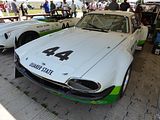
1976 Broadspeed XJ12C – this car made its public debut following an extensive restoration at CarFest North in 2013. This is its first appearance at Goodwood where it promises to make an awesome sight and sound as it tackles the famous hill. It is taking part in the Derek Bell Celebration Class as it was co-driven by Derek and Andy Rouse in the 1976 European Touring Car Championship.
1984 TWR XJS – a regular favourite at Goodwood, this famous car. engineered and driven often by Tom Walkinshaw, won the 1984 European Touring Car Championship including the gruelling Spa 24 hour race. And an example hit 180mph on the famous Conrod Straight at Bathurst.
LAMBORGHINI
It did not take long before Lamborghini produced a racing version of the Huracan, the Super Trofeo, and here it is.
LANCIA
Less well known, perhaps, these days, in comparison to the legendary D50 with its twin pannier tanks, is Lancia’s other out and out racer of the 1950s, the D24, and yet when you realise what a phenomenon the car was in its heyday, it is a shame that it not better known now. Lining up alongside a Talbot Lago 26GS, a fleet of Ferrari’s that included five 375’s, with open Barchetta and closed Coupé Berlinetta bodies, a 340 and a 250MM that were in with a shout for the overall honours in the 1953 Carrera Panamericana were five Lancia’s: two D23’s and three D24 models. Lancia’s programme with the D series race cars was kick started after the 2 litre V6 powered Aurelia B20 GT Coupé driven by Giovanni Bracco and Umberto Maglioli finished second to a 4.1 litre Ferrari 340 America Berlinetta Vignale driven by Luigi Villoresi and Piero Cassani in the 1951 Mille Miglia. In order to go for overall honours, Lancia built a series of D20 Coupés with supercharged 2 litre engines and in 1953 one of these cars driven by Umberto Maglioli won on the tight and twisted roads of the Targa Florio. However the 2 litre supercharged V6 D20’s were not powerful enough to keep up with the competition running larger normally aspirated motors on the comparatively wide open roads used for the Le Mans 24 hours, such as the winning C-Type Jaguar. In response to this, Lancia modified the D20 by replacing the supercharged 2 litre V6 with a normally aspirated 3 litre V6 while Pininfarina fitted the cars, renamed D23’s, with new open bodywork. Simultaneously Lancia also built some all new Pininfarina bodied open top sports racers designed by Vittorio Jano fitted with even larger 3.3 litre V6 engines which became the D24 model. Two D24’s and one D23 were entered for the 1953 Nurburgring 1000kms where Robert Manzon and Piero Taruffi put the D24 on pole, but all three retired. Lancia, like Ferrari, skipped the RAC TT at Dundrod and next lined up for the 1953 Carrera Panamericana road race where the D24 shared by Juan Manuel Fangio and Gino Bronzoni led home D24 mounted team mates Piero Taruffi and Luigi Maggio with the D23 driven by Eugenio Castellotti and Carlo Luoni coming home third ahead of the Ferrari 375MM driven by Guido Mancini and Fabrizio Serena and the Talbot – Lago driven by Louis Rosier. In April 1954 Piero Taruffi and Carlo Luoni drove a D24 to victory on the Giro di Sicilia, in May Alberto Ascari won the 1954 Mille Miglia with a fine solo drive in a Lancia D24, breaking a dominance by Ferrari on the event going back to 1948, and four weeks later Piero Taruffi followed up by driving a D24 to Lancia’s second consecutive win on the Targa Florio. Luigi Villoresi then scored the first of three non championship victories for the D24 at the Circuito do Porto where Eugenio Castellotti came second, Eugenio won at Aosta-Gran San Bernardo before the D24’s final 1954 World Championship appearance at the RAC Tourist Trophy where Juan Manuel Fangio and Piero Taruffi finished 2nd ahead of team mates Robert Manzon and Eugenio. The D24’s final victory was recorded by Eugenio at Firenze-Siena in October 1954 while the model’s final appearance was in the 1960 Buenos Aires 1000kms where Argentinians Camilo Gay and César Rivero qualified their by now well out dated D24 11th before retiring from the race with a transmission problem after competing 4 laps of the 106 lap race. A recreation D24 has been doing the rounds of some of the shows, but this is the real deal, belonging to the Museo Nacionale del’ Automobile, it is chassis #0004, the car which Fangio and Gino Bronzoni drove to victory in the 1953 Carrera Pan Americana and was subsequently used as a training car for by the Lancia team drivers at the Sebring 12 hours in 1954 and is also believed to have been used in some capacity for the 1954 Mille Miglia. Note there are some subtle differences to the offside front wing to when Fangio and Bronzoni drove the car on the Carrera Panamericana. Also note #0004 is showing the rave number 612 which was the number carried by the Meyer / O’Hara Moore Aston Martin DB3 on the Mille Miglia in ’54 for no reason anyone has been able to explain.
During the 60s and 70s, Lancia’s motorsport efforts shifted to rallying, and the brand enjoyed enormous success with the Fulvia, then the Stratos, the world’s first purpose-designed rally car, before the 037 came along in the early 1980s. By 1985 it had become apparent that with the successes being racked up by the latest four wheel drive Audi Sport Quattro and Peugeot 205 Turbo 16 Lancia would have to abandon its supercharged 2 wheel drive Lancia 037 and join the four wheel drive rallying band wagon if it wanted to remain competitive in World Championship Rallying. Over the course of 1985/86 Lancia built 200 Lancia Delta S4 Stradales with CroMo tube frame chassis, covered with epoxy and fibreglass 2 door body panels, vaguely reminiscent of the Lancia Delta 4 door hatch back but hinged in the roof for easy access to the rear. Like the Peugeot Turbo 16 the engine was mounted transversely behind the passenger seat but it was not only supercharged as per Lancia 037 but also turbocharged to improve overall power, while the S4’s four wheel drive system was developed with Hewland. Power output for the engine at 5 bar boost was said to be 1000hp but in Stradale, road spec, 250 hp was deemed sufficient while in Corsa, competition spec between 500hp and 600hp was more likely. The competition version of the S4 made its debut on the RAC Rally in November 1985 and Henri Toivonen with Neil Wilson navigating came home first ahead of team mates Markku Alén and Ilkka Kivimäki. The following season the S4 scored four victories: Monte Carlo for Henri Toivonen and Sergio Cresto, Acropolis for Miki Biasion and Tiziano Siviero with Markku Alén and Ilkka Kivimäki winning the Sanreno and Olympus Rallies. Markku Alén and Lancia might have been crowned World Rally Champions, but that was before the governing body the FIA found that the organisers of the San Remo Rally had been wrong to disqualify the Peugeot team from a commanding lead of the rally for using skirts to aid the handling of their cars and so the FIA had little option but to annul the San Remo results which handed the world titles to Juha Kankkunen and Peugeot. However the season was clouded and the course of rallying was changed after first three spectators were killed and another 30 were injured when a Group B Ford RS200 plunged into a crowd in Portugal and later Henri and Sergio lost their lives after their S4 plunged into a ravine and burst into flames in Corsica.In the aftermath of these events, Group B was cancelled from the end of 1986. Ford curtailed its Rally RS200 programme while Audi immediately withdrew from international rallying completely.
LISTER
Lister came to prominence in the 1950s when they produced a series of racing cars, mostly with Jaguar engines after Jaguar themselves pulled out of motorsport at the end of 1956. The name reappeared in 1993 with the Lister Storm, a homologated racing car built by Lister Cars. The Storm used the largest V12 engine fitted to a production road car since World War II, a 6,996 cc Jaguar unit based on the one used in the Jaguar XJR Sportscars that competed at the 24 Hours of Le Mans. Due to the high US$350,000 price of the vehicle, only four examples were produced before production of the road-going Storm ceased. Only three Storms survive today, although the Lister company continues to maintain racing models. The bored and stroked two-valve Lister V12 produced 546 hp and 582.7 lb·ft of torque. The front-engined rear-wheel drive car weighed 1,664 kg (3,668.5 lb), and was capable of sprinting to 60 mph in just 4.1 seconds. Until the launch of the Brabus Rocket, in 2006, it was the fastest four-seater saloon in the world. The Lister Storm GTS debuted at the 1995 24 Hours of Le Mans as a competitor in the GT1 class, going up against cars such as the McLaren F1 GTR, Ferrari F40, Jaguar XJ220, and Porsche 911 GT2. The car, driven by Geoff Lees, Rupert Keegan, and Dominic Chapell, did not perform well, failing to finish due to gearbox trouble after 40 laps. In 1996, the team decided to give the Storm an early test for Le Mans by entering a lone Storm in the 24 Hours of Daytona but failed to finish. Even with this letdown, the team pushed on towards Le Mans with the Storm GTS. The car was able to improve on its disappointing start by finishing the race in 1996, although the car finished in 19th place, 59 laps behind the winner. Lister decided after Le Mans that they would enter the Storm GTS into the BPR Global GT Series, debuting in the fifth round at the Nürburgring. The car was then entered at the Suzuka 1000km. Every race that the Storm GTS entered for the rest of the season failed to result in a finish. For 1997, Lister realized that the Storm GTS was much too slow in comparison to some of the newer GT1 class competitors, such as the Mercedes-Benz CLK GTR and Porsche 911 GT1. The Storm was therefore redesigned, with a longer and more aerodynamic front end added to the existing car. This car was referred to as the Storm GTL. The car debuted at the 24 Hours of Daytona, where it managed to take 19th place overall and fourth in its class. Later that year, for Le Mans, two new Storm GTLs were entered, but neither of them was able to finish, with both cars out of the race by lap 77. Later in the year, a Storm GTL would travel to the United States to participate in the final two rounds of the FIA GT Championship at Sebring and Laguna Seca. The car failed to finish either race. 1998 saw the team again attempt Daytona, but again they suffered problems early on, and did not finish. With these difficulties, the team was not selected for entry in that year’s 24 Hours of Le Mans, and the team did not compete anymore that year, instead concentrating on redesigning the Storm. For 1999, the Storm reappeared. The car had lost the aerodynamic bodywork seen on the GTL, instead using a more stock front end. The team announced they would participate in the full FIA GT Championship season under the new GT2 class rules. After a poor start, the team managed to take fourth place at Hockenheimring, a mere two laps behind the winning pair of Chrysler Viper GTS-Rs. This was followed by a third place at Zolder, and finally, a second place at Donington, with the Lister finishing a mere 26 seconds behind the winning Viper. These successes brought Lister into a tie for fifth place overall in the teams championship at the season’s end. Going into 2000, Lister was more upbeat about their possibilities. Chrysler-Oreca had officially left the championship, eliminating a challenge from a factory team. Thus, Lister would face competition only from privateers. With this, Lister proved their capabilities by winning the first race of the season at Valencia. Lister would follow this up with four more wins during the season, all claimed by drivers Julian Bailey and Jamie Campbell-Walter. With these victories, Lister claimed the teams championship. At the same time, Lister competed in the British GT championship both as a factory team, as well as with a customer car for Cirtek Motorsport. The two teams were able to take nine victories. Returning as champions to FIA GT, Lister continued into 2001 with two factory cars. Although Lister was able to take four victories over the year, the team had to settle for third in the teams championship, being beaten by Larbre Competition and Carsport Holland’s privateer Vipers. A similar situation occurred in 2002, with Lister managing three victories but only able to take second in the teams championship, again beaten by Larbre. In 2003, Lister was joined in FIA GT with a customer Storm, run by Creation Autosportif. The Lister factory team managed only a single win, yet were still able to take second place in the teams championship. Creation was not far behind, with a fourth place finish in the championship, after gaining a second customer Storm. At the same time, Lister began work on a new project, the Storm LMP which would bring the marque back to Le Mans. This was, therefore, the beginning of the decline of the Storm GT. For 2004, Creation Autosportif would take over as the main competitor in FIA GT, with the factory squad appearing only at selected races. Creation managed to take only eighth in the teams championship after the team decided to move to Le Mans Prototypes as well, while the factory squad was only able to score a single point all season. Lister would continue to attempt to campaign the car into 2005, but were only able to gather enough points for 10th place in the teams championship. Following 2005, the factory officially retired the cars to concentrate on the Storm LMP. In 2006, French squad Red Racing would purchase a Storm for the FFSA GT Championship. The team would make one attempt at the FIA GT Championship, but failed to make it beyond seven laps in the race at Paul Ricard. As of 2007, there were no Storms racing. The car seen here dates from 2000 and is a Storm GT1
LOLA
392
LOTUS
Sole Lotus that I saw was a Type 25, a racing car designed by Colin Chapman for the 1962 Formula One season. It was a revolutionary design, the first fully stressed monocoque chassis to appear in F1. In the hands of Jim Clark it took 14 World Championship Grand Prix wins and propelled him to his 1963 World Championship title. Its last World Championship win was at the 1965 French Grand Prix. An early brainchild of Chapman’s fertile mind, the original sketches for the car were made on napkins while Chapman discussed his idea while dining out with Frank Costin, the designer of the Vanwall, Lotus Mk.8, 9, 10, 11 and Lotus 16 bodies and later of Marcos fame. The monocoque made the car more rigid and structurally stronger than typical F1 cars of the period. The 25 was three times stiffer than the interim 24, while the chassis weighed only half as much. The car also was extremely low and narrow, with a frontal area of 8.0 ft², 0.74m² as compared to the normal 9.5 ft², 0.88 m². It was also envisaged to have a column gear lever, to keep the cockpit width to a minimum, although this was only experimental and discarded. To assist the low profile and low frontal area, the driver reclined sharply behind the wheel (an idea seen in the 18, and pioneered over a decade previously by Gustav Baumm at NSU, leading to the nickname ‘The Bathtub’, while front coil/damper units were moved inboard (as in the 1948 Maserati). The 25 was powered by the Mk.II 1496cc through to the Mk.5 1499cc versions of the Coventry Climax FWMV V8 in crossplane and flatplane formats. Later, Reg Parnell Racing in 1964 fitted BRM P56s of similar specification to their second-hand 25s. Such was the 25’s effect on motor racing, even today’s modern F1 cars follow its basic principles. Some privateers who had been buying Lotus chassis were disgruntled by the fact Chapman refused to provide them 25s. These teams, including Rob Walker Racing, were given Lotus 24s, while the works team had exclusive use of the 25 for Jim Clark and Trevor Taylor. When it first appeared at the Dutch Grand Prix, the futuristic 25 was inspected by John Cooper, who asked Chapman where he had put the frame tubes in the car. Seven cars were built in total, numbered R1 to R7. Four cars – R1, R2, R3 and R5 – were written off (three of them by Trevor Taylor) in accidents between 1962 and 1966. The most successful was R4, which Clark drove to all seven of his World Championship wins in 1963. This car was later crashed by Richard Attwood, rebuilt around a Lotus 33 tub and unofficially known as R13. The car gave Clark his first World Championship Grand Prix victory, at Spa in 1962. He took another win in Britain and again in the USA, which put him in contention for the title, but while leading the final race in South Africa a much publicised engine seizure cost him the title to Graham Hill. Clark gained his revenge the following year, taking his first World Championship in the 25, by winning 7 races, Belgium, France, Holland, Britain, Italy, South Africa, and Mexico. Lotus also won its first constructors’ championship. Following the United States GP, a 25 was taken to the Indianapolis Motor Speedway for evaluation, where they also trialled Lucas electronic ignition for Ford. The results were encouraging enough for Colin Chapman to mount his ultimately successful challenge on the Indianapolis 500. The 25 was again used during the 1964 season, winning a further three races in Clark’s hands. At the final race in Mexico, just as in 1962, the Climax engine developed an oil leak and with literally a lap to run Clark coasted to a halt in sight of world championship victory, this time conceding to John Surtees. Despite the introduction of the Lotus 33 in 1964, the 25 was still used until well into the 1965 season, Clark taking the car’s final win at the 1965 French Grand Prix. In 1964, Reg Parnell Racing began racing the 25, using the BRM P56 V8 engine, with limited success. Piers Courage retired the 25 from its final World Championship race at the 1967 South African Grand Prix.
MAZDA
Mazda were the themed marque for 2015, and accordingly they brought together six cars from their Le Mans and IMSA GT campaigns, many of which had never been seen before in the UK. After the FIA banned rotaries from Le Mans, Mazda focused their racing efforts on the American GTP series with a small operation based in Charlotte, North Carolina
Perhaps the most unusual of these Mazdas was this RX-792P. Mazda had won the IMSA GTO class in 1991 and wanted to step up to the top level so the RX 792-P, designed by Lee Dykstra and Randy Whistle, had a full carbon-fibre bodyshell by Crawford Composites. Although very quick when running, it was not massively successful and caused the Japanese management to cancel the race program at the end of the season, but it was generally considered to be the best looking and best sounding car of 1992 with 770 bhp and 8000 lb of downforce and full ground tunnel effects. Dan Gurney, who was racing the rival Toyota at the time, is alleged to have said that the Mazda was the only car he feared.
The display also featured the 787B, which had won the Le Mans 24 Hours race the previous year. In so doing, it was the first, and so far only, Japanese car to have won the race, and this has given it an almost cult-like status in Japan, were it is referred to as “The One”.
Two generations earlier than this, Mazda had the 757, a prototype racing car built by Mazdaspeed for the 24 Hours of Le Mans running under the IMSA-spec GTP class. It replaced the previous lineage of Group C2 class cars which ended with the 737C and was the first chassis built entirely by Mazdaspeed and designed by Nigel Stroud. The 757 used a new 3-rotor 13G Wankel engine. Two 757s entered the 1986 24 Hours of Le Mans, but both failed to finish the race due to gearbox problems, marking the first time Mazdaspeed had failed to finish at Le Mans. In the All Japan Sports Prototype Championship season, Mazda was able to come home 3rd in the manufacturer’s championship. For 1987, two 757s were again entered, with one finishing 7th overall while the other suffered engine failure. Along with a good result at the joint World Sportscar Championship and All Japan Sports Prototype Championship event at Fuji, Mazdaspeed was able to achieve 10th in the teams championship for WSC and 3rd in the manufacturer’s championship for JSPC. A lone 757 was brought out again for 1988 alongside two newer 767s and was able to beat both 767s to place 15th overall.
Also here was a 767B. Sadly, this car crashed and was quite badly damaged over the weekend, but I was able to see it before this occurred. The 767 replaced the 757 in 1988, upgrading to a newer and larger 4-rotor 13J Wankel engine which produced nearly 600 hp. Two 767s were entered at 1988 24 Hours of Le Mans, finishing 17th and 19th overall, however they finished behind a sole 757 which was able to finish 15th. In the All Japan Sports Prototype Championship, Mazda managed 4th in the constructor’s championship. For 1989, Mazda upgraded the 767 into the 767B, and initially tested it in the IMSA 24 Hours of Daytona, where it was successful in finishing 5th overall. Later in the year, Mazda returned to Le Mans with two 767Bs as well as an older 767. The 767Bs were able to finish 7th and 9th overall, while the lone 767 was able to finish 12th. However, in JSPC, the results were not as promising, as Mazda finished a mere 5th in the championship. For 1990, a single 767B was entered alongside two newer 787s, and was the only car of the three to finish, although in 20th overall.
With a more familiar outline were a couple of RX7 based cars including the ex Pete Halsmer 1990 IMSA GTO-winning RX7 GTO and the earlier design RX7 that took part in the British Touring Car Championship in the early 1980s, where Win Percy lived up to his name when he took overall championship honours with the the Tom Walkinshaw Racing prepared Mazda RX-7. Mazda began racing RX-7s in the IMSA GTO series in 1979. In its first year, RX-7s were placed first and second at the 24 Hours of Daytona, and claimed the GTU series championship. The car continued winning, claiming the GTU championship seven years in a row. The RX-7 took the GTO championship ten years in a row from 1982. In addition to this, a GTX version was developed, named the Mazda RX-7 GTP; this was unsuccessful, and the GTP version of the car was also unsuccessful. The RX-7 has won more IMSA races than any other car model. In the USA SCCA competition RX-7s were raced with great success by Don Kearney in the NE Division and John Finger in the SE Division. Pettit Racing won the GT2 Road Racing Championship in 1998. The car was a 93 Mazda RX-7 street car with only bolt-on accessories. At season end Pettit had 140 points—63 points more than the 2nd place team. This same car finished the Daytona Rolex 24-hour race 4 times.
McLAREN
Team McLaren dominated the 1970 CanAm season by winning nine of ten races. It was their fourth championship in a row. For 1971 a new model, the M8F was built for Denny Hulme, the 1970 CanAm champion and his teammate Peter Revson. The F was based on the M8D but differed in several aspects. The aluminium monocoque chassis was 3-inches longer and employed thicker gauge aluminium panels, flush riveted. Wider 17-inch rims were fitted at the rear necessitating different suspension geometry. Brakes started in-board but were relocated outboard by the Elkhart Lake event. Hewland’s revised Mark II transaxle was employed with stronger case and side plates. The body work was an evolution too with a reshaped nose featuring a narrow inlet to the radiator which became full width at Mid-Ohio. Also new was the door ducting on Denny’s car only which became the Trojan production specification. The fender top fences now extended full length from the rear wing mounts to the tip of the nose, better channeling airflow to the rear wing. A triangular titanium roll bar was unique to the F. Official weight was listed at 1520 pounds. Chevrolet’s big-block power plant was used again, built in house and employing an aluminium block with cast-iron liners. Displacement was 495 cubic-inches producing 740 horsepower at 6400RPM with 655 foot-pounds of torque. Reynolds Aluminium produced its own sleeveless aluminium block enabling larger pistons due to the lack of liners. Displacement was 509 cubic-inches and this power plant was adopted by the team midway through the season. This car is presently fitted with such an engine. Current horsepower is 744 at 5700 RPM although the red line is about 7000 RPM. Maximum torque is 698 at 5300 RPM. Fitted with a Vertex magneto and Lucas/Mackay fuel injection, the engine fires easily and is very loud. McLaren’s engine builder Gary Knutson pioneered a new intake trumpet design featuring staggered trumpets of two different lengths which smoothed out the power curve. They found their way on Team McLaren engines during the 1971 season. This car is chassis M8F-1, one of two Fs built by the McLaren factory. It was built for and used exclusively by Denny Hulme in all ten races of the 1971 CanAm Championship. Hulme won the season opener at Mosport, again at Edmonton and the final race at Riverside. His teammate Peter Revson won five races and the Championship. 1971 was the final year McLaren won the CanAm Championship. By 1972 Porsche’s 917-10 turbocharged racer displaced the M8 series as the dominant car. Even though Team McLaren produced an updated M20 for 1972, it only won twice compared to Porsche’s six victories. Trojan built nine copies of the M8F in 1972, under license from McLaren. These cars were designated M8FPs and lacked ‘works’ features such as stainless steel suspension pick-up points, titanium roll bar and bracketry and custom details only one-off hand built cars possess. In many respects, the M8F represents the pinnacle of McLaren’s CanAm success and the ultimate big banger. At the end of the 1971 season M8F-1 was sold to Greg Young’s All American Racing Team. It was badly crashed by Young at Edmonton in 1972 and ultimately sold at season’s end to the Commander Motor Homes Team in whose possession it was rebuilt. By 1974 Charlie Nearburg owned the car and he installed a small-block Chevy engine. Gary Arnst next owned M8F-1 and completely restored it, installed a correct aluminium big-block Chevy. Then it went to Jim Stollenwerck and in 1987 to George Parlby in Australia and then to Bruce McCaw for whom the current owner acquired it in March of 2002. Duncan Fox of Group 7 Sportscars in New Zealand gave M8F-1 a comprehensive restoration. Duncan and crew did extensive research and returned the car to the configuration in which it raced in during the 1971 season, refitting many original works pieces
The McLaren F1 GTR was a racing variant of the McLaren F1 sports car, first produced in 1995 for grand touring style racing, such as the BPR Global GT Series, FIA GT Championship, JGTC, and British GT Championship. It is most famous for its overall victory at the 1995 24 Hours of Le Mans where it beat out faster purpose-built prototypes. McLaren F1 GTRs raced internationally until 2005 when the final race chassis was retired. Interestingly, this was never planned. Gordon Murray, creator of the McLaren F1, originally saw his creation as the ultimate road car, with no intention to take the car racing. Although the car used many racing technologies and designs, it was felt that the car should be a road car first, without any intent built into the creation of the car to modify it into a racing car. However, soon after the launch of the McLaren F1, the BPR Global GT Series was created. Starting in the 1994 season, the series featured racing modifications of sports cars such as the Venturi 600LM, Ferrari F40, and Porsche 911 Turbo. Viewed as a possible replacement for the defunct World Sportscar Championship, major manufacturers were taking interest in the series. At the same time, teams were also looking for faster and more capable cars for the series top class, GT1. Many teams, such as those run by Ray Bellm and Thomas Bscher, seeing the potential in the McLaren F1 road cars, turned to Gordon Murray in an attempt to convince him to offer factory backing on racing versions for the BPR series. With such a heritage, of racing McLaren were keen to participate. Finally, Murray relented and agreed to modify the F1 into a racing car, with a plan to build several chassis for competition in the 1995 season. An unused F1 chassis which was meant to become #019 was taken by McLaren and extensively modified by the company as a developmental prototype. Because of the similarity to a race car, extensive modification was not needed to actually turn the F1 into a racing car. Bodywork modification saw the addition of various cooling ducts, most noticeably a large one in the centre of the nose and two placed in the location of the storage lockers on the side of the car. A large adjustable downforce wing was added to the back. The interior was merely stripped of all luxuries and given a full racing cage. Carbon brakes replaced the stock units. Because of the rules at the time, the BMW S70 V12 engine was required to use an air restrictor to limit horsepower to around 600 hp, actually making the racing car less powerful than the road car, yet faster and more nimble due to a lowered overall weight. Features such as the central seating position, gull-wing doors, and even the stock gearbox were retained. A total of nine chassis would be built for the 1995 season, with #01R being retained by the factory as a test mule, except for a one-off use by Kokusai Kaihatsu Racing at the 24 Hours of Le Mans. British team GTC Racing received two F1 GTRs, with a third being used to replace a destroyed car. David Price Racing, BBA Competition, Mach One Racing, and Giroix Racing Team would all receive one chassis each, while the final chassis, #09R, was sold to Hassanal Bolkiah, the Sultan of Brunei, for his car collection. At Le Mans 1995, McLaren obtained victory and the highest practice top speed of the year, reaching 381 km/h (236.742 MPH) on the Mulsanne Straight. To keep the cars competitive in the face of new rivals, there were a number of changes made for 1996, and in 1997 the famous Long Tail versions were produced. A total of 28 F1 GTR chassis were built. Nine were built in 1995-spec, nine in 1996-spec, and ten more in 1997-spec. Some cars were upgraded from one spec to another, but this count only includes cars built from scratch to that specification. Following the end of competition for most F1 GTRs in 1998, the various chassis were put to different uses. Some cars, such as the Le Mans-winning chassis #01R, were put on public exhibition at motor shows or in museums. Others were bought by private collectors, either for storage or for use by their owners in historic track day competition, such as the GT90s Revival Series which mainly involved former BPR Global GT Series competitors. A handful of GTRs were not only bought by private owners, but also extensively modified by McLaren to make them street-legal machines. In order to meet regulations, the cars were required to have their ride heights increased, as well as a change from a racing fuel tank and inlet to a more traditional tank and fuel cap. The air restrictor on the engine was also removed, allowing the BMW engines to produce their full potential power. Comforts such as the production car’s sound deadening system, and even sometimes the two passenger seats, were left out of the car. These modified McLaren F1 GTRs are considered the ultimate versions of the road car, since they weigh considerably less than any of the other street cars. The car seen here is the one in which father and son, Derek and Justin Bell achieved that notable 1995 Le Mans victory.
Elsewhere was a GT3 racing version of the current 650S.
MERCEDES-BENZ
Mercedes really worked hard to produce a special display as well, by bringing together 7 of the 8 surviving 1955 SLRs, marking the 60th anniversary of this ultimate racing car from the factory’s final year of official competition, including two Uhlenhaut Coupes, named after team boss Rudolf. Most of these cars belong to Mercedes and are kept at the Mercedes centre in Stuttgart, but chassis number 5 – driven by Juan-Manuel Fangio and Karl Kling – lives in the Schlumpf Collection in Mulhouse.
Chassis number 1 was used for extensive pre-1955 season testing and later for practice on the Mille Miglia, where of course there was no qualifying, but according to Mercedes this car was never raced. Along the side of the car the five one – two victories scored by no.1’s siblings are recorded; the Stirling Moss / Denis Jenkinson partnership beat the solo Jaun Manuel Fangio on the Mille Miglia, Fangio then beat Moss at the Eifelrennen where Karl Kling finished fourth in a third 300 SLR behind a Ferrari 750 Monza driven by Marsten Gregory, Fangio also finished ahead of Moss in the Swedish Grand Prix. Moss partnered by John Fitch beat Fangio and Kling at the Tourist Trophy where Kling was joined by Wolfgang von Trips and André Simon in the third placed 300 SLR, before Moss teamed up with Peter Collins to beat Fangio and Kling again on the Targa Florio where Fitch and Desmond Titterington finished fourth behind the Ferrari 857 S driven by Eugenio Castellotti and Robert Manzon. The one omission from these results being of course the 1955 Le Mans race where the 300 SLR driven by Fangio and Moss was leading the Jaguars by two clear laps when it was withdrawn on the orders of the board of the Mercedes board of directors after parts of the sister car driven by Levegh ploughed into the spectator enclosures killing 82 spectators and injuring 100 more following an accident involving a slower car.
Chassis number 5 has a three race history. It started the 1955 Mille Miglia at 7:01 am with Karl Kling at the wheel who, like Juan Manuel Fangio who started at 6:58, attempted to drive the route solo, however he never made it to the finish of the 1,000 race after crashing out. Juan and Karl drove #5 to a second place finish on the in the Tourist Trophy at Dundrod and according to Mercedes-Benz the same pairing finished second, to chassis #4 driven by Moss and Collins, driving the same car on the Targa Florio where the team secured victory in the 1955 World sports car championship over Ferrari who scored one victory and Jaguar who scored two victories. And the Schlumpf connection? Giovanni, better known as Hans, and Fritz Schlumpf were born in Italy in 1904 and 1906 respectively before their Swiss father. an accountant, and Alsatian mother Jeanne Becker resettled in Mulhouse, Alsace then under German rule. Hans became a banker and Fritz a wool broker before going into business together in 1929 founding SAIL a public limited company in 1935 which began acquiring shares and later a controlling interest, in the Malmerspach spinning mill before managing takeovers of further textile manufacturing businesses On the 28 June 1976 the Schlumpf Brothers had to file for bankruptcy with the loss of 2,000 jobs, just as another Schlumpf pet project was about to come to fruition, unbeknown to the laid off workers. Nine months after the loss of their jobs, members of the CFDT union discovered that the Schlumpf brothers had converted one of their old textile mills in to a 17,000 sq metre museum, due to open shortly after the brothers filed for bankruptcy, containing over 400 vehicles mostly Bugatti’s and only a few other European makes, including this 1955 Mercedes Benz 300 SLR no.5, which were laid out along immaculate gravel avenues of lights separated by tiled walk ways. Naturally the former Schlumpf employees did not take kindly to the appearance of being paid a pittance while the brothers employed a staff including seven assistant mechanics, two upholsterers, two body-work specialists, an assistant body-work specialist and five painters many of whom were former employees of Bugatti, another business based in Mulhouse that had ground to a halt in the 1950’s, to maintain and indeed restore to their former glory so many cars, not all of which were acquired in pristine condition. After occupying the factory and apparently holding the Schlumpf brothers hostage for 3 days, the French Government negotiated the brothers’ exile to Switzerland and declared their Collection of national cultural significance ensuring it would not be broken up nor sold abroad and founded the what today has become La Cité de l’Automobile – National Museum – Schlumpf Collection in Mulhouse with various national and regional private and public bodies eventually reimbursing the brothers and presumably their creditors to the tune of 69 million francs. Just how the Schlumpf brothers managed to acquire 300 SLR no.5 in 1966 remains a mystery, at least one source reckons it was “probably” traded for a fabled W196 Grand Prix car of the same vintage, which only begs the question how did the Schlumpf brother obtain a W196, because Mercede= Benz have been quite meticulous in holding onto their post war racing heritage.
Chassis number 4 is the car that many will have a soft spot for, as this is Sir Stirling Moss’ car in which he won the Mille Miglia. At 7:22 am on the morning of the 1st of May 1955 Stirling Moss and his co-driver Denis Jenkinson sitting in this car, registered W21-6170, were flagged away for the start of the Mille Miglia from Viale Venezia in Brescia with 525 cars ahead of them and just six more to start at one minute intervals behind them. With the aid of course notes recorded on an 18ft roll of paper, edited from their six reconnaissance drives along the entire route, Denis used 15 hand signals to keep Stirling informed of what was coming up ahead over the 1000 mile course via Rome back to Brescia. 10 hours, 7 minutes and 48 seconds later, Stirling and Denis crossed the finish line to record the all time fastest race average speed of 97.96mph over the course which actually measured only 992 miles, and become only the second non Italians to win the event after Rudolf Caracciola and riding mechanic Wilhelm Sebastian won with their Mercedes-Benz SSKL in 1931. Juan Manuel Fangio came home second in the 300 SLR #.3, 31 minutes and 45 seconds behind the winners in one of the greatest solo drives of all time. Stirling Moss then drove #4 to a second place finish behind Fangio in the non-championship Eifelrennen at the Nurburgring before Karl Kling and André Simon were entrusted with the car at Le Mans where it was withdrawn by the board of directors at Mercedes-Benz after the fatal accident that killed team mate Pierre Levegh and 84 spectators. Stirling drove the car to another second place finish in the non-championship Swedish Grand Prix behind team leader Fangio to keep up the model’s remarkable 1-2 finishing record in all events completed. Amazingly Stirling then drove #4 to two more World Championship sports car victories in the RAC TT at Dundrod with John Fitch and in the Targa Florio with Peter Collins so that this car has the rare record of finishing 1st in every World Championship event which it completed. Stirling Moss called this car “the greatest sports racing car ever built — really an unbelievable machine.” and he was able to get back behind the wheel at the Festival.
There were also 2 Uhlenhaut Coupe cars here, chassis numbers 7 and 8. When Mercedes Benz told its drivers of the company’s plans to return to sports car racing in 1955 with a gull wing bodied version of the W196 R Formula One car, the drivers were horrified and objected to the idea of sitting in a closed cockpit behind a Formula One engine because the noise and heat would be difficult to endure over longer races such as the 10 hour Mille Miglia where no driver change was permitted or the Le Mans 24 hours where two drivers were permitted. As a consequence, Chief Engineer Rudolf Uhlenhaut furnished his team with the 300 SLR Roadsters that would become the über successful World Sportscar Championship winning cars during a season in which the most famous win was that of Stirling Moss and his co-driver Denis Jenkinson on the Mille Miglia. During the course of the 1955 season nine 300 SLR’s were built and two of them, chassis numbers 7 and 8 were built with Coupé bodies on the orders of Rudolf. The two Coupés differ in detail with #7 having a squared scoop on the top of the bonnet that does not feature on #8, Number 7 also has a much simpler grille decoration, which possibly backs up Mercedes’ claim that the company was interested in exploring the idea of developing a Gull Wing Coupé for the 1956 season, regardless of the team drivers’ objections, before the companys plans changed in light of the tragedy at Le Mans in 1955. Rudolf Uhlenhaut used chassis number 8 as his personal transport for a while.
This is chassis number 10, and here’s its history. At 07:04 on the 1st of May 1955, Hans Hermann and Hermann Eger set off from the start ramp of the Mille Miglia. However, unlike team mates Stirling Moss and Juan Manuel Fangio, the two Germans never made it to the finish, crashing out before reaching Bologna while in second place over 5 minutes behind Moss and Jenkinson but well ahead of Fangio who was running on only 7 of his 8 cylinders. The car Hans crashed on the Mille Miglia was chassis #6 and its next appearance was at Le Mans where Pierre Levegh and John Fitch were to drive the car. Two hours into the race, Pierre’s Mercedes 300 SLR clipped an errant Austin Healey and was launched into the air which set in motion the greatest disaster in motor racing history as 84 people were killed as parts of the Mercedes scythed through the spectators and the magnesium bodied car went up in flames, Levegh was killed as he was thrown out of the car. The car seen here bearing the #704 start number carried by chassis no.6 on the Mille Miglia is the last of the nine 300 SLR’s to be built, and is said to incorporate improvements in anticipation of the 1956 season which Mercedes-Benz cancelled in the fall out of the disaster at Le Mans. Logic tells us the chassis number should be #9 but for reasons that even Mercedes-Benz are not sure of, the car actually carries the chassis #10. There never was a chassis #9.
Also present were the W196R streamlined racer and W196 chassis number 13
MINI
Stretching the bounds of the term MINI more than a little is this, the 6 foot tall Dakar Rally leviathan known as the MINI Cooper Countryman ALL4 Racing. Apart from a vague likeness to the overall shape of the MINI Cooper Countryman road car developed and sold by BMW and even the MINI John Cooper Works WRC rally car developed by Prodrive, the MINI Cooper Countryman ALL4 Racing has little in common with its street or competition siblings aside from the badges, door handles, windscreen and lights that decorate the carbon fibre body. The chassis for the T1.2 class Rally Raid All 4 Racing is a steel frame designed and constructed by Heggemann Autosport GmbH in Büren not far from Paderborn in Germany. The double wishbone suspension with twin titanium shock absorbers on each corner has 8 inches of travel and the wheels can be changed in three minutes with the aid of the on board jacking system. The T1.2 Rally Raid class is for all wheel drive vehicles powered by diesel engines which in this case takes the form of a 3 litre twin turbocharged 6 cylinder dry sumped motor built for BMW Motoren GmbH by Magna Steyr, that when fitted with the mandatory 1.49 inch air restrictor produces just over 300hp. The roof scoop is for the intercooler fitted behind the driver’s compartment. With a six speed sequential gearbox the All4 racing, that weighs a hefty 2.5 tonnes when fully kitted out with; 400 litres of fuel, three spare tyres, a spare drive shaft kept in a compartment below the floor and everything else mandated for survival and safety, can reach 60mph from rest in six seconds and a top speed of 110mph off road. The whole car is put together and run by the X-Raid Team based in Trebur-Astheim Germany that is owned by Sven Quandt, a member of the family that has the majority stake holding of BMW shares. The team first ran its MINI Cooper Countryman ALL4 Racing cars, which eventually replaced its BMW X3 CC Rally Raid vehicles, in 2011 winning the Abu Dhabi Desert Challenge with Stephane Peterhansel and Baja Portalegre 500 with Filipe Campos. The following year, Stéphane Peterhansel and France Jean-Paul Cottret led home team mates Nani Roma and Michel Périn to win the Dakar Rally with Stéphane going on to win the Baja Spain round of the FIA World Cup Cross Country Rally championship. In 2013 Stéphane won his sixth Dakar Rally driving a car matching the six times he won it on a motorcycle, again with Jean-Paul in the co drivers seat of the winning All4 Racing. Spaniard Joan “Nani” Roma Cararach (Nani Roma) partnered by Frenchman Michel managed to pip the 2012 / 2013 winners the following year when Qatari Nasser Al-Attiyah and Spaniard Lucas Cruz made it an All4 Racing lock out on the podium. In 2015, the 2011 winner Nasser now partnered by Matthieu Baumel steered their All4 Racing to victory on the Dakar. The model’s 4 year dominance on the Dakar was brought to an end by Peugeot with Nasser and Matthieu bringing their All 4 Racing in 2nd behind their former team mates Stéphane and Jean-Paul. In amazing show of strength in depth and reliability in 2013, 11 of these MINI Cooper Countryman All4 Racings, reckoned to cost around € 1 million / US$ 1.4 million each, were entered in the Dakar Rally and all 11 finished inside the top 20.
MIRAGE
The Mirage Lightweight Racing Car was a brand of race cars built by J.W. Automotive Engineereing (JWAE) at Slough, initially to compete in international sports car races in the colours of the Gulf Oil Corporation. The first car was ready for the 1967 season, for which JWAE built and raced the M1, a Sports prototype based on (and looking not unlike) the Ford GT40. The M1 used the standard Ford GT40 V8 engine in various capacities up to 5.7 litres. The highlight of the M1’s short racing career was without doubt the victory by Jacky Ickx and Dick Thompson in chassis M.1003 in the 1967 Spa-Francorchamps 1000 km. New cars followed at quite a rate, with the model numbers incrementing with every new design. It is probably with the GR8, as seen here, that Mirage is now best remembered. The GR8/801 of Derek Bell and Jacky Ickx further added to the teams existing rally of outright victories. At the end of the 1974 racing season, the Gulf Racing Research Company sold its pair of GR7 sports racing cars to Georg Loos and set about developing a pair of brand new ones the coming year. The sole focus of which was to win Le Mans. With that circuit’s all important Mulsanne straight in mind, the GR8 featured a wheelbase 6.1 inch longer than that of its predecessor. The first of the two Len Bailey-designed chassis – GR8/801 – had in fact been completed and tested five times before the end of the 1974 season, fitted with a specially lengthened GR6 body. The first task was therefore to design a fresh more aerodynamic suit of clothes for the new model. The result was tested in the MIRA wind tunnel with dramatic results – a drag coefficient of 0.353 as opposed to the GR7’s 0.531. Things were going well and the second car – GR8/802 – was completed and shaken down in plenty of time for the June race. This Mirage GR8/801 is the car in which in 1975 the team obtained its last victory in the 24 Hours of Le Mans, with the victorious car, being driven by Jacky Ickx and Derek Bell and the other example finishing third with Vern Schuppan and Jean-Pierre Jaussaud. The race was excluded from the World Championship for Makes by the CSI because of new fuel consumption rules introduced for the race in the wake of the oil crisis. The GR8/801 contested Le Mans three times more in various guises but was unable to echo its former glory and was ultimately returned to its race winning Gulf livery before spending a number of years in the Blackhawk Museum. Le Mans winners are rightly prized above almost all other racing cars and Mirage GR8 has more than earned the place at the top table of motor racing history.
MORS
One of the older vehicles present was this Mors Grand Prix car. Émile Mors was born in 1859 into a family whose father Louis was a pioneering electrical engineer who founded an electrical equipment manufacturing business bearing the family name. In 1895 Émile founded his own company bearing the family name to make motor cars, an early strap line for the company appears to have been “Mors ianua vitae” which has a certain double entendre about it meaning either “Mors is the gateway to life” or the more sinister “Death is the gateway to life”. A great believer in competing against the best, in 1901 Mors built a 10 litre V4 engine with side valves and dry sump lubrication that at 950 rpm produced 60 hp for the car that Henri Fournier drove 527 km to win both the 1901 Paris Bordeaux trial by half an hour and the 1105 km Paris to Berlin race which he finished over an hour faster than the rival Panhard et Levassor. Despite a customer base that included the Honorable Charles Stewart Rolls (before he made his acquaintance with Henry Royce) and William K. Vanderbilt Jr,, Émile’s business fell victim to fall out from the failure by F. Augustus Heinze’s United Copper Company to corner the copper market in New York and he had to sell to André Citroën who became chairman of the company in 1908. André decided to try and revive the company’s’ fortunes by building three cars powered by 100hp 12.5 litre motors with overhead push rod actuated valves and minimal brakes for the 1908 French Grand Prix. As is often the case. more haste meant less speed and one of the under-powered cars failed to start while the other two finished 17th and 16th almost 90 minutes behind the winning Mercedes driven by Christian Lautenschlager. The example seen here is believed to be the one driven to the 16th place finish by the bearded Belgian, Camille “Le Diable Rouge” Jenatzy ahead of his team mate known only as Landon, on what proved to be Mors’ final Grand Prix appearance, by 1925 André dropped the Mors name entirely in favour of his own.
MOTOR BIKES
It’s not just about cars here, with a large collection of historic racing bikes in the Paddock as well. I am no expert on these, so simply present an array of pictures to illustrate some of the machinery that could be seen on display and in action.
NAPIER
In 1900 the newspaper magnate James Gordon Bennett, owner of the New York Herald, offered a trophy for a motorcar race for national teams. The annual race was held on the public roads of the previous winning country. A British car won the race in 1902, but since racing on public roads was illegal in England the 1903 race was held in Ireland instead. In honour of the host country the participating Napier racers were painted green, the Irish national colour. Napier continued to use green for their cars from that time on. Mark Mayhew, a well-to-do flour miller from London, entered this 100-hp rated Napier with its 11.1-litre four-cylinder engine in a race in Nice in 1904, where he proved faster than all the participating Mercedes cars, reaching a top speed of 132 km/h; he was beaten only by the Gobron-Brillié cars. That same year Mayhew entered the Napier for the Gordon Bennett Cup, but during the qualification race on the Isle of Man he crashed the car, damaging the front axle. As a result, the car performed badly and failed to qualify. The car was initially selected for the 1905 race but eventually withdrawn in favour of a newer Napier, the ‘Samson’. The 100-hp Napier finally ended up in a barn in the US and did not resurface until 1950, when the collector George Waterman discovered it. These days it lives in the Loumann Collection in Holland.
NISSAN
On a display stand by itself., to one side of the main Paddock was the Nissan GT-R LM Nismo car fresh from competing at Le Mans. Nissan announced early in 2014 that they planned to return to racing at Le Mans and to take on the might of Audi, Porsche and Toyota. When the car they proposed to use was unveiled in an ad break during the American Superbowl, it was very quickly apparent that Nissan had taken a very different tack with its interpretation of the rules. The car is front-engined, using a 3.0-litre twin turbo V6 – not unlike the GT-R road car, where it is claimed to develop about 550bhp – and it is front wheel drive. No, that’s not a typo. Nissan’s 2015 LMP1 car is front-wheel drive. Oh, and rear-wheel drive, too. Because while the fronts have to cope with 550bhp of internally combusted goodness, the rears have to manage somewhere in the region of 700 electrically generated horsepowers. So yes, that’s a total of 1250bhp. Possibly more. The e-drive is a KERS system that harvests energy from the fronts under braking and deploys it out the back under acceleration. Nissan hasn’t said too much about how the energy is stored or deployed, but you can see that the front tyres are much wider than the rears – 14 inches plays 9, due to the manner of weight distribution around the car. Mass has been moved forward, improving traction at the front wheels. Because there is no engine driving the rear wheels, it enabled the designers to come up with a through duct aerodynamic solution, for the air that comes from underneath the front splitter, underneath the nose of the car and all the way through to come out above the diffuser at the back of the car. This is very efficient in terms of low drag so rather than dump the air out sideways – which is why there are all those louvres on the sides of the other LM P1 cars that let the air out from underneath the front of the car to the sides – Nissan don’t do that. Hitting the weight target of 880 kilos when half of the weight of the car is the powertrain was far from easy, and making a car with 1250bhp to push it along, or 1,420bhp per tonne, was clearly going to call for lots of clever technology. Nissan intended to enter two GT-R LM’s in the 2015 FIA World Endurance Championship starting in April 2015,while a third car would be entered for the 24 Hours of Le Mans. The team was based in Indianapolis, Indiana, while the first test of the car took place at Nissan’s testing grounds in Arizona. Later testing took place at the Circuit of the Americas in Austin, Texas Initially planned for a launch in Europe, Nissan North America chose instead to integrate the new car into their Super Bowl commercial, and the film was made during the GT-R LM’s testing at Circuit of the Americas. Former Le Mans winner Marc Gené was the first driver announced for the program, moving to the team from rivals Audi. Harry Tincknell, who won the LMP2 category at Le Mans in 2014, joined former European Le Mans Series champion Olivier Pla and defending Super GT champion Tsugio Matsuda as the next set of drivers. Jann Mardenborough and Lucas Ordóñez, former winners of Nissan’s GT Academy were also announced alongside former FIA GT1 World Champion Michael Krumm. Getting it all to work proved harder than anticipated, so the car did not make its debut until Le Mans, when three of them were entered. One made it all the way through to the Chequered Flag, but a long way behind the winning Porsche 919. Not, on the surface, a glorious return to La Sarthe for the Japanese maker, but one that demonstrates just how brutally tough Le Mans is for a new team. And one, as it turns out, with positives as well as negatives. Not a glorious return to the venue, and definitely not Porsche-rivalling, but Nissan expected as much. The GT-R’s qualifying time was around twenty seconds slower than the fastest Porsche, with pace significantly hindered by the disconnected rear-drive hybrid system, a casualty of the limited development time, Nissan’s already tight schedule, having been further impacted by a failed crash test in March, causing the team to miss the Silverstone and Spa races. As seen in F1’s early dabbles with electric drive, if your hybrid racing car loses its e-power, you’re going nowhere fast. It also puts massive extra strain on the petrol engine and brakes, which have to do without hybrid assistance. Nissan knew it was going to be off the leading pack, so ended up using ed Le Mans to gain as much data as possible instead, like a public test session. There was lots that was positive. Tyre wear, especially on the undriven rears, was very healthy, and bodes well for the car’s balance as soon as it starts kicking out the 1250bhp it was designed to. And despite running front brake temperatures in excess of 1000 degrees – and a fraction of their rivals’ regenerative braking – the pit crew reported brakes were only half-worn when replaced at the intended pit-stops. Plus, fuel consumption was up there with the (albeit faster) leading Audis, Toyotas and Porsches. The science behind the front-engine design does appear to work, but the GT-R needs more time to be finessed before it can go racing at ten-tenths. Car #23 was victim to a clutch niggle that plagued it through the race, but it made it to the dying hour of the event, before Jann Mardenborough was treated to flames from the transmission at the bottom of the Mulsanne straight. Resplendent in crowd-pleasing retro blue livery, car #21 was killed off by a suspension failure in the night, leading to its front-left wheel shearing clean off. Usually cars can limp around to the pits in tripod mode, but the front-drive Nissan started to lunch its engine with the differing axle speeds. That sent the traction control into a tailspin, and power was shut off. The team wasn’t even able to recover its stricken car, left at the mercy of trophy hunters until after the race. So, lots of learning and a brave effort, for sure.
OPEL
The Astra G series Coupé look was used for the V12 powered dedicated racing cars in the DTM series. These DTM racing cars were purpose built race cars with barely any parts taken from the road cars save for lights or door handles. The car’s bodywork featured gull-wing doors that were each supported by two gas struts. The racing cars were powered by 4.0 litre V8 engines with nearly 500 hp. Opel did poorly during several seasons of DTM as only Manuel Reuter placed significantly in the championship once, taking second in the inaugural season 2000. Opel did win the 24h Nürburgring in 2003, though.
PEUGEOT
Making a visit to the UK, away from its home at the Aventure Peugeot museum in Sochaux was this 404 Record Breaker. The Pininfarina styled Peugeot 404 was launched in 1960 and by 1964 it was available with 4 different body styles and a 63hp diesel engine option. In 1965 Peugeot built this single seat 2163 cc 4 cylinder diesel powered 404 prototype to help publicise the capabilities of the at the time relatively under used, outside the commercial vehicle arena, alternative to petrol. In June 1965 Peugeot took the car to Montlhery outside Paris and set a new 5,000 km diesel record by averaging 99 mph. One month later the engine was replaced with a smaller 1,948 cc 4 cylinder diesel and the car was driven at an average speed of 100 mph for 11,000 km around Montlhery, in all the record breaking car captured 40 world diesel records. It was not the only diesel car of the period, surprisingly, as a 1965 group test of diesel powered cars from Peugeot, Mercedes Benz and Austin showed the 63hp diesel Peugeot comfortably out performed its competitors in every area except fuel consumption, at which the Austin A60 Cambridge was the more miserly.
The 405 T16 that took part in rallies such as the famous Paris – Dakar at the end of 1980s is well known, but perhaps less familiar is the version that was developed to take part in the gruelling Pikes Peak, a “race to the clouds”, ascending some 7000 feet in 20 miles of a mix of tarmac and gravel on roads with a sheer drop on either side in places. Success here calls for lots of power and an incredible machine. And that’s what this one is. ‘It’s hard to find the words to describe this car. Stunning! If a rally car can be compared to a 10,000 metre runner and a rally raid car is the equivalent of a marathon runner, then this one is a 100 metre sprinter. It’s on a quite different plane …’ So said none other than the great Ari Vatanen, who so famously blasted this Peugeot 405 T16 up the legendary Colorado Pikes Peak hill to a record time in 1988. The locals, quite understandably, didn’t expect this and reportedly didn’t know what to make of the ‘Poo-Joe’ when it arrived to try to show the establishment a new way to get up the hill in a hurry. By the time it had finished it had successfully changed the game. Vatanen and Peugeot succeeded in great style, although in the interest of fairness the team did turn up with a 600bhp, 900kg (that’ll be 681bhp/tonne then…) missile with four-wheel-drive as well as four-wheel-steering. The car was based largely on the 205 T16 which dominated Group B rallying before becoming one of several high-profile refugees from the series once the infamous regulations were abandoned after 1986. It was then adapted to carry a carbon-kevlar 405 body, and as if to rub salt into the wounds of the cars who’d lost out to it in the rallying world, it went on to win both the Paris-Dakar and Pikes Peak, twice Bear in mind also that, having cleaned up in Group B, Paris-Dakar and then Pikes Peak that the 405 was rebodied as a Citroen ZX and went out and won the Paris-Dakar again. Mr Vatanen again: ‘One thing I’ll remember forever was an occurrence during our preparations in Colorado. We prepared the cars in a workshop in an industrial estate, where it was possible to do a quick roll-out on a closed-off street. Jean Todt sat beside me in the car, but of course there was no passenger seat. The car’s acceleration on tarmac (0-200 in under 10 secs) had made me think that this is how it must feel to be catapulted off the deck of an aircraft carrier! Jean tried to hang on to whatever solid objects he could find inside the car, but when I stamped on the pedal he just disappeared from my peripheral view… getting squashed against the firewall in the back!’
Also included was the current 208 World Rallycross car. This came about in 2014, following the success that Peugeot had the previous year with the help of the mental 208 T16 and Sebastien Loeb, when Peugeot Sport utterly obliterated the Pikes Peak record. So, in a quest for total motorsport domination, the French firm teamed up with Hansen Motorsport to compete in the inaugural season of the FIA’s World Rallycross Championship with the 208 T16 in 2014. It proved to be an excellent decision, as the car performed well. The championship took place over 12 locations ranging from Finland to Turkey, Argentina and Lyddon Hill. The team won the inaugural World Championship in 2014, and decided to come back for more this year.
PLYMOUTH
In Autumn 1968, Richard Petty left the Plymouth NASCAR Racing Team for Ford’s. Charlie Grey, director of the Ford stock car program felt that hiring Petty would send the message that “money rules none”. The Superbird was designed specifically to lure Petty back to Plymouth for the 1970 season with a car developed specifically for NASCAR racing. The Superbird, a modified Road Runner, was Plymouth’s follow-on design to the Charger Daytona fielded by sister company Dodge in the previous season. The Charger 500 version that began the 1969 season was the first American car to be designed aerodynamically using a wind tunnel and computer analysis, and later was modified into the Daytona version with nose and tail. The Superbird’s smoothed-out body and nosecone were further refined from that of the Daytona, and the street version’s retractable headlights (made of fibreglass added nineteen inches to the Road Runner’s original length. The rear wing was mounted on tall vertical struts that put it into less disturbed air thus increasing the efficiency of the downdraft that it placed upon the car’s rear axle. For nearly 30 years the mathematic formula used to determine the exact height of the enormous wing was thought to be a highly guarded Chrysler secret. However, in the 1990s a retired Chrysler project engineer admitted publicly that the height was determined in much simpler fashion: it was designed to provide clearance for the trunklid to open freely. It should be noted that by a co-incidence the height of the wing was at the optimum level for maximum downforce. The rear-facing fender scoops were to hide cut outs. These cutouts were to allow wheel clearance due to the larger, wider wheels and lowered height of the vehicle for NASCAR. On Daytonas, the scoops were actually for ventilating trapped air from the wheel wells in order to reduce under fender air pressure and lift. For standard road going Superbirds the covers or “air extractors” were a cosmetic enhancement, for looks only. Ground clearance was 7.2 inches NASCAR’s homologation requirement demanded that vehicles to be raced must be available to the general public and sold through dealerships in specific minimum numbers. For 1970, NASCAR raised the production requirement from 500 examples to one for every two manufacturer’s dealers in the United States; in the case of Plymouth, that meant having to build 1,920 Superbirds. Due to increasing emissions regulations, combined with insurance hikes for high performance cars and NASCAR’s effective ban on the aero cars, 1970 was its only production year. “Superbird” decals were placed on the outside edges of the spoiler vertical struts featuring a picture of the Road Runner cartoon character holding a racing helmet. A smaller version of the decal appears on the driver side headlight door. Superbirds had three engine options: the 426 Hemi V8 engine producing 425 hp, the 440 Super Commando Six Barrel with three two-barrel carburettors producing 390 hp or the 375 hp 440 Super Commando with a single 4-barrel carburettor. Only 135 models were fitted with the 426 Hemi. As the 440 was less expensive to produce, the “Street” version of the 426 Hemi engine used in competition was homologated by producing the minimum number required. On the street, the nose cone and wing were very distinctive, but the aerodynamic improvements hardly made a difference there or on the drag strip. In fact, the 1970 Road Runner was actually quicker in the quarter mile and standard acceleration tests due to the increased weight of the Superbird’s nose and wing. Only at speeds in excess of 60 mph (97 km/h) did the modifications begin to show any benefit. Chrysler memos of September 1969 show that the Sales Programming staff was preparing to handle 1,920 winged Plymouths for 1970, but published figures say as many as 2,783 were built. The current figure generally accepted is 1,935 SuperBirds built and shipped to United States dealers, with anywhere from 34 to 47 allegedly heading towards Canada. The engine option question is again a sticky one, although the most frequently seen numbers report 135 426ci. Hemi SuperBirds and 716 440ci. Six-Pack editions, with the remainder powered by 440ci. 4bbl. motors. It is believed that over 1,000 Plymouth SuperBirds exist today. Petty did reasonably well against strong Ford opposition on the NASCAR tracks that year, winning eight races and placing well in many more. NASCAR’s rules implemented for the 1971 season limited the “aero-cars” to an engine displacement of no greater than 305 cu in (5 litres) or they had to carry much more weight compared to their competitors. While they were still legal to race, the power-to-weight consequences that would come with the smaller engine or the increased weight rendered the cars uncompetitive. This was the start of a trend of rules slowing down NASCAR, because the races were exceeding the technology of tires and safety over 200 mph. Ford in response also designed the 1970 Torino King Cobra with an aerodynamic, superbird-style nose, but it was abandoned.
PORSCHE
Porsche was at least as well represented in the Paddock as Ferrari, which is hardly surprising, given the marque’s phenomenal heritage in motorsport over many decades. A couple of the cars here were road cars. One of these was a 924 GTS, property of Derek Bell, which he has had since it was new and when he was racing for the team. Just 59 of these GTS models were made by the Stuttgart factory. They are more powerful than the 924 Carrera GT thanks largely to running increased boost and are easily distinguished by the perspex headlamp covers replacing the pop-up headlights on the GT, and an intercooler in front of the engine rather than on top of it. 15 of the 59 were Club Sport cars, which had a roll cage and were even more powerful and lighter than the GTS.
Straddling the list of road and race cars was this 911 Carrera GT1 Evo. With the revival of international sportscar racing in the mid-1990s, though the BPR Global GT Series (which then morphed into the FIA GT Championship) Porsche expressed interest in returning to top level sportscar racing and went about developing its competitor for the GT1 category. Cars in this category were previously heavily modified versions of road cars, usually supercars such as the McLaren F1 and Ferrari F40, but when the 911 GT1 was uneveiled in 1996 Porsche had exploited the rule book to the full and stunned the sportscar fraternity. Rather than develop a race version of one of their road going models, what they created was effectively a purpose built sports-prototype, but in order to comply with regulations a street legal version was created, 911 GT1 Straßenversion – literally a road-going racing car. In spite of its 911 moniker the car actually had very little in common with the 911 of the time, however its frontal chassis was shared with the then 911, the 993, while the rear of the car was derived from the Porsche 962, including its water-cooled, twin-turbocharged and intercooled, four valve per cylinder flat-six engine which was arranged in a mid-mounted position, compared to the rear-engined layout of a conventional 911. The engine was making about 600 PS. In comparison, the 993 generation 911 GT2, which was otherwise the company’s highest-performance vehicle, used an air-cooled engine with only two valves per cylinder. The new vehicle was an outright success at Le Mans, winning the GT1 class at its debut race, although it lost the overall victory to Joest Racing’s Porsche WSC-95 prototype, still a success in that this vehicle used a Porsche powerplant. The 911 GT1 made its debut in the BPR Global GT Series (the FIA championship’s predecessor) at the Brands Hatch 4 hours, where Hans-Joachim Stuck and Thierry Boutsen won comfortably, although they were racing as an invited entry and were thus ineligible for points. They followed up by winning at Spa and Ralf Kelleners and Emmanuel Collard triumphed for the factory team at Zhuhai. The ’96 GT1 had around 600 PS and was clocked at a top speed of exactly 330 km/h (205 mph) on the legendary Mulsanne Straight in the practice sessions of the 1996 Le Mans 24 Hours Race (presumably on a low downforce setup). In 1997, the new Mercedes-Benz CLK-GTR was successful in the new FIA GT Championship that replaced the BPR, as it was developed for racing. Mercedes did not enter Le Mans yet with their new car, though. The Porsche did not prove to be as fast in the FIA series, and failed to win a single race, first against the McLaren F1 GTR, and then against the new CLK-GTR. Towards the end of the 1996 season Porsche made revisions to the 911 GT1 in preparation for the 1997 season. The front end of the car was revised including new bodywork which featured headlamps that previewed the all-new 2nd generation (996) Porsche 911 which would appear in 1997. The revised car was known as the 911 GT1 Evo (or Evolution). The car had the same 600 PS turbo-charged engine, but new aerodynamics on the car allowed the ’97 car to be considerably faster than the 1996 model – acceleration was better, although the top speed was still around 330 km/h on the La Sarthe Circuit (in the race, the GT1-Evo reached 326 km/h). However, the works cars suffered from reliability problems and did not last the full race distance; a privately entered 1996 specification GT1 managed 5th overall and third in its class, but was beaten by the BMW-backed and powered McLaren F1 GTRs.
Also seen here was the LMP1-98 WSC-95, a revised version of the 1997 winner which didn’t manage to finish in the 1998 24 Hours of Le Mans race. Porsche made only two of them. With a turbocharged six-cylinder boxer engine breathing loudly under the bodywork and an open cockpit leaving the driver exposed to the elements, the LMP1-98 is probably one of the most intense driving experiences you could ever get.
Wind the clock back to the end of the 1960s and it was the 917 that was the core of Porsche’s racing program,. The 917 gave Porsche its first overall wins at the 24 Hours of Le Mans in 1970 and 1971. Powered by the Type 912 flat-12 engine of 4.5, 4.9, or 5 litres, the 917/30 Can Am variant was capable of a 0-62 mph time of 2.3 seconds, 0–124 mph in 5.3 seconds, and a top speed of up to 240 mph. This is not, however, representative of the majority of 917s. The highest official speed ever clocked for a 917 at Le Mans is 362 km/h or 224.4 mph. There are at least eleven variants of the 917. The original version had a removable long tail/medium tail with active rear wing flaps, but had considerable handling problems at high speed because of significant rear lift. The handling problems were investigated at a joint test at the Österreichring by the factory engineers and their new race team partners John Wyer Engineering and after exhaustive experimentation by both groups, a shorter, more upswept tail was found to give the car more aerodynamic stability at speed. The changes were quickly adopted into a new version of the 917, called the Kurzheck, or short-tail, with the new version being called the 917K. The 917K, and the special Le Mans long-tail version (called the 917 Langheck, or 917L), dominated the 1970 and 1971 World Sportscar Championships. In 1971, a variant of the 917K appeared with a less upswept tail and vertical fins, and featured the concave rear deck that had proved so effective on the 1970 version of the 917L. The fins kept the clean downforce inducing air on the top of the tail and allowed the angle of the deck to be reduced, reducing the drag in direct proportion. The result was a more attractive looking car that maintained down force for less drag and higher top speed. By this time the original 4.5-litre engine, which had produced around 520 bhp in 1969, had been enlarged through 4.9-litres (600 bhp) to 5-litres and produced a maximum of 630 bhp. The 917K models were generally used for the shorter road courses such as Sebring, Brands Hatch, Monza and Spa-Francorchamps. The big prize for Porsche however, was Le Mans. For the French circuit’s long, high speed straights, the factory developed special long tail bodywork that was designed for minimum drag and thus highest maximum speed. On the car’s debut in 1969, these long-tail (917L) models proved to be nearly uncontrollable as there was so little down force. In fact, they generated aerodynamic lift at the highest speeds. For 1970, an improved version was raced by the factory (although the John Wyer team still preferred the security of the 917K) and for 1971, after very significant development in the wind tunnel, the definitive 917L was raced by both factory and JW. These cars were so stable that the drivers could take their hands off the steering wheel at speeds which reached 246 mph. In 1971 Jo Siffert raced an open-top 917PA Spyder (normally aspirated) in the 1971 CanAm series. There is also the “Pink Pig” aerodynamic research version (917/20), and the turbocharged 917/10 and 917/30 CanAm Spyders. Porsche 917s also raced in the European Interseries in various configurations. In the 1973 Can-Am series, the turbocharged version Porsche 917/30 developed 1,100 bhp. The 917 is one of the most iconic sports racing cars of all time, largely for its high speeds and high power outputs, and was made into a movie star by Steve McQueen in his 1971 film Le Mans. There were a couple of these legends here.
At the end of the 1971 season, the coupe bodied Porsche 917 was no longer eligible to race in the world championship, which saw the German manufacturer’s focus shift to the Group 7 class. In open form the 917 had been campaigned in this virtually no limits class since 1969, but with little factory support. Two championships were open for the Group 7 cars; the European Interserie and more importantly the North American Can-Am Challenge. Big engines, low weight and a host of different looking vehicles had made Can-Am one of America’s premier classes, attracting many spectators. Porsche was represented in Can-Am for a number of years by privateers who race 908s or decapitated 917s, until a purpose built Group 7 version of the 917 made its debut in 1971. Dubbed the 917/10, it was technically similar to the coupe 917, but featured a number of lighter components constructed from the latest exotic materials. A larger fuel tank was also fitted to enable the car to complete the 200 mile races without having to refuel. Completely new was the spyder bodywork, which was an adaptation of the contemporary Can-Am design. A few races into the 1971 season, the Porsche 917/10 made its debut in the McLaren dominated series. It was immediately obvious that the 5 litre flat 12 was not powerful enough to take on the might of the all-alloy Chevrolet V8s, but nonetheless valuable points were scored in the car’s first season. Back in Germany two options to close the gap with the 800 bhp V8s were considered; a 16 cylinder version of the 917 or fitting turbochargers to the existing engine. The second option was by far not as easy as it sounds today, but it was expected to offer the best performance so it was fully explored. Just six of these cars were built, three of which never raced.
Making its UK debut was the 935 that put Paul Newman on the podium at Le Mans in 1979, a race which it nearly won, as all the prototypes, including Porsche’s own 936 had problems in the bad weather. It came down to this car and a Kremer 935, which was in the lead and although Newman was gradually catching it lap-by-lap, he did not quite have enough time to pass it.
Porsche developed the 962 (also known as the 962C in its Group C form) as a replacement for the 956, intended initially mainly to comply with IMSA’s GTP regulations, although it would later compete in the European Group C formula as the 956 had. The 962 was introduced at the end of 1984, from which it quickly became successful through private owners while having a remarkably long-lived career, with some examples still proving competitive into the mid-1990s. When the Porsche 956 was developed in late 1981, the intention of Porsche was to run the car in both the World Sportscar Championship and the North American IMSA GTP Championship. However IMSA GTP regulations differed from Group C and subsequently the 956 was banned in the US series on safety grounds as the driver’s feet were ahead of the front axle centre line. To make the 956 eligible under the new IMSA regulations, Porsche extended the 956’s wheelbase to move the front wheels ahead of the pedal box. A steel roll cage was also integrated into the new aluminium chassis. For an engine, the Porsche 934-derived Type-935 2.8 litre flat-6 was used with air cooling and a single Kühnle, Kopp und Kausch AG K36 turbocharger instead of the twin K27 turbochargers of the Group C 956, as twin-turbo systems were not allowed in IMSA’s GTP class at the time. The newer Andial built 3.2 litre fuel injected flat-6 would be placed in the 962 by the middle of 1985 for IMSA GT, which made the car more competitive against Jaguar. However it would not be until 1986 that the 2.6 litre unit from the 956 was replaced in the World Sportscar Championship, using 2.8 litre, 3.0 litre, and 3.2 litre variants with dual turbochargers. The cars run under World Sportscar Championship regulations were designated as 962C to separate them from their IMSA GTP counterparts.. The 3.2 litre unit, which had been eligible under IMSA’s Group 3 engine rules, was banned by IMSA in 1987. In 1988, to counteract against the factory Nissans and the threat of withdrawal from Porsche teams, water-cooled twin-turbo Porsche engines would be allowed back but with 36 mm restrictors. In total, Porsche would produce 91 962s between 1984 and 1991. 16 were officially used by the factory team, while 75 were sold to customers. Some 956s were rebuilt as 962s, with two being previously written off and four others simply rebuilt. Three 962s that were badly damaged were also rebuilt had been given a new chassis number due to the extensive reconstruction.Due to the high demand for 962 parts, some aluminium chassis were built by Fabcar in the United States before being shipped to Germany for completion. Derek Bell, a 5-time Le Mans winner, drove the 962 to 21 victories between 1985 and 1987, remarking that it was “a fabulous car, but considering how thorough (Norbert) Singer (the designer of the 962 and head of Porsche’s motorsport division at the time) and the team were, it was really quite easy to drive.” Due to the sheer numbers of 962s, some teams took it upon themselves to adapt the car to better suit their needs or to remain competitive. These modifications included new bodywork for better aerodynamic efficiency, while others changed mechanical elements. Long-time Porsche campaigner Joest Racing heavily modified a pair of 962s for the IMSA GTP Championship in 1993 to better compete against Jaguar, taking the 962’s final sprint race victory (Road America) that season. Beyond minor modification, some private teams reengineered the entire car. One noted problem of the 962 was a lack of stiffness in the aluminium chassis, leading some teams to design new chassis, and then buy components from Porsche to complete the car, although some also had unique bodywork as well. Some teams would then offer their 962s to other customer teams. Among the most popular privately built 962s was that from Kremer Racing, termed the 962CK6, which did away with the original aluminium sheet tub of the original Porsche chassis, replacing it with a carbon fibre tub. Eleven were built, campaigned by Kremer and other teams. John Thompson designed a chassis for Brun Motorsport, eight of which were built and helped the team take second in the World Sportscar Championship in 1987. Thompson would later build two chassis for Obermaier Racing. Richard Lloyd Racing’s GTI Engineering would turn to Peter Stevens and Nigel Stroud to develop four 962C GTis, which featured entirely revised aero and aluminium honeycomb rather than sheet tubs. Former factory Porsche driver Vern Schuppan would also build five new chassis, some known as TS962s. In the United States, the ball got rolling when Holbert Racing began making modifications to their own chassis and rebadging them with “962 HR-” serial numbers. The search was always on for a stiffer and safer 962 monocoque and Jim Busby contracted Jim Chapman to build a more robust version of the 962 monocoque. Fabcar would become the de facto factory tub supplier, supplying chassis with official Porsche serial numbers. Fabcar incorporated changes to the factory tub, replacing the simple sheet aluminum construction with a combination of sheet aluminum and aluminum honeycomb in addition to billet aluminum bulkheads. These changes substantially increased the tub’s crashworthiness and stiffness. Dyson Racing purchased a Richard Lloyd Racing/GTi Engineering 962 monocoque for use in their Porsche 962 DR-1 chassis. A Fabcar tub was used in Dyson’s Porsche 962 DR-2.. Some 962s were even more extensively modified, with several open-cockpit versions being developed in the mid-1990s to run under new sportscar regulations. Kremer Racing would once again develop their own chassis, with the open-cockpit CK7 running in Interserie and K8 running at most international sportscar races, including Le Mans and Daytona. These cars shared little with the original 962s, using custom bodywork and chassis designs, yet retaining the engine and some suspension elements. Heinz-Jörgen Dahmen converted his 962 (chassis 009) to an open-top version that was raced by him in the Interserie in 1995 and 1996. The car had previously been campaigned by him in the Interserie since 1990. Porsche debuted the 962 at the 1984 24 Hours of Daytona with Mario and Michael Andretti driving the factory car which led the race until it retired during lap 127 with engine and gearbox problems. For 1985, the 962C would debut in the World Sportscar Championship, but ironically the car lost to an older 956, which had already taken WEC top-honors four times. Under pressure from new cars from Jaguar and Mercedes-Benz, in 1987 Porsche again brought in a new engine, a more durable and powerful 3.0 litre unit which powered the car to an overall win at the 1987 24 Hours of Le Mans, Porsche’s record seventh consecutive victory at the race. After a post-’87 “dry spell”, Porsche customer Jochen Dauer got the 962 re-classified as a road legal GT1 car under a loophole in the new ACO regulations for the 1994 24 Hours of Le Mans. During the early years of its career, the 962, like the 917K, 935 and 956 before it, became one of the most dominant cars in motorsport, and its efficiency and reliability led it to be a car much in demand among private teams. The championships won by teams campaigning the 962 included the World Sportscar Championship title in 1985 and 1986, the IMSA GT Championship every year from 1985 to 1988, the Interserie championship from 1987 until 1992, all four years of the Supercup series (1986 to 1989), and the All Japan Sports Prototype Championship from 1985 until 1989, and it was also very dominant in the American IMSA series well into the 90’s. The 962 also won the 24 Hours of Le Mans in 1986 and 1987, with Derek Bell, Al Holbert and Hans-Joachim Stuck at the wheel on both occasions, as well as later winning under the Dauer 962 badge in 1994. The presence of strong factory teams, such as Jaguar, Mercedes-Benz, Nissan, and Toyota, competing against privateer 962s eventually led to the car becoming less successful in the later 1980s. Even though they struggled, 962s would continue to win races into 1993, taking lone victories in the IMSA GT and Interserie seasons. Although Dauer’s Le Mans victory in 1994 featured a highly modified car, Team Taisan would take the final victory ever in an original 962C, winning an All Japan Grand Touring Car Championship event at Fuji Speedway in August of that year, just over ten years after the car had debuted.
Final Porsche on show here was a 997 generation version of the 911, a car which has had a motorsport career throughout its 52 year life.
RED BULL
Shown on the Red Bull stand was the Red Bull X2010. Originally named Red Bull X1, this is a fictional prototype vehicle featured in the PlayStation 3 video game Gran Turismo 5. It reappeared in Gran Turismo 6. This digital creation was a response to Kazunori Yamauchi’s question: “If you built the fastest racing car on land, one that throws aside all rules and regulations, what would that car look like, how would it perform, and how would it feel to drive?”. The Prototype was designed by Red Bull Racing Chief Technical Officer Adrian Newey in conjunction with Yamauchi. It features enclosed wheels, and a “fan element” to increase low and medium-speed downforce much like a Chaparral 2J or Brabham BT46B. The hypothetical car, conceived as an ultimate racing machine, was designed with pure speed in mind, rather than to regulations. It is theoretically superior to a Formula One car in terms of speed and handling. Initially the concept of the X2010 was based on a low air resistance, single seater covered wheel prototype, a wing car powered by a forced induction engine producing 1479 hp, aiming to achieve a top speed of over 470 km/h (292 mph) and a maximum lateral G-force of 6G. Upon seeing the machine’s concept and design model, Newey proposed the addition of fan car technology, a long-time dream held as a racing designer. The benefit of a fan car is that it pulls air out from underneath the car, creating an area of comparatively lower pressure. This difference in pressure above and below the car presses it towards the ground, producing downforce. The fan principle allows the X2010 to maintain a high cornering speed in low speed corners. After the evaluation of the technology going into the car, the X2010 was redesigned incorporating refinement advice from Newey. With its low air resistance achieved through its smooth glass canopy and full cowling over the tyres, and the downforce gained from the low speed range using the fans as well as in the high speed range through the front and rear wings and the rear diffuser, the car ultimately achieved a theoretical maximum speed of 500 km/h, a weight of 545 kg, and a maximum lateral G force exceeding 8G. This spec is virtually at the very limit of what a normal human body can withstand.[citation needed] Modern fighter jets are usually electronically limited to 9G. The driver who performed the virtual shakedown test of the car was Red Bull Racing driver Sebastian Vettel. On his first run, he shortened the simulated course record held by Formula 1 cars on GT5’s simulation of the Suzuka Circuit by over 20 seconds, drawing out the theoretical potential of the X2010 machine. Due to its great speed and cornering, possession of the car makes simulator progress much easier, and because of this, it became a much sought after model soon after Gran Turismo 5’s release. In the United States, virtual copies of the car were on sale on the auction website eBay for $250. The version 2.0 update to Gran Turismo 5 features an updated version of the car, the X2011, featuring a larger rear wing and a higher top speed. Updated versions of the car, the X2014, with and without fan technology, appear in Gran Turismo 6.
RENAULT
Renault always bring over an interesting variety of historic cars from their “Histoire et Collection” fleet, a large collection of models that are not usually on public display. Some of the cars were ones I’ve seen before, but there were a few which I have not.
Oldest of the Renaults on show was this 1904 Model K Racer. After giving a demonstration to a friend of his father on the 24th of December 1898, aspiring engineer Louis Renault sold his first 1hp Voiturette and founded Société Renault Frères with his brothers Marcel and Fernand, who were experienced at running their fathers textile business. Like many, Renault recognised the “win on Sunday, sell on Monday” benefits of competing in the popular City to City races of the age and both Louis and Marcel would prove their company’s products in such events. Renault has recently recreated the nimble lightweight, 600 kg Type K seen here as a tribute to the car that Marcel Renault drove in the 1902 Paris to Vienna road race in which he beat far more powerful opposition from Mercedes and Panhard to traverse the 800 mile often narrow steep alpine route at an average speed of 38 mph. The car was powered by a 30hp 5 litre 4 cylinder engine.
I’ve seen this amazing looking device a number of times before. With its pillar-box style windscreen, it must be more than mildly terrifying to drive! It is a Renault 40CV, which was launched in 1911 powered by a 7.6 litre straight six and was available with either an 11′ 9″ or a 12′ 9″ chassis. With the introduction of the 40CV Type HF in August 1920, the engine was upgraded to a 9.1-litre straight six. From 1920 to 1928, the Renault 40CV replaced the Panhard 20CV as the French Presidential vehicle of choice. François Repusseau drove a 40CV to victory in the 1925 Monte Carlo Rally and the following year a vehicle similar to this 40CV MN was modified and fitted with a single seat Coupé body and taken to the Montlhéry Oval outside Paris for a record breaking 24 hour run. Facilitated by a pit crew of 14 who could complete a pit stop including changing all four tyres in 50 seconds every hour and a team of unnamed drivers, the 40CV set a new 50 mile average speed record of 118 mph and a 24 hour record of 107.9 mph. By comparison, the fastest average speed on the road course at Le Mans for the 24 hours race in 1926 was just 66 mph set by Robert Bloch and André Rossignol in their 3.4 litre Lorraine-Dietrich B3-6. This is not the original car, but an exact replica.
This R17 Rally car, a machine I’ve not seen before, was the first Renault, as opposed to a Renault Alpine, to win a championship rally, la Ronde de la 1eme Terra, in 1974. It was built to Group 5 specifications, the category ultimately replaced by Group B, and fitted with a very special 16 valve engine from a Formula Renault race car, a 186 bhp Type 64. Only four were made before it was replaced by the next car in the Renault paddock.
This R5 Maxi Turbo dates from 1985.
Renault entered Formula 1 in 1977 and have been present in one way or another more or less ever since. Seen here were a trio of cars: oldest was Rene Arnoux’ RS10 from 1979 in which he had many a battle against the late Gilles Villeneuve in his Ferrari 312 T4, notably the scrap for second place in the closing stages of the French Grand Prix that year. Also on display was an RE40 from 1983 and an R25 from 2005.
RENAULT-ALPINE
Although my camera failed to record the fact, in celebration of the 60th anniversary of Renault-Alpine, there was quite an array of historic models here, of which the best known was this A110.
Also present were the earlier A106, as well as one of the rare Argentinian Interlagos models, but all others seem to have eluded the camera apart from this 1965 M65. A purpose-built sports prototype, the M65 was developed during a golden era of endurance racing that encouraged cars of all shapes and engine sizes, which would then be judged against one another in the “Index of Performance”: a kind of handicap system that acknowledged and rewarded the best combination of efficiency and raw speed. Powered by a 1,296cc Gordini-tuned four-cylinder engine developed from the 1,100cc unit found in the squared-off tail of the Renault 8 Gordini, the M65 has just 130bhp. That sounds rather feeble by today’s standards, but weighing just 669kg and blessed with dart-like aerodynamics the little Alpine was born for the sustained high speeds of Le Mans. Running a light fuel load to see just how fast it would go, the M65 touched 164mph along the pre-chicane 4.3-mile Mulsanne straight, matching the considerably more potent Porsche Carrera 6s. Even on today’s chicane-punctuated Mulsanne it will touch 140mph between the braking points. This particular car is chassis 1719, now owned by Renault Classic. It raced at Le Mans in period, but suffered bad luck, retiring from the 1965 24 Hours after three hours. It retired the following year, too, this time in the 20th hour, though its sister car went on to take a glorious victory in the 1,300c class. Despite its Le Mans curse, 1719 made a significant contribution to Alpine’s racing success, tasting champagne in the 1965 Reims 12 Hours by finishing first in the 1,300cc class, then taking a sensational overall victory in the Nürburgring 500km race two months later.
ROVER
As a touring car the SD1 Vitesse won the BTCC in the hands of Andy Rouse in 1984 and came close to winning the ETCC in subsequent years, but the history of the car is a complex and muddied one, much like the entire British car industry of the late 1970s. The production Rover 3500 was finally launched in July 1976, to critical acclaim. This futuristic looking executive machine was the “must have” car of that summer, whose appeal was widened when cheaper versions with new 2300 and 2600cc engines were added to the range in the autumn of 1977. Sadly, by this time, the car’s reputation for patchy reliability and uneven paint finishes from the purpose–built factory that made the car had started to circulate. BL, and later Austin-Rover tried hard to improve matters, launching a revised model in early 1982, with a greater choice of engines, but it was later that year when the respected 3.5 litre V8 engine received fuel injection to create the 190 bhp Vitesse when the car started to become truly desirable again. This model then formed the basis for a return to motorsport for Austin-Rover. Entrusted to TWR, the Vitesse made its ETCC debut at the Donington 500 in May 1983, with Steve Soper and Jeff Allam finishing in ninth position. A first win came in wet conditions at the Tourist Trophy at Silverstone in September with Soper and René Metge at the wheel. The following year there were no victories in the European series as Jaguar dominated, but Andy Rouse won the BTCC in his Vitesse, securing the middle of his hattrick of titles. Even a title win wasn’t straightforward for British Leyland however. Rouse was in a privateer Rover, with the works team withdrawing mid-season in protest at a High Court decision to strip them team of their 1983 title, because of a protest from BMW that the Vitesse’s were equipped with oversized, Volvo, wheel arches! There was success on the continent too, as Kurt Thiim won the DTM in his Nickel Racing Vitesse. Rover opened 1985 with a 1-2-3 at Monza, going on to win the opening three rounds, but TWR lost out on the title to the Eggenberger Volvo, although six victories were some recompense. They did win the title in 1986, or at least lay claim to that title for a few weeks before FISA remembered their rule changes and took the title away from Win Percy to give to Roberto Ravaglia. At the end of the season Rover, alongside Volvo, withdrew, meaning that much like its road going counterpart, the Vitesse came perilously close to being a resounding success on the track, but circumstances (in the form of regulations rather than industrial disputes) hampered the car and prevented it from reaching its true level. 1986 saw the end of SD1 production too, as modern cars surpassed the 1970s design, with Rover bringing out the 800 as a replacement model, a car which never went anywhere near motorsport.
SUBARU
This 780 bhp Impreza was driven by Olly Clark, son of rally legend Roger, to a fastest time on the Sunday, of 44.91 seconds.
SURTEES
The Surtees TS7 was a Formula One car used by John Surtees during the 1970 and 1971 Formula One season. It was designed by John Surtees, Shahab Ahmed and Peter Connew. The car made its debut at the 1970 British Grand Prix with Surtees driving. He qualified 19th and retired with an oil pressure failure. In Germany, Surtees qualified 15th and was classified in ninth, although his race ended in an engine failure. The Austrian Grand Prix saw Surtees qualify 12th and retire when his engine blew. In Italy the Englishman qualified 10th and retired when an electrical failure stalled the car at the start. The Canadian Grand Prix saw Surtees qualify and finish fifth. The team owner was joined by Derek Bell as a driver for the United States Grand Prix. Surtees qualified eighth and Bell 13th. The 1964 World Champion retired when his engine blew and Bell finished sixth. In Mexico the team only entered Surtees. He qualified 15th and finished eighth. The 1971 South African Grand Prix saw Team Surtees enter Surtees in the Surtees TS9, and Brian Redman and Rolf Stommelen in TS7s, The Stommelen qualified 15th and the Redman qualified 17th. Stommelen finished 12th and Redman seventh. Following this race the team elected to concentrate on the TS9 car.
TALBOT
1948 Talbot Lago T26 Grand Sport Coupe
TOYOTA
With a profile looking like not too distant a relative of the road-going car, this Celica Pike Peaks special boasted 850 bhp, which was enough In 1994 for the car to win the “Race to the Clouds, Pikes Peak, with a record time of 10:04.060, some 40 seconds faster than the previous record holder, Nobuhiro Tajima’s equally insane Suzuki Swift.
This is a Tundra Truck like you’ve probably not seen before!
There were a couple of NASCAR Camry models here, dating from 2013 and 2014. The name is about all that these purpose-designed racers have in common with the best selling passenger car in America.
TRIUMPH
The Dolomite Sprint was campaigned in the British Touring Car Championship from 1974 to 1978. It met with some success, with Andy Rouse winning the Drivers’ Championship in 1975, and also lifting the manufacturer’s title in 1974 with team mate Tony Dron. The Sprint driven by Andy Rouse and Tony Dron managed fifth overall in the Spa 24 hours race in July 1974. In September Dron managed 3rd place overall in a Sprint competing in the RAC Tourist Trophy race of that year. In 1975 Andy Rouse won the British Touring Car Championship outright by taking the driver’s title in a Sprint. In 1976 Broadspeed only ran one Dolomite Sprint in British Saloon Car Championship, with Rouse finishing second in the two litre class. 1977 saw the departure of Rouse and the return of Tony Dron as driver of the Broadspeed prepared Dolomite Sprint. Dron managed to win no less than seven of the twelve races outright against some stiff competition, and narrowly missed out on winning the championship outright because of tyre failure on the final race when leading his class by over a minute. In 1978 Broadspeed entered a sole Dolomite Sprint (driven by Tony Dron) where it won only one race outright, although the Sprint still won class B in the last year a factory entered Sprint would compete in the British Saloon Car Championship. Seen here were an Andy Rouse and an ex Derek Bell car.
VOLKSWAGEN
This may look like a Beetle (of sorts), but in fact this 1975/76 “supersaloon” is more of a Chevrolet than a Volkswagen, with just the outline of the German car there to make us think Beetle. An enthusiast’s favourite ever since its creation in 1976, this car is comprised of a custom spaceframe chassis with predominantly March Formula 5000 suspension and of course the ubiquitous Chevrolet V8 fitted, with a Beetle cockpit. In-period it had little trouble winning a hatful of Super Saloon races and nowadays it runs a slightly larger version of the Chevy V8… probably because 500bhp in something so light just wasn’t quite cutting it!
This was an excellent day. The entrance ticket may not have been free, but at the discounted rate for which I bought it, I still think it was a bargain, as there was far more to see than you could possibly fit into a single day. The solution will have to be to brave the crowds and stay on for the Festival of Speed. Perhaps I will manage to do that in 2016.


